Painted with Words: Vincent van Gogh's Letters to Émile Bernard
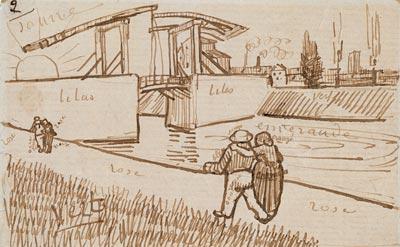
Painted with Words is a compelling look at Vincent van Gogh's correspondence to his young colleague Émile Bernard between 1887 and 1889. Van Gogh's words and sketches reveal his thoughts about art and life and communicate his groundbreaking work in Arles to his fellow painter.
Van Gogh's letters to Bernard reveal the tenor of their relationship. Van Gogh assumed the role of an older, wiser brother, offering praise or criticism of Bernard's paintings, drawings, and poems. At the same time the letters chronicle van Gogh's own struggles, as he reached his artistic maturity in isolation in Arles and St. Rémy. Throughout the letters are no less than twelve sketches by van Gogh meant to provide Bernard with an idea of his work in progress, including studies related to the paintings The Langlois Bridge, Houses at Saintes-Maries-de-la-Mer, Boats on the beach at Saintes-Maries, The Sower, and View of Arles at Sunset.
The translations used in this presentation are from the catalogue for the exhibition: Vincent van Gogh Painted with Words, The Letters to Émile Bernard and are reproduced by kind permission of the Van Gogh Museum, Amsterdam.
Hear our Director Colin B. Bailey explain why these are some of the most moving and precious objects in our collection:
Major support for Painted with Words: Vincent van Gogh's Letters to Émile Bernard and its accompanying catalogue was provided by the International Music and Art Foundation. Generous support was also provided by the Robert Lehman Foundation and the National Endowment for the Arts. 
Thumbnails
Letter 1, page 1
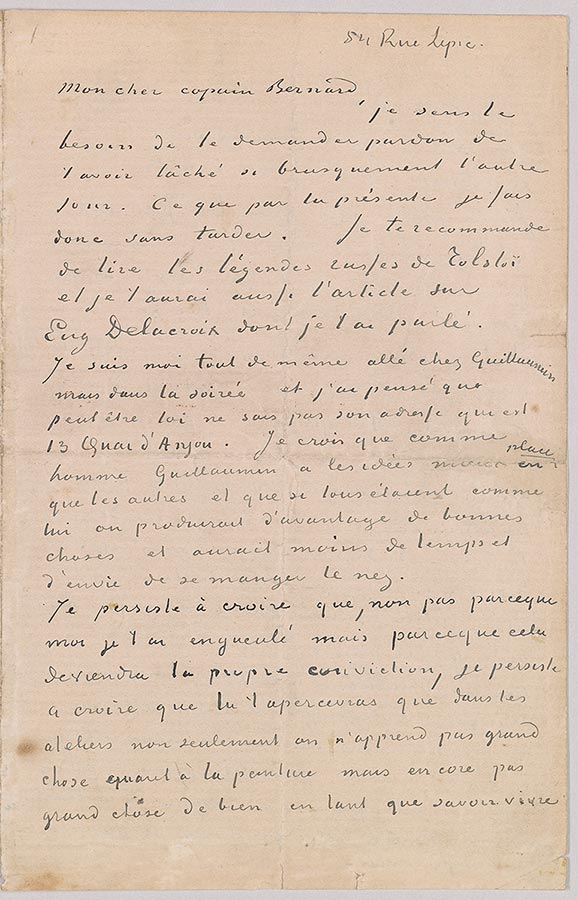
Vincent van Gogh, letter to Émile Bernard, Paris, ca. December 1887, Letter 1, page 1
Thaw Collection, given in honor of Charles E. Pierce, Jr., 2007
54 rue Lepic.
My dear old Bernard,
I feel the need to beg your pardon for leaving you so abruptly the other day. Which I therefore do
herewith, without delay. I recommend that you read Tolstoy's Les Légendes Russes, and I'll also let
you have the article on E. Delacroix that I've spoken to you about.
I, for my part, did go to Guillaumin's anyway, but in the evening, and I thought that perhaps
you didn't know his address, which is 13 quai d'Anjou. I believe that, as a man, Guillaumin has
sounder ideas than the others, and that if we were all like him we'd produce more good things and
would have less time and inclination to be at each other's throats.
I persist in believing that—not because I gave you a rocket but because it will become your
own conviction—I persist in believing that you'll realize that in the studios not only does one not
learn very much as far as painting goes, but not much that's good in terms of savoir vivre, either.
© 2007 Van Gogh Museum, Amsterdam
Letter 1, page 2
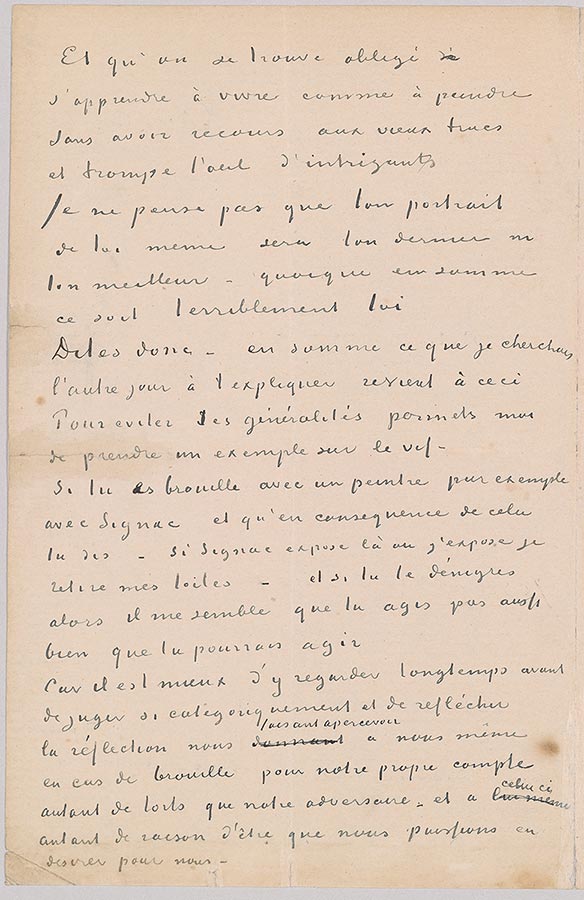
Vincent van Gogh, letter to Émile Bernard,Paris, ca. December 1887, Letter 1, page 2
Thaw Collection, given in honor of Charles E. Pierce, Jr., 2007
And that one finds oneself obliged to learn to live, as one does to paint, without resorting to the old
tricks and trompe l'oeil of schemers.
I don't think your portrait of yourself will be your last, or your best—although all in all it is
frightfully you.
Look here—briefly, what I was trying to explain to you the other day comes down to this.
In order to avoid generalities, let me take an example from life.
If you've fallen out with a painter, with Signac, for example, and if as a result you say:
I'll withdraw my canvases if Signac exhibits where I exhibit—and if you run him down, then it
seems to me that you are not behaving as well as you could.
Because it's better to take a long look at it before judging so categorically and to reflect,
reflection making us see in ourselves, when there's a falling out, as many faults on our own side
as in our adversary, and in him as many justifications as we might
© 2007 Van Gogh Museum, Amsterdam
Letter 1, page 3
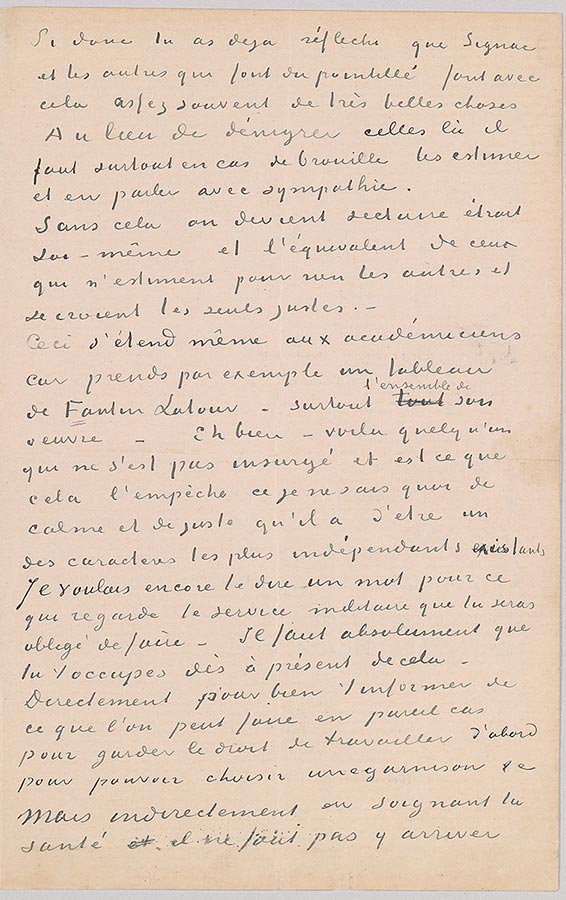
Vincent van Gogh, letter to Émile Bernard,Paris, ca. December 1887, Letter 1, page 3
Thaw Collection, given in honor of Charles E. Pierce, Jr., 2007
desire for ourselves.
If, therefore, you have already considered that Signac and the others who are doing pointillism
often make very beautiful things with it—
Instead of running those things down, one should respect them and speak of them sympathetically,
especially when there's a falling out.
Otherwise one becomes a narrow sectarian oneself and the equivalent of those who think
nothing of others and believe themselves to be the only righteous ones.
This extends even to the academicians, because take, for example, a painting by Fantin-Latour
—and above all his entire oeuvre. Well then—there's someone who hasn't rebelled, and does that
prevent him, that indefinable calm and righteousness that he has, being one of the most independent
characters in existence?
I also wanted to say a word to you about the military service that you will be required to do.
You must absolutely see to that now.
Directly, in order to inform yourself properly about what one can do in such an event; first to
retain the right to work, to be able to choose a garrison, etc. But indirectly, by taking care of your
health. You mustn't arrive there
© 2007 Van Gogh Museum, Amsterdam
Letter 1, page 4
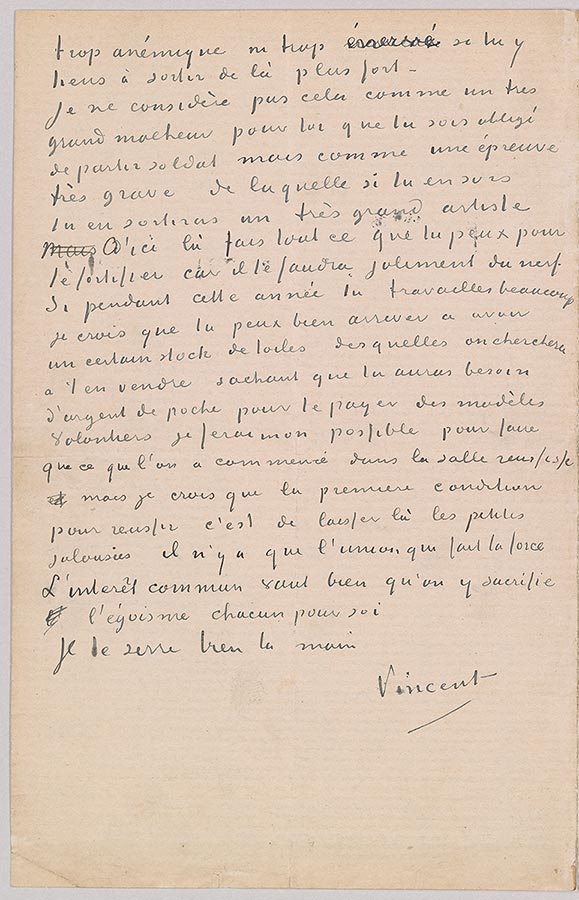
Vincent van Gogh, letter to Émile Bernard,Paris, ca. December 1887, Letter 1, page 4
Thaw Collection, given in honor of Charles E. Pierce, Jr., 2007
too anemic or too agitated if you want to emerge from it stronger.
I do not see it as a very great misfortune for you that you have to join the army but as a very
grave ordeal, from which, if you emerge from it, you'll emerge a very great artist. Until then, do all
you can to build yourself up, because you'll need quite a bit of spirit. If you work hard that year, I
believe that you may well succeed in having a fair stock of canvases, some of which we'll try to sell
for you, knowing that you'll need pocket money to pay for models.
I 'll gladly do all I can to make a success of what was started in the dining room, but I believe
that the first condition for success is to put aside petty jealousies; it's only unity that makes
strength. It's well worth sacrificing selfishness, the "each man for himself," in the common interest.
I shake your hand firmly.
Vincent
© 2007 Van Gogh Museum, Amsterdam
Letter 2, page 1

Vincent van Gogh, letter to Émile Bernard, Arles, 18 March 1888, Letter 2, page 1
Drawbridge with walking couple
Thaw Collection, given in honor of Charles E. Pierce, Jr., 2007
My dear Bernard,
Having promised to write to you, I want to begin by telling you that this part of the world seems to
me as beautiful as Japan for the limpidity of the atmosphere and the gay color effects. The stretches
of water make patches of a beautiful emerald and a rich blue in the landscapes, as we see it in the
Japanese prints. Pale orange sunsets making the fields look blue—glorious yellow suns. So far,
however, I've hardly seen this part of the world in its usual summer splendor. The women's costume
is pretty, and especially on the boulevard on Sunday you see some very naive and well-chosen
arrangements of color. And that, too, will doubtless get even livelier in summer.
© 2007 Van Gogh Museum, Amsterdam
Letter 2, page 2
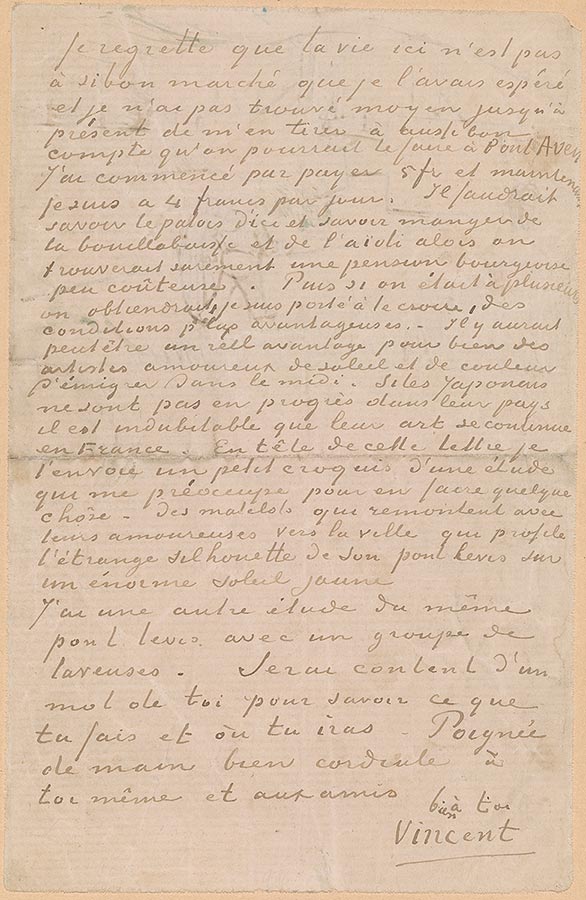
Vincent van Gogh, letter to Émile Bernard, Arles, 18 March 1888, Letter 2, page 2
Thaw Collection, given in honor of Charles E. Pierce, Jr., 2007
I regret that living here isn't as cheap as I'd hoped, and until now I haven't found a way of getting
by as easily as one could in Pont-Aven. I started out paying 5 francs and now I'm on 4 francs
a day. One would need to know the local patois, and know how to eat bouillabaisse and aioli, then
one would surely find an inexpensive family boardinghouse. Then if there were several of us, I'm
inclined to believe we would get more favorable terms. Perhaps there would be a real advantage in
emigrating to the south for many artists in love with sunshine and color. The Japanese may not be
making progress in their country, but there is no doubt that their art is being carried on in France.
At the top of this letter I am sending you a little sketch of a study that is preoccupying me as to
how to make something of it—sailors coming back with their sweethearts toward the town, which
projects the strange silhouette of its drawbridge against a huge yellow sun.
I have another study of the same drawbridge with a group of washerwomen. Shall be happy to
have a line from you to know what you're doing and where you're going to go. A very warm handshake
to you and the friends.
Yours,
Vincent
© 2007 Van Gogh Museum, Amsterdam
Letter 3, page 1
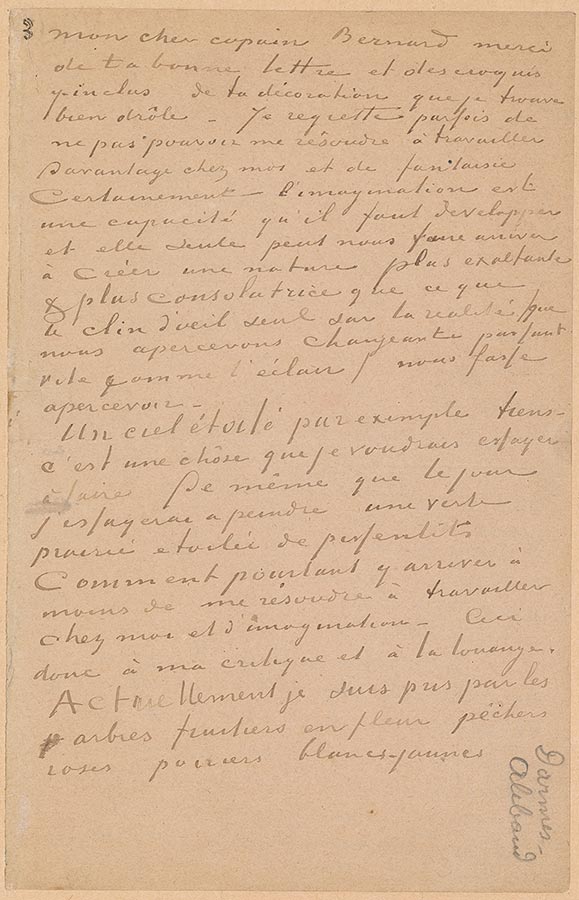
Vincent van Gogh, letter to Émile Bernard, Arles, 12 April 1888, Letter 3, page 1
Thaw Collection, given in honor of Charles E. Pierce, Jr., 2007
My dear old Bernard,
Thanks for your kind letter and the sketch of your decoration included with it, which I find really
amusing. I sometimes regret that I can't decide to work more at home and from the imagination.
Certainly—imagination is a capacity that must be developed, and only that enables us to create a
more exalting and consoling nature than what just a glance at reality (which we perceive changing,
passing quickly like lightning) allows us to perceive.
A starry sky, for example, well—it's a thing that I should like to try to do, just as in the daytime
I'll try to paint a green meadow studded with dandelions.
But how to arrive at that unless I decide to work at home and from the imagination? This,
then, to criticize myself and to praise you.
At present I am busy with the fruit trees in blossom: pink peach trees, yellow-white pear trees.
© 2007 Van Gogh Museum, Amsterdam
Letter 3, page 2
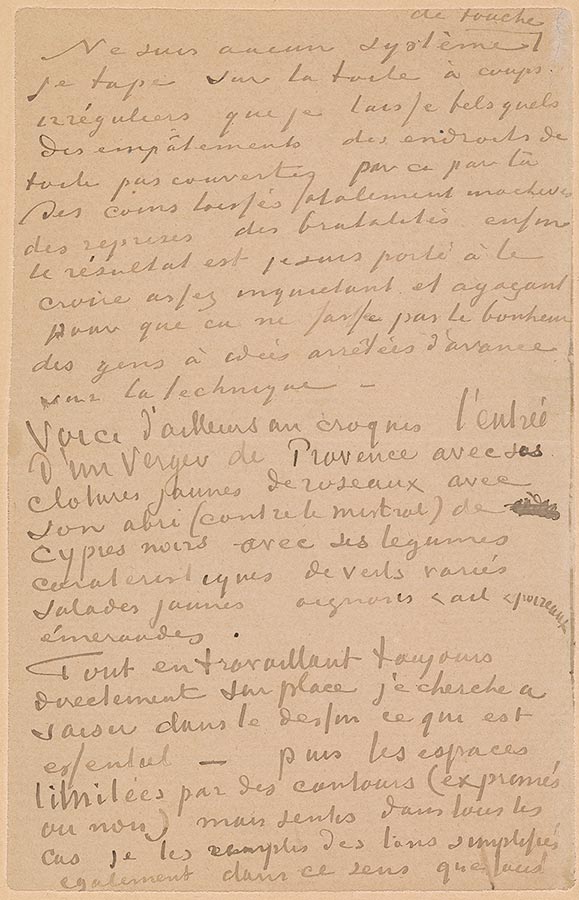
Vincent van Gogh, letter to Émile Bernard, Arles, 12 April 1888, Letter 3, page 2
Thaw Collection, given in honor of Charles E. Pierce, Jr., 2007
I follow no system of brushwork at all, I hit the canvas with irregular strokes, which I leave as
they are, impastos, uncovered spots of canvas—corners here and there left inevitably unfinished—
reworkings, roughnesses; well, I'm inclined to think that the result is sufficiently worrying and
annoying not to please people with preconceived ideas about technique.
Here's a sketch, by the way, the entrance to a Provençal orchard with its yellow reed fences,
with its shelter (against the mistral), black cypresses, with its typical vegetables of various greens,
yellow lettuces, onions and garlic and emerald leeks.
While always working directly on the spot, I try to capture the essence in the drawing—then
I fill the spaces demarcated by the outlines (expressed or not) but felt in every case, likewise with
simplified tints, in the sense that everything
© 2007 Van Gogh Museum, Amsterdam
Letter 3, page 3
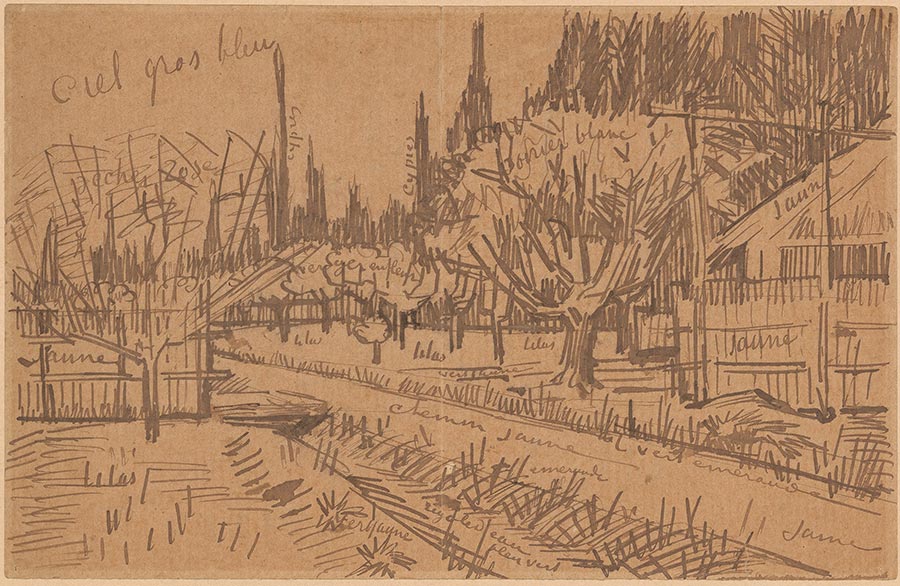
Vincent van Gogh, letter to Émile Bernard, Arles, 12 April 1888, Letter 3, page 3
Orchard surrounded by cypresses
Thaw Collection, given in honor of Charles E. Pierce, Jr., 2007
The first paragraph of this letter addresses a central issue of debate between van Gogh, Bernard, and Gauguin. Bernard and Gauguin favored working from the imagination, producing what they called abstractions, while van Gogh felt a pressing need to work directly from nature, which presented its own obstacles. Van Gogh mused about painting outdoors after sundown, "A starry sky, for example, well—it's a thing that I should like to try to do. . . . But how to arrive at that unless I decide to work at home and from the imagination?" Seven months later van Gogh depicted his first evening sky, and the following year he produced his nocturnal masterpiece, Starry Night, now in the Museum of Modern Art.
In order to communicate essential information about his use of color, van Gogh described at length the pigments he used and their intended effect. Here he wrote of his recent paintings of fruit trees in blossom, proud of his unconventional brushwork—the impasto for which he is famed—and idiosyncratic use of color. Satisfied with his departure from convention, van Gogh assumed that "the result is sufficiently worrying and annoying not to please people with preconceived ideas about technique." He then quarter turned the sheet and quickly drafted a sketch after his first version of a painting of a Provençal orchard.
Letter 3, page 4
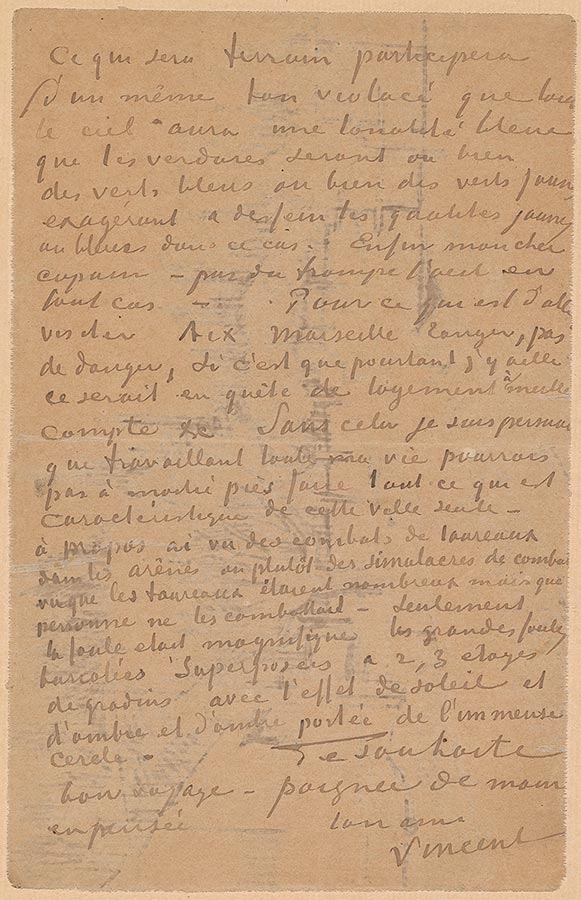
Vincent van Gogh, letter to Émile Bernard, Arles, 12 April 1888, Letter 3, page 4
Thaw Collection, given in honor of Charles E. Pierce, Jr., 2007
that will be earth will share the same purplish
tint, that the whole sky will have a blue tonality, that the greenery will either be blue greens or
yellow greens, deliberately exaggerating the yellow or blue values in that case. Anyway, my dear
pal, no trompe l'oeil in any case. As for going to visit Aix, Marseille, Tangier, no fear; if I were to go
there, however, it would be in search of cheaper lodgings, etc. Otherwise, I'm convinced that if I
worked my whole life, couldn't do as much as half of all that is characteristic of this town alone.
By the way, have seen bullfights in the arenas, or rather, simulated fights, seeing that the bulls
were numerous but nobody was fighting them. But the crowd was magnificent, great multicolored
crowds. One on top of the other on two, three tiers, with the effect of sun and shade and the
shadow of the immense circle. Wish you bon voyage—handshake in thought, your friend
Vincent
© 2007 Van Gogh Museum, Amsterdam
Letter 4, page 1
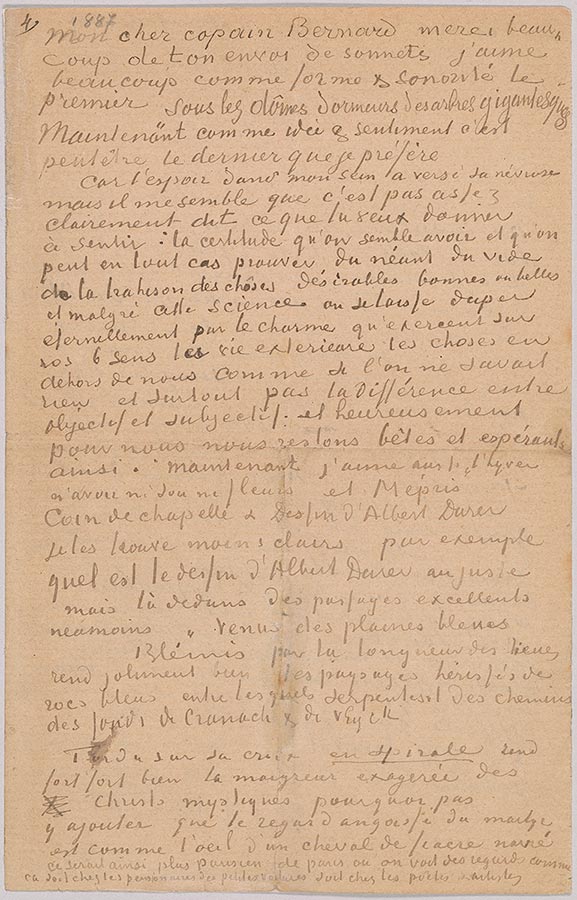
Vincent van Gogh, letter to Émile Bernard, Arles, 19 April 1888, Letter 4, page 1
Thaw Collection, given in honor of Charles E. Pierce, Jr., 2007
My dear old Bernard,
Many thanks for sending your sonnets. For form and sonority I very much like the first one,
"Under the sleeping canopies of the gigantic trees." Now for idea and sentiment it's perhaps the
last one that I prefer: "For hope has poured its nervousness into my breast," but it seems to me that
what you want to evoke isn't stated clearly enough: the certainty that we seem to have and which
anyway we can prove, of nothingness, of emptiness, of the treachery of desirable, good, or beautiful
things, and despite this knowledge we forever allow ourselves to be deceived by the spell that
external life, things outside ourselves, cast over our six senses, as though we knew nothing, and
especially not the difference between objective and subjective. And fortunately for us, in that way
we remain ignorant and hopeful. Now I also like "In winter, have neither a sou nor a flower," and
"Contempt." "Corner of a chapel" and "Drawing by Albrecht Dürer" I find less clear. For example,
precisely which drawing by Albrecht Dürer is it? But excellent passages in it nevertheless. "Having
come from the blue plains, Made pale by the long miles" is a jolly good rendering of the landscapes
bristling with blue rocks between which the roads wind in the backgrounds of Cranach and Van Eyck.
Twisted on his cross in a spiral is a very, very good rendering of the exaggerated thinness of the
mystical Christs; why not add to it that the anguished expression of the martyr is like the eye of
a brokenhearted cab horse? That way it would be more utterly Parisian, where you see looks like
that, either in the drivers of the little carriages or in poets and artists.
© 2007 Van Gogh Museum, Amsterdam
Letter 4, page 2
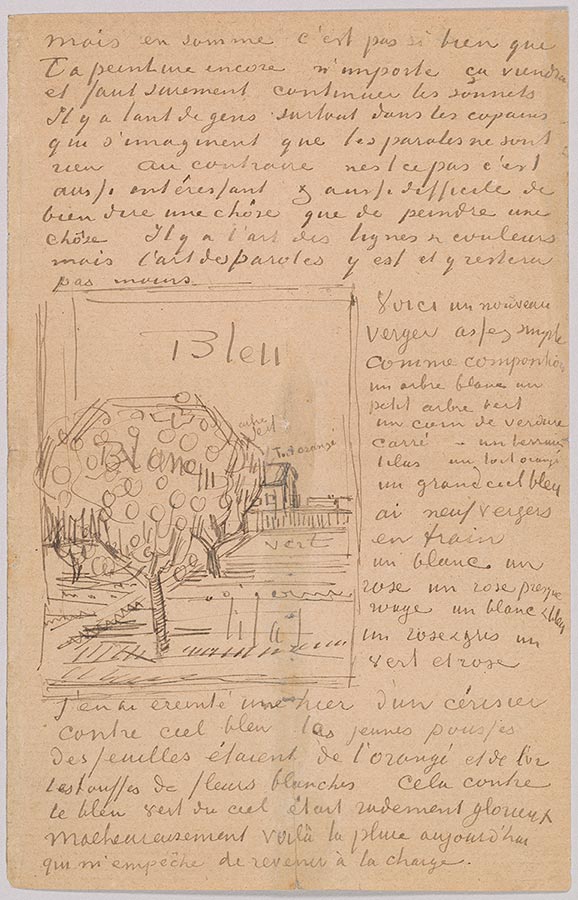
Vincent van Gogh, letter to Émile Bernard, Arles, 19 April 1888, Letter 4, page 2
Thaw Collection, given in honor of Charles E. Pierce, Jr., 2007
But all in all it's not as good
as your painting yet. Never mind. It'll come, and you must certainly continue doing sonnets.
There are so many people, especially among our pals, who imagine that words are nothing.
On the contrary, don't you think, it's as interesting and as difficult to say a thing well as to paint a
thing. There's the art of lines and colors, but there's the art of words that will last just the same.
Here's a new orchard, quite simple in composition: a white tree, a small green tree, a square
corner of greenery—a lilac field, an orange roof, a big blue sky. Have nine orchards in progress; one
white, one pink, one almost red pink, one white and blue, one pink and gray, one green and pink.
I worked one to death yesterday, of a cherry tree against blue sky, the young shoots of the
leaves were orange and gold, the clusters of flowers white. That, against the blue green of the sky,
was darned glorious. Unfortunately there's rain today, which prevents me going back on the attack.
© 2007 Van Gogh Museum, Amsterdam
Letter 4, page 3
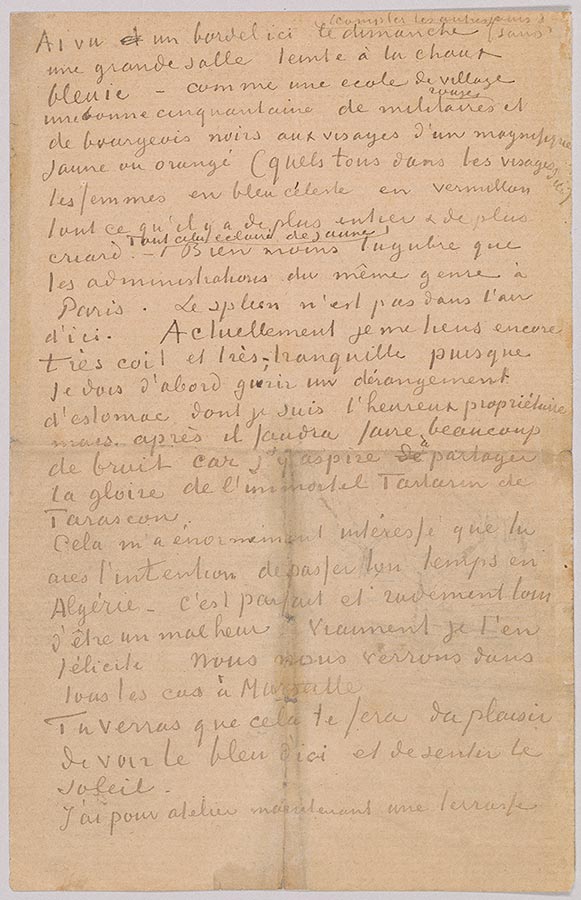
Vincent van Gogh, letter to Émile Bernard, Arles, 19 April 1888, Letter 4, page 3
Thaw Collection, given in honor of Charles E. Pierce, Jr., 2007
Saw a brothel here on Sunday (not to mention the other days), a large room tinged with a bluish
limewash—like a village school—a good fifty or so red soldiers and black civilians, with faces
of a magnificent yellow or orange (what tones in the faces down here), the women in sky blue, in
vermilion, everything that's of the purest and gaudiest. All of it in yellow light. Far less gloomy
than the establishments of the same kind in Paris. Spleen is not in the air down here. At present I'm
still keeping very quiet and very calm, because first I have to get over a stomach ailment of which
I am the happy owner, but afterwards I'll have to make a lot of noise, because I aspire to share the
renown of the immortal Tartarin de Tarascon.
It interested me enormously that you intend spending your time in Algeria. That's perfect and
a hell of a long way from being a misfortune. Truly, I congratulate you on it. We'll see each other in
Marseille in any case.
You'll find that you'll enjoy seeing the blue down here and feeling the sun.
I now have a terrace for a studio.
© 2007 Van Gogh Museum, Amsterdam
Letter 4, page 4
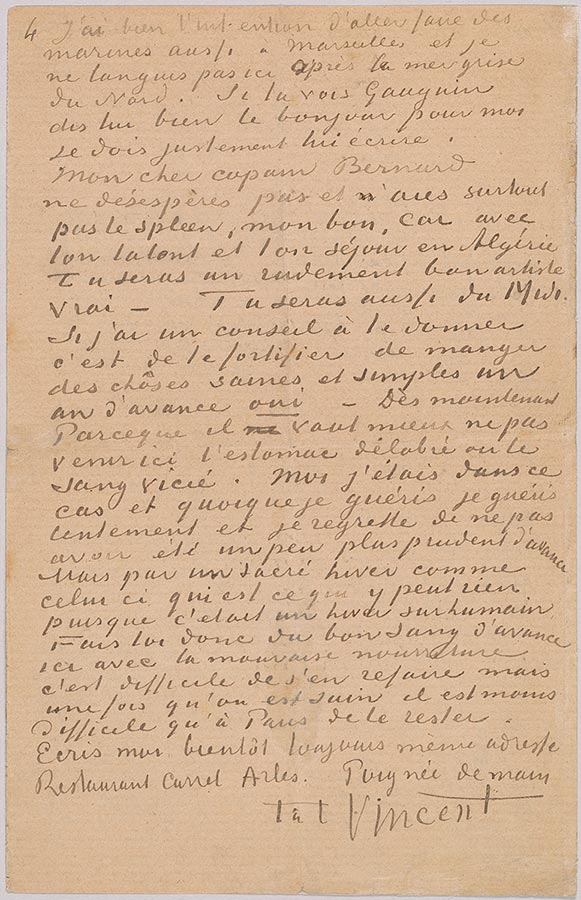
Vincent van Gogh, letter to Émile Bernard, Arles, 19 April 1888, Letter 4, page 4
Thaw Collection, given in honor of Charles E. Pierce, Jr., 2007
(Continued from page 3)
I really intend to go and do seascapes, too, in Marseille, and I don't pine here for the gray sea
of the north. If you see Gauguin, greet him warmly for me; I must write to him in a moment.
My dear old Bernard, don't despair and above all, don't be downhearted, my good fellow,
because with your talent and your stay in Algeria, you'll be a hell of a good artist. True—you'll be
a southerner, too. If I have a piece of advice to give you, it's to build yourself up by eating healthy
and simple things for a year beforehand, yes. Starting now. Because it's better not to come here with
a ruined stomach or spoiled blood. That was the case with me, and although I'm recovering, I'm
recovering slowly, and I regret not having been a little more prudent beforehand. But who can do
anything in a bloody winter like this one, because it was a preternatural winter. So see that your
blood's good beforehand; with the bad food here it's difficult to regain that, but once you're
healthy it's less difficult to stay that way than in Paris.
Write to me soon, still same address, Restaurant Carrel, Arles. Handshake.
Ever yours,
Vincent
© 2007 Van Gogh Museum, Amsterdam
Letter 5, page 1
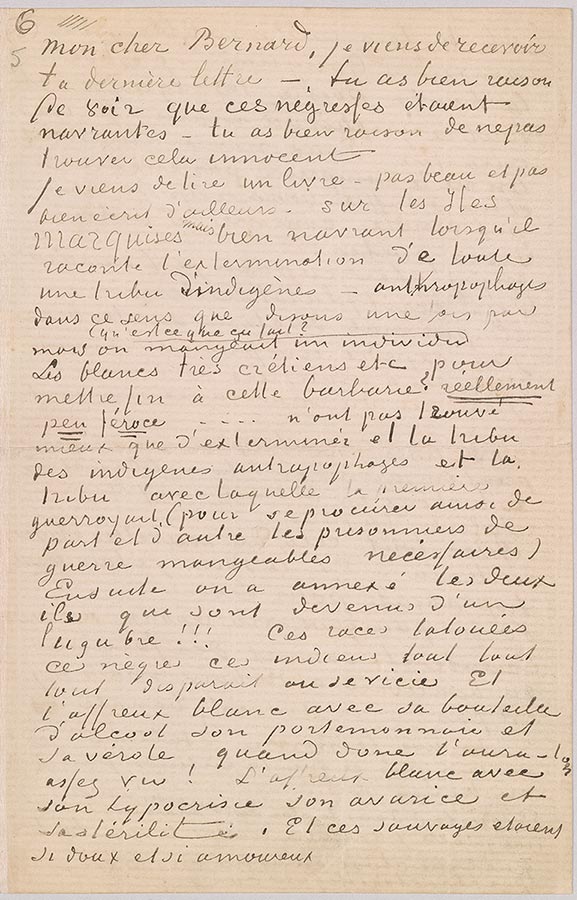
Vincent van Gogh, letter to Émile Bernard, Arles, ca. 22 May 1888, Letter 5, page 1
Thaw Collection, given in honor of Charles E. Pierce, Jr., 2007
My dear Bernard,
I've just received your last letter—you're quite right to see that those negresses were heartrending—
you're quite right not to find it innocent.
I've just read a book—not beautiful and not well written, by the way—on the Marquesas Islands,
but very heartrending in its description of the extermination of an entire tribe of natives—cannibals
in the sense that let's say an individual was eaten once a month, and what of that?
The whites, very Christian, etc., to put an end to this barbarity? REALLY NOT VERY SAVAGE. . . .
could think of nothing better than to exterminate both the tribe of cannibal natives and the tribe
with which the former was at war (in order to obtain the requisite edible prisoners of war on both
sides). Then the two islands were annexed, and did they become dismal!!! Those tattooed races, those
negroes, those Indians, everything, everything, everything disappears or is corrupted. And the frightful
white man, with his bottle of alcohol, his wallet and his pox, when will we have seen enough of
him! The frightful white man, with his hypocrisy, his greed and his sterility! And those savages were
so gentle and so loving.
© 2007 Van Gogh Museum, Amsterdam
Letter 5, page 2
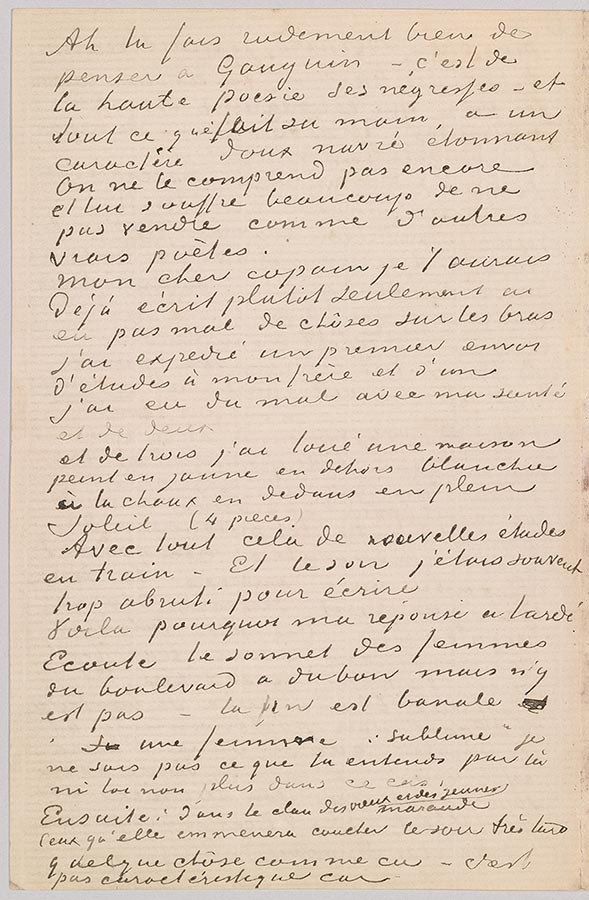
Vincent van Gogh, letter to Émile Bernard, Arles, ca. 22 May 1888, Letter 5, page 2
Thaw Collection, given in honor of Charles E. Pierce, Jr., 2007
Ah, you do darned well to think of Gauguin—they're high poetry, his negresses—and everything
his hand makes has a sweet, heartrending, astonishing character. People don't understand him yet,
and he suffers greatly from not selling, like other true poets.
My dear pal, I would have written to you sooner, only have had quite a few things on my hands;
I've sent a first batch of studies to my brother is one, I've had trouble with my health is two, and
three is that I've rented a house painted yellow outside, whitewashed inside, in the full sun
(four rooms).
With all that, new studies in progress. And in the evening I was often too numbed to write.
That's why my reply was delayed.
Listen, the sonnet about the women of the boulevard has some good things, but it isn't there
yet—the end's banal.
A "sublime" woman, I don't know what you mean by that, nor do you in this case.
Then
"Hunting among the clan of old and young
Those whom she'll take to bed late at night."
Something like that—It's not characteristic, because
© 2007 Van Gogh Museum, Amsterdam
Letter 5, page 3
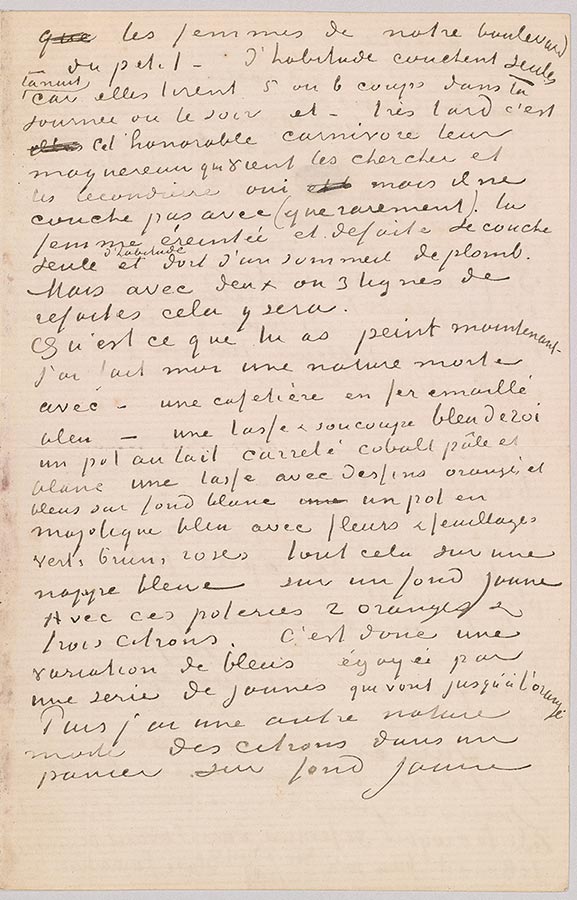
Vincent van Gogh, letter to Émile Bernard, Arles, ca. 22 May 1888, Letter 5, page 3
Thaw Collection, given in honor of Charles E. Pierce, Jr., 2007
the women of our boulevard—le petit—usually
sleep alone at night because they screw five or six times during the day or the evening and—late at
night it's that honorable carnivore, their pimp, who comes to collect them and take them home; yes,
but he doesn't sleep with them (only rarely). The worn-out and haggard woman usually goes to bed
alone and sleeps a leaden sleep. But with two or three lines redone, it'll be there.
What have you painted now? I myself have done a still life with—a coffeepot in blue enameled
iron—a royal blue cup and saucer, a milk jug with pale cobalt and white checks, a cup with orange
and blue designs on a white background, a blue majolica jug with green, brown, pink flowers and
foliage, all of it on a blue tablecloth against a yellow background. With these pieces of crockery,
two oranges, and three lemons. It's thus a variation of blues enlivened by a series of yellows ranging
all the way to orange.
Then I have another still life, some lemons in a basket against a yellow background.
© 2007 Van Gogh Museum, Amsterdam
Letter 5, page 4
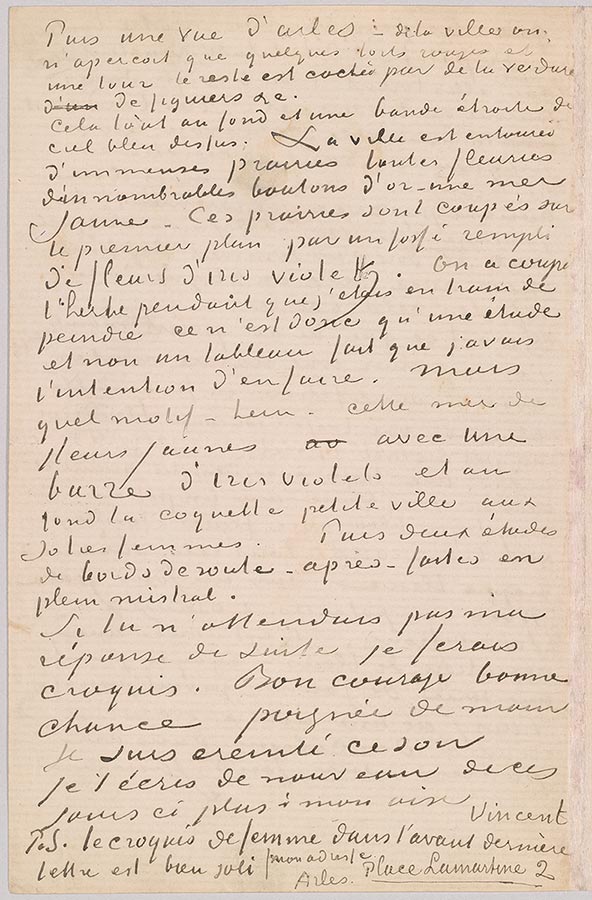
Vincent van Gogh, letter to Émile Bernard, Arles, ca. 22 May 1888, Letter 5, page 4
Thaw Collection, given in honor of Charles E. Pierce, Jr., 2007
Then a view of Arles—of the town you see only a few red roofs and a tower, the rest's hidden by
the foliage of fig trees, etc.
All that far off in the background and a narrow strip of blue sky above. The town is surrounded
by vast meadows decked with innumerable buttercups—a yellow sea. These meadows are intersected
in the foreground by a ditch full of purple irises. They cut the grass while I was painting, so it's only
a study and not a finished painting, which I intended to make of it. But what a subject—eh—that
sea of yellow flowers with a line of purple irises and in the background the neat little town of pretty
women. Then two studies of roadsides—afterwards—done out in the mistral.
If you were not expecting my reply right away, I'd make sketches. Courage, good luck, handshake.
I'm worn out this evening.
I'll write to you again one of these days, more at my ease.
Vincent
P.S. The sketch of the woman in the last letter but one is really pretty.
My address:
Place Lamartine 2
Arles
© 2007 Van Gogh Museum, Amsterdam
Letter 6, page 1
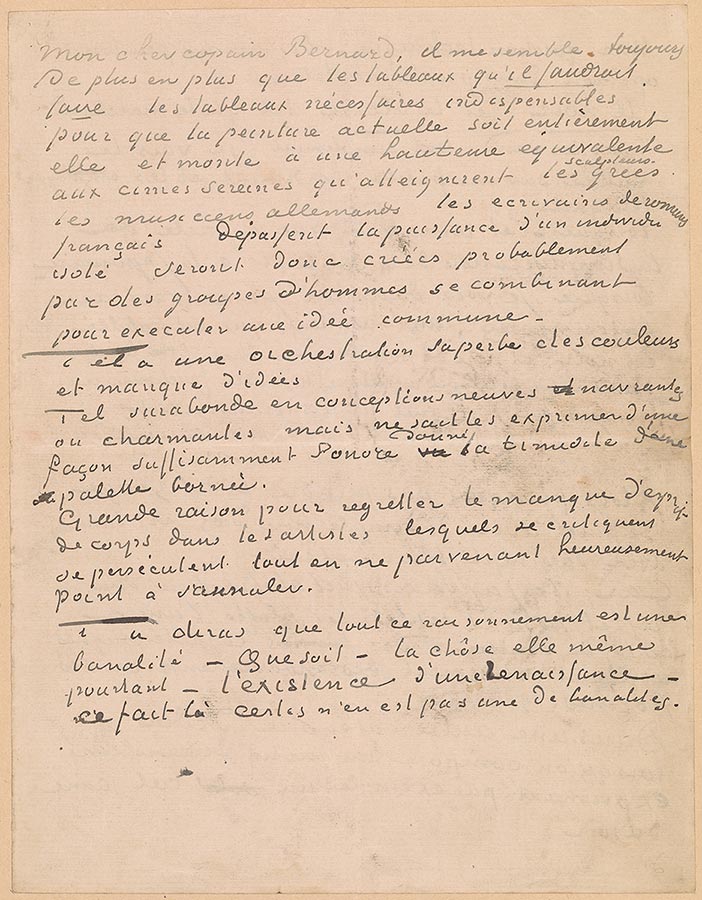
Vincent van Gogh, letter to Émile Bernard, Arles, 7 June 1888, Letter 6, page 1
Thaw Collection, given in honor of Charles E. Pierce, Jr., 2007
My dear old Bernard,
More and more it seems to me that the paintings that ought to be made, the paintings that are
necessary, indispensable for painting today to be fully itself and to rise to a level equivalent to the
serene peaks achieved by the Greek sculptors, the German musicians, the French writers of novels,
exceed the power of an isolated individual, and will therefore probably be created by groups of men
combining to carry out a shared idea.
One has a superb orchestration of colors and lacks ideas.
The other overflows with new, harrowing or charming conceptions but is unable to express
them in a way that is sufficiently sonorous, given the timidity of a limited palette.
Very good reason to regret the lack of an esprit de corps among artists, who criticize each
other, persecute each other, while fortunately not succeeding in canceling each other out.
You'll say that this whole argument is a banality. So be it—but the thing itself—the existence
of a Renaissance—that fact is certainly not a banality.
© 2007 Van Gogh Museum, Amsterdam
Letter 6, page 2
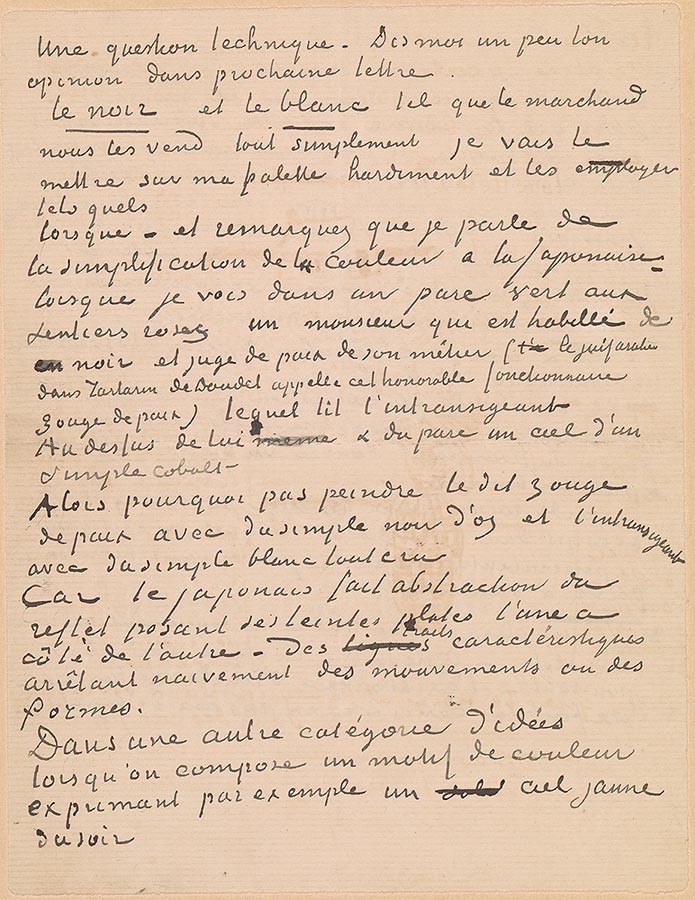
Vincent van Gogh, letter to Émile Bernard, Arles, 7 June 1888, Letter 6, page 2
Thaw Collection, given in honor of Charles E. Pierce, Jr., 2007
A technical question. Do give me your opinion in next letter.
I'm going to put the black and the white boldly on my palette, just the way the colorman sells
them to us, and use them as they are.
When—and note that I'm talking about the simplification of color in the Japanese manner—
when I see in a green park with pink paths a gentleman who is dressed in black, and a justice of the
peace by profession (the Arab Jew in Daudet's Tartarin calls this honorable official "shustish of the beace"), who's reading L'Intransigeant.
Above him and the park a sky of a simple cobalt.
Then why not paint the said shustish of the beace with simple bone black and L'Intransigeant
with simple, very harsh white?
Because the Japanese disregards reflection, placing his solid tints one beside the other—
characteristic lines naively marking off movements or shapes.
In another category of ideas, when you compose a color motif expressing, for example, a
yellow evening sky.
© 2007 Van Gogh Museum, Amsterdam
Letter 6, page 3
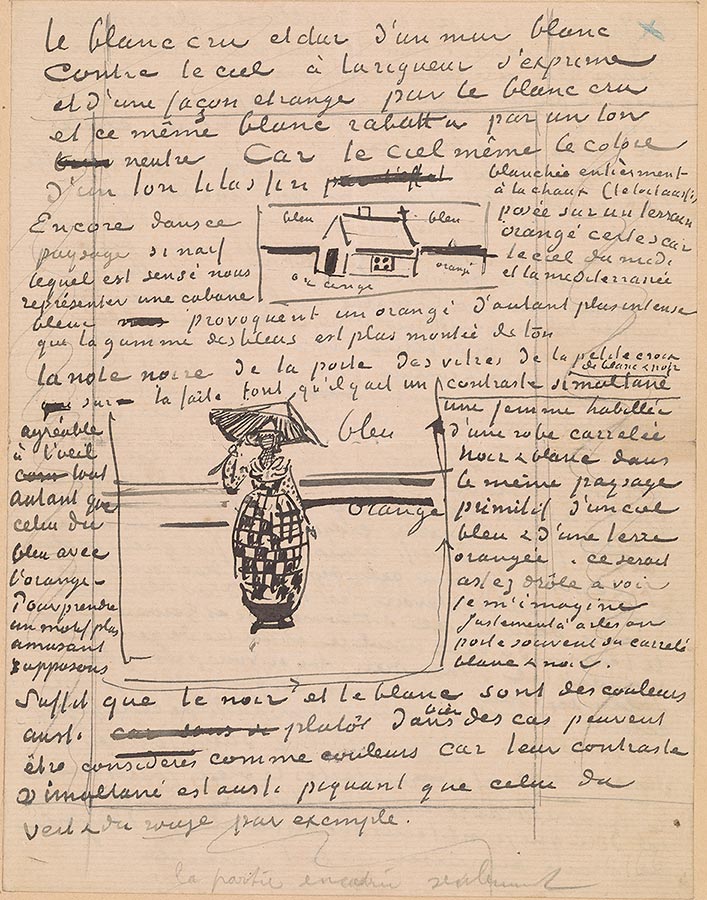
Vincent van Gogh, letter to Émile Bernard, Arles, 7 June 1888, Letter 6, page 3
Thaw Collection, given in honor of Charles E. Pierce, Jr., 2007
The harsh, hard white of a white wall against the sky can be expressed, at a pinch and in a
strange way, by harsh white and by that same white softened by a neutral tone. Because the sky
itself colors it with a delicate lilac hue. Again, in this very naive landscape, which is meant
to show us a hut, whitewashed overall (the roof, too), placed in an orange field, of course, because
the sky in the south and the blue Mediterranean produce an orange that is all the more intense
the higher in tint the range of blues.
The black note of the door, of the windowpanes, of the little cross on the rooftop creates a
simultaneous contrast of white and black just as pleasing to the eye as that of the blue
with the orange.
To take a more entertaining subject, let's imagine a woman dressed in a black and white
checked dress, in the same primitive landscape of a blue sky and an orange earth—that would
be quite amusing to see, I imagine. In fact, in Arles they often do wear white and black checks.
In short, black and white are colors too, or rather, in many cases may be considered colors, since their simultaneous contrast is as sharp as that of green and red, for example.
>© 2007 Van Gogh Museum, Amsterdam
Letter 6, page 4
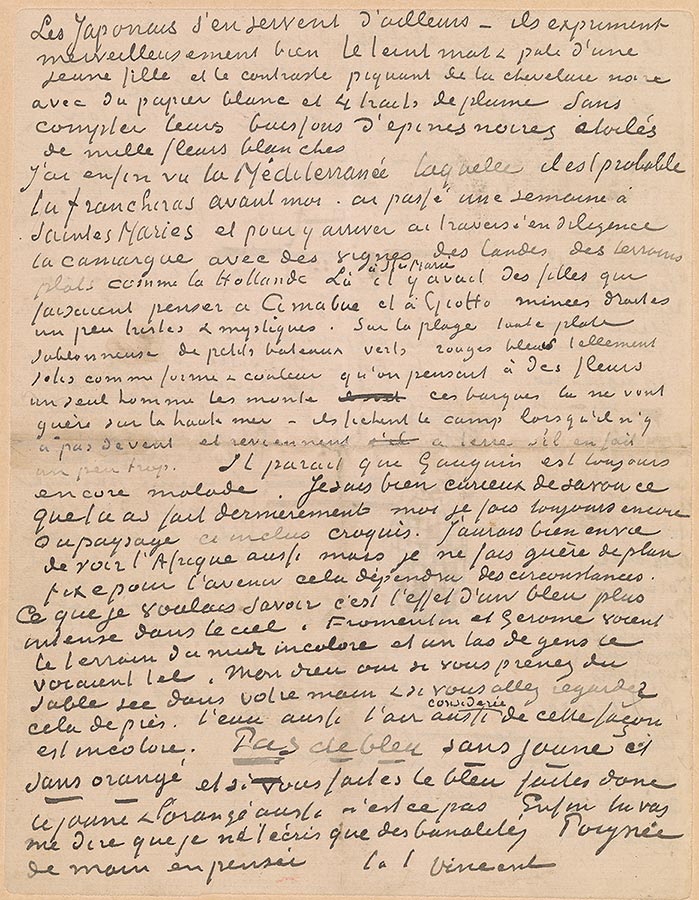
Vincent van Gogh, letter to Émile Bernard, Arles, 7 June 1888, Letter 6, page 4
Thaw Collection, given in honor of Charles E. Pierce, Jr., 2007
The Japanese use it too, by the way—they express a young girl's matte and pale complexion,
and its sharp contrast with her black hair wonderfully well with white paper and four strokes of the
pen. Not to mention their black thornbushes, studded with a thousand white flowers.
I've finally seen the Mediterranean, which you will probably cross before I do. Spent a week
in Saintes-Maries, and to get there crossed the Camargue in a diligence, with vineyards, heaths,
fields as flat as Holland. There, at Saintes-Maries, there were girls who made one think of Cimabue
and Giotto: slim, straight, a little sad and mystical. On the completely flat, sandy beach, little
green, red, blue boats, so pretty in shape and color that one thought of flowers; one man boards
them, these boats hardly go on the high sea—they dash off when there's no wind and come back to
land if there's a bit too much. It appears that Gauguin is still ill. I'm quite curious to know what
you've done lately; I'm still doing landscapes, sketch enclosed. I'd very much like to see Africa too,
but I hardly make any firm plans for the future, it will depend on circumstances. What I should like
to know is the effect of a more intense blue in the sky. Fromentin and Gérôme see the earth in
the south as colorless, and a whole lot of people saw it that way. My God, yes, if you take dry sand
in your hand and if you look at it closely. Water, too, air, too, considered this way, are colorless. No
BLUE WITHOUT YELLOW and WITHOUT ORANGE, and if you do blue, then do yellow and orange as
well, surely. Ah well, you'll tell me that I write you nothing but banalities. Handshake in thought,
Ever yours,
Vincent
© 2007 Van Gogh Museum, Amsterdam
Letter 6, page 5
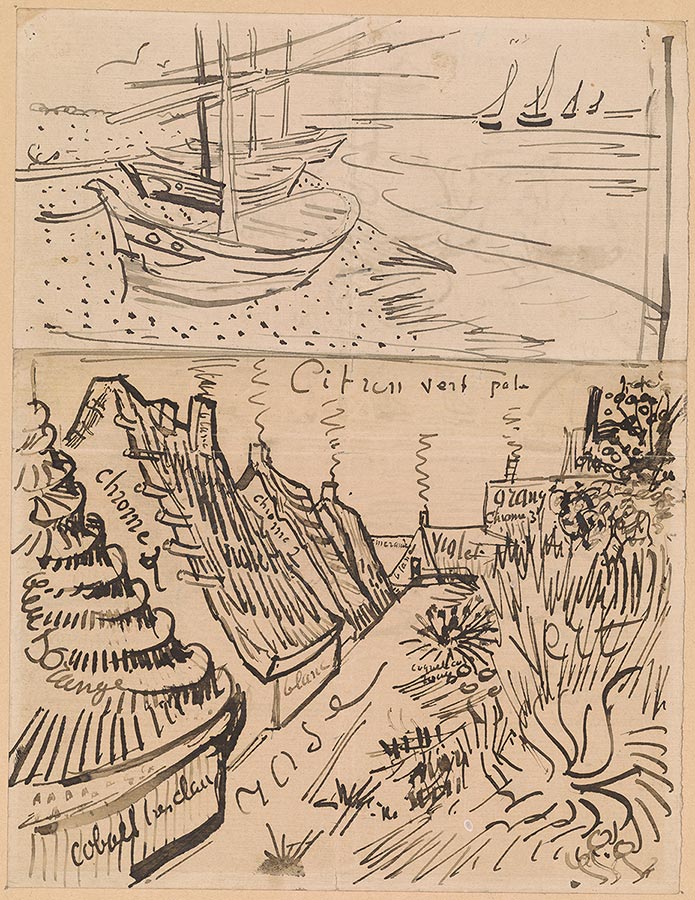
Vincent van Gogh, letter to Émile Bernard, Arles, 7 June 1888, Letter 6, page 5
Street in Saintes-Maries
Fishing boats on the beach
Thaw Collection, given in honor of Charles E. Pierce, Jr., 2007
Van Gogh deeply felt the need for a lively dialogue and collaboration among artists. He argued that for modern art to rival, for example, the accomplishments of ancient Greek sculptors, artists should work collectively on a shared idea, since the "paintings that ought to be made . . . exceed the power of an isolated individual." Included in this letter is a sketch of a still life with a blue enameled coffeepot. Bernard would have recognized it as an homage to his own painting made six months earlier while the two artists were in Paris. The sketch of the street in Saintes-Maries documents his freshly painted canvas, with copious notations of the pairs of complementary colors he employed.
Upon his return from an intensely productive journey to the seaside town of Saintes-Maries, van Gogh sent this letter with a sheet of sketches enclosed to Bernard. The care he took with the drawings shows that he was eager to communicate the excitement of his work resulting from the trip. Inspired by the vibrant and constantly changing colors of the Mediterrenean, he described the beached fishing boats as being "so pretty in shape and color that one thought of flowers." He included a quick sketch of the boats along with outlines of another seascape, and two landscapes he was working on. In the letter he continued to discuss his theories about color and the use of black and white, adding a sketch of a woman in a black and white checked dress to emphasize the need to use such pigments boldly. He then jotted down a small sketch of one of the local cottages that became the subject for several drawings and paintings.
Letter 6, page 6

Vincent van Gogh, letter to Émile Bernard, Arles, 7 June 1888, Letter 6, page 6
Still life with coffee pot
Fishing boats at sea; Landscape with edge of a road; Farm along a road
Thaw Collection, given in honor of Charles E. Pierce, Jr., 2007
Van Gogh deeply felt the need for a lively dialogue and collaboration among artists. He argued that for modern art to rival, for example, the accomplishments of ancient Greek sculptors, artists should work collectively on a shared idea, since the "paintings that ought to be made . . . exceed the power of an isolated individual." Included in this letter is a sketch of a still life with a blue enameled coffeepot. Bernard would have recognized it as an homage to his own painting made six months earlier while the two artists were in Paris. The sketch of the street in Saintes-Maries documents his freshly painted canvas, with copious notations of the pairs of complementary colors he employed.
Upon his return from an intensely productive journey to the seaside town of Saintes-Maries, van Gogh sent this letter with a sheet of sketches enclosed to Bernard. The care he took with the drawings shows that he was eager to communicate the excitement of his work resulting from the trip. Inspired by the vibrant and constantly changing colors of the Mediterrenean, he described the beached fishing boats as being "so pretty in shape and color that one thought of flowers." He included a quick sketch of the boats along with outlines of another seascape, and two landscapes he was working on. In the letter he continued to discuss his theories about color and the use of black and white, adding a sketch of a woman in a black and white checked dress to emphasize the need to use such pigments boldly. He then jotted down a small sketch of one of the local cottages that became the subject for several drawings and paintings.
Letter 7, page 1
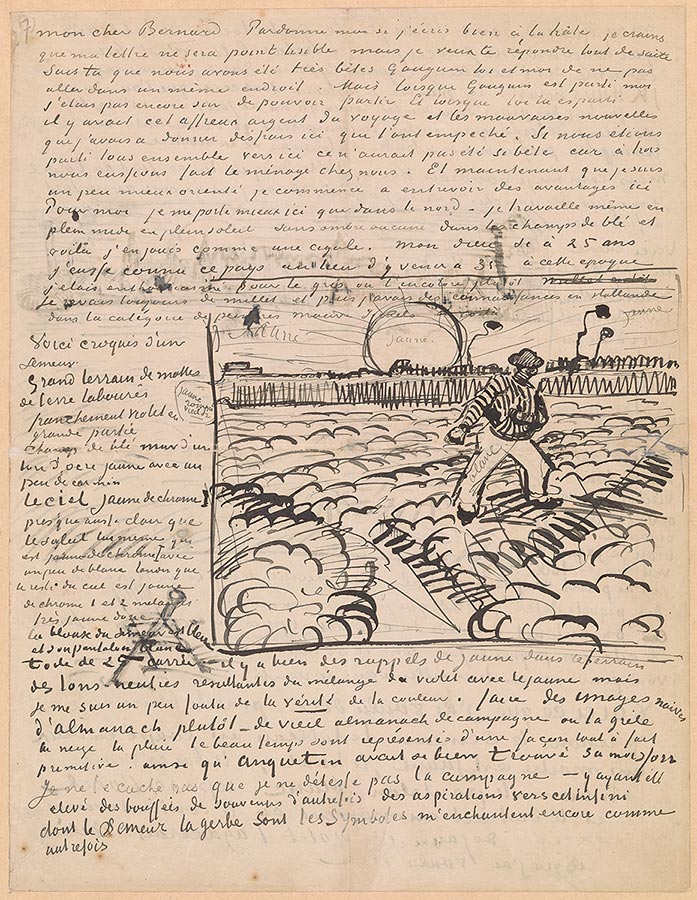
Vincent van Gogh, letter to Émile Bernard, Arles, 19 June 1888, Letter 7, page 1
Sower with setting sun
Thaw Collection, given in honor of Charles E. Pierce, Jr., 2007
My dear Bernard,
Forgive me if I write in great haste; I fear that my letter won't be at all legible, but I want to reply to
you right away.
Do you know that we've been very foolish, Gauguin, you, and I, in not all going to the same
place? But when Gauguin left, I wasn't yet sure of being able to leave. And when you left, there was
that dreadful money for the fare, and the bad news I had to give about the expenses here, which
prevented it. If we had all left for here together it wouldn't have been so foolish, because the three
of us would have done our own housekeeping. And now that I've found my bearings a little more,
I'm beginning to see the advantages here. For myself, I'm in better health here than in the north—I
even work in the wheat fields at midday, in the full heat of the sun, without any shade whatever,
and there you are, I revel in it like a cicada. My God, if only I had known this country at twenty-five,
instead of coming here at thirty-five—In those days I was enthusiastic about gray, or rather,
absence of color. I was always dreaming about Millet, and then I had acquaintances in the category
of painters like Mauve, Israëls. Here's sketch of a sower.
Large field with clods of plowed earth, mostly downright violet.
Field of ripe wheat in a yellow ocher tone with a little crimson.
The chrome yellow 1 sky almost as bright as the sun itself, which is chrome yellow 1 with a
little white, while the rest of the sky is chrome yellow 1 and 2 mixed, very yellow, then.
The sower's smock is blue, and his trousers white. Square no. 25 canvas. There are many repetitions of yellow in the earth, neutral tones, resulting from the mixing of violet with yellow, but I
could hardly give a damn about the veracity of the color. Better to make naive almanac pictures—old
country almanacs, where hail, snow, rain, fine weather are represented in an utterly primitive way. The
way Anquetin got his Harvest so well.
I don't hide from you that I don't detest the countryside—having been brought up there, snatches
of memories from past times, yearnings for that infinite of which the sower, the sheaf, are the symbols,
still enchant me as before.
© 2007 Van Gogh Museum, Amsterdam
Letter 7, page 2
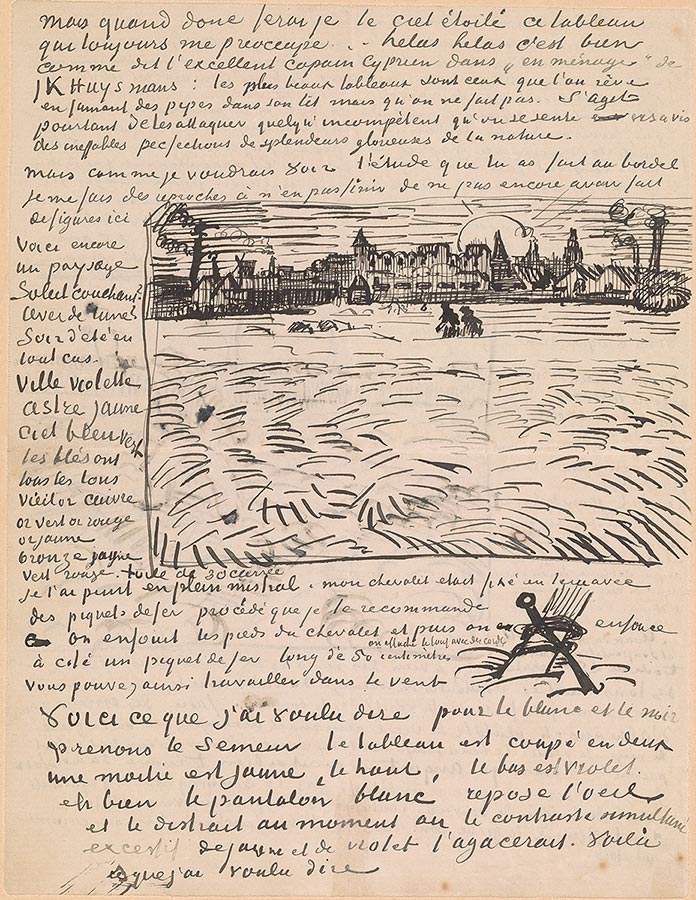
Vincent van Gogh, letter to Émile Bernard, Arles, 19 June 1888, Letter 7, page 2
Wheatfield with setting sun); Leg of an easel with a ground spike
Thaw Collection, given in honor of Charles E. Pierce, Jr., 2007
I don't hide from you that I don't detest the countryside—having been brought up there, snatches of memories from past times, yearnings for that infinite of which the sower, the sheaf, are the symbols, still enchant me as before.
But when will I do the starry sky, then, that painting that's always on my mind? Alas, alas, it's just as our excellent pal Cyprien says, in "En ménage" by J. K. Huysmans, the most beautiful paintings are those one dreams of while smoking a pipe in one's bed but which one doesn't make. But it's a matter of attacking them nevertheless, however incompetent one may feel vis-à-vis the ineffable perfections of nature's glorious splendors.
But how I should like to see the study you did at the brothel. I reproach myself endlessly for not having done figures here yet. Here's another landscape.11 Setting sun? Moonrise? Summer evening, at any rate.
Town violet, star yellow, sky blue green; the wheat fields have all the tones: old gold, copper, green gold, red gold, yellow gold, green, red and yellow bronze. Square no. 30 canvas.
I painted it out in the mistral. My easel was fixed in the ground with iron pegs, a method that I recommend to you. You shove the feet of the easel in and then you push a 50-centimeter-long iron peg in beside them. You tie everything together with ropes; that way you can work in the wind.
Here's what I wanted to say about the white and the black. Let's take the Sower. The painting is divided into two; one half is yellow, the top; the bottom is violet. Well, the white trousers rest the eye and distract it just when the excessive simultaneous contrast of yellow and violet would annoy it. That's what I wanted to say.
© 2007 Van Gogh Museum, Amsterdam
Letter 7, page 3
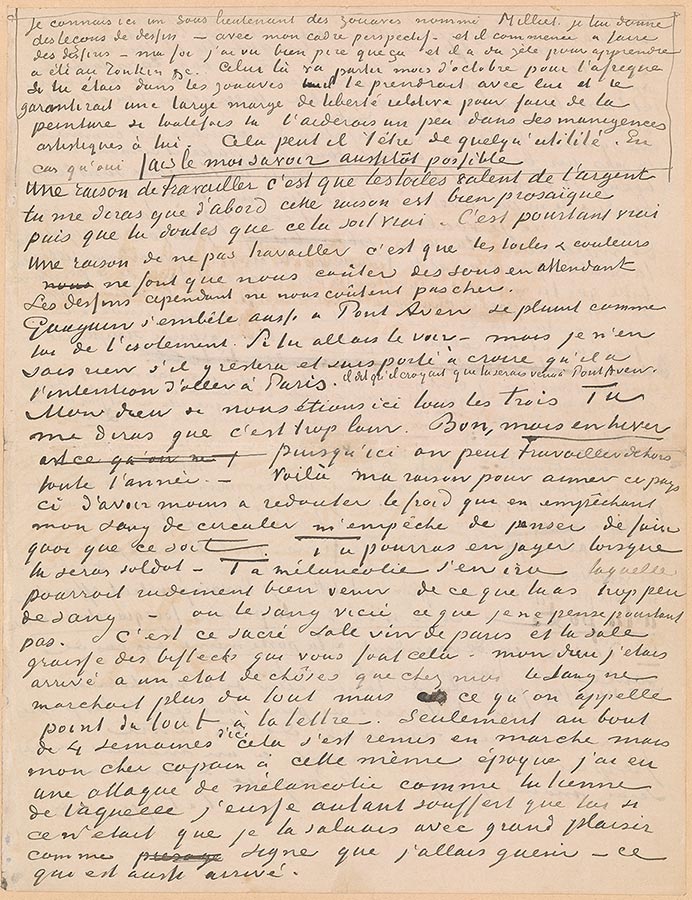
Vincent van Gogh, letter to Émile Bernard, Arles, 19 June 1888, Letter 7, page 3
Thaw Collection, given in honor of Charles E. Pierce, Jr., 2007
I know a second lieutenant of Zouaves here called Milliet. I give him drawing lessons—with my
perspective frame—and he's beginning to make drawings—my word, I've seen a lot worse than
that, and he's eager to learn; has been to Tonkin, etc. He's leaving for Africa in October. If you were
in the Zouaves, he'd take you with him and would guarantee you a wide margin of relative freedom
to paint, provided you helped him a little with his own artistic schemes. Could this be of some use
to you? If so, let me know as soon as possible.
One reason for working is that canvases are worth money. You'll tell me that first of all this reason is
very prosaic, then that you doubt that it's true. But it's true. A reason for not working is that in the
meantime canvases and paints only cost us money. Drawings, though, don't cost us much.
Gauguin's bored too in Pont-Aven; complains about isolation, like you. If you went to see
him—but I have no idea if he'll stay there, and am inclined to think that he intends to go to Paris.
He said that he thought you would have come to Pont-Aven.
My God, if all three of us were here! You'll tell me it's too far away. Fine, but in winter—because
here one can work outside all year round. That's my reason for loving this part of the world, not
having to dread the cold so much, which by preventing my blood from circulating prevents me from
thinking, from doing anything at all. You can judge that for yourself when you're a soldier. Your melancholy will go away, which may darned well come from the fact that you have too little blood—
or spoiled blood, which I don't think, however. It's that bloody filthy Paris wine and the filthy fat
of the steaks that do that to you—dear God, I had come to a state in which my own blood was no
longer working at all, but literally not at all, as they say. But after 4 weeks down here it got moving
again, but, my dear pal, at that same time I had an attack of melancholy like yours, from which I
would have suffered as much as you were it not that I welcomed it with great pleasure as a sign that
I was going to recover—which happened too.
© 2007 Van Gogh Museum, Amsterdam
Letter 7, page 4
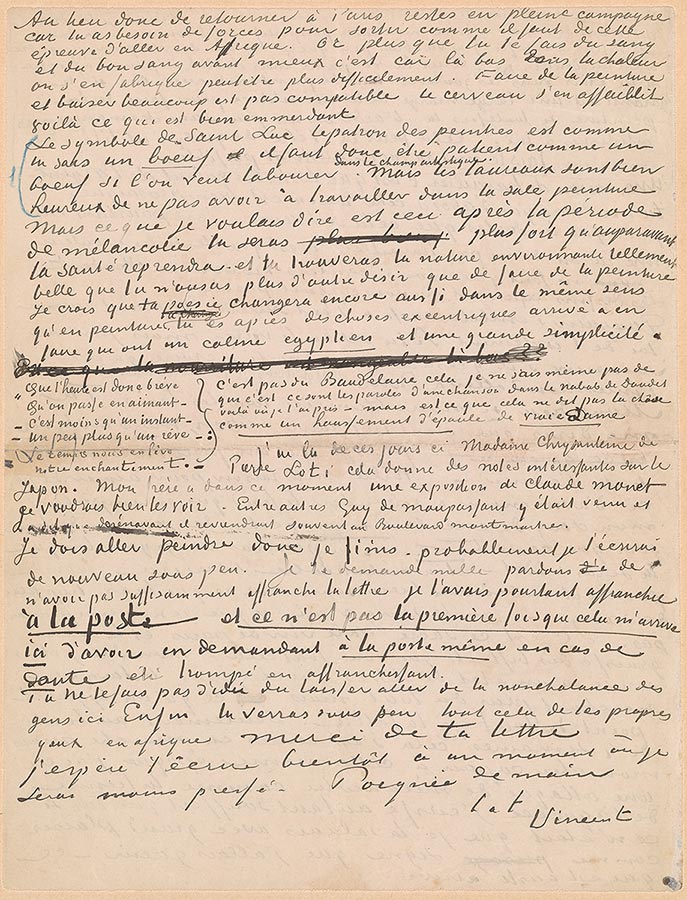
Vincent van Gogh, letter to Émile Bernard, Arles, 19 June 1888, Letter 7, page 4
Thaw Collection, given in honor of Charles E. Pierce, Jr., 2007
Instead of going back to Paris, then, stay out in the country, because you need strength to get
through this ordeal of going to Africa properly. Now the more blood, and good blood, that you
make yourself beforehand, the better, because over there in the heat it's perhaps harder to produce it.
Painting and fucking a lot are not compatible; it weakens the brain, and that's what's really damned
annoying.
The symbol of Saint Luke, the patron of painters, is, as you know, an ox; we must therefore be as
patient as an ox if we wish to labor in the artistic field. But bulls are pretty glad not having to work
in the filthy business of painting. But what I wanted to say is this. After the period of melancholy
you'll be stronger than before, your health will pick up—and you'll find the surrounding nature so
beautiful that you'll have no other desire than to paint. I believe that your poetry will also change, in
the same way as your painting. After some eccentric things you have succeeded in making some that
have an Egyptian calm and a great simplicity.
How short is the hour
We spend loving—
—It's less than an instant—
—A little more than a dream—:
—Time takes away
—Our spell.
That's not Baudelaire, I don't even know who it's by, they're the words of a song in Daudet's Le
Nabab, that's where I took it from—but doesn't it say the thing like a real Lady's shrug of her shoulder?
These last few days I read Pierre Loti's Madame Chrysanthème; it provides interesting remarks
about Japan. At the moment my brother has an exhibition of Claude Monet, I'd very much like to
see them. Guy de Maupassant, among others, had been there, and said that from now on he would
often revisit the boulevard Montmartre.
I have to go and paint, so I'll finish—I'll probably write to you again before long. I beg a thousand
pardons for not having put enough stamps on the letter, and yet I did stamp it at the post office and
this isn't the first time that it's happened here, that when in doubt, and asking at the post office itself, I've
been misled about the postage.
You can't imagine the carelessness, the nonchalance of the people here. Anyway, you'll see that
shortly with your own eyes in Africa. Thanks for your letter, I hope to write to you soon at a moment
when I'm in less of a hurry. Handshake,
Ever yours,
Vincent
© 2007 Van Gogh Museum, Amsterdam
Letter 8, page 1
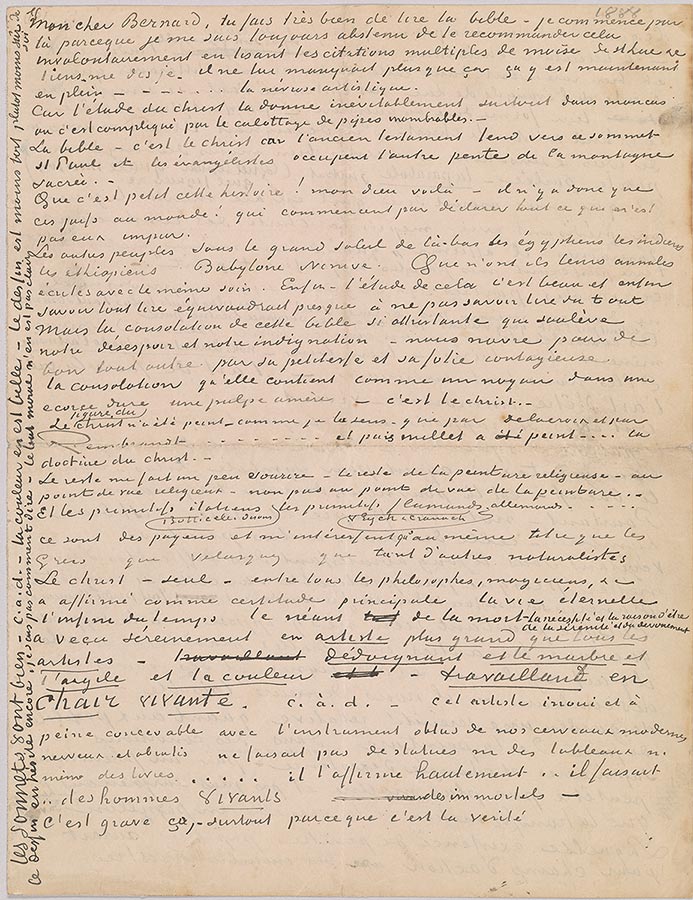
Vincent van Gogh, letter to Émile Bernard, Arles, 26 June 1888, Letter 8, page 1
Thaw Collection, given in honor of Charles E. Pierce, Jr., 2007
My dear Bernard,
You do very well to read the Bible—I start there because I've always refrained from recommending
it to you.
When reading your many quotations from Moses, from St. Luke, etc., I can't help saying to
myself—well, well—that's all he needed. There it is now, full-blown—. . . the artist's neurosis.
Because the study of Christ inevitably brings it on, especially in my case, where it's complicated
by the seasoning of innumerable pipes.
The Bible—that's Christ, because the Old Testament leads toward that summit; St. Paul and the
evangelists occupy the other slope of the holy mountain.
How petty that story is! My God, are there only these Jews in the world, then? Who start out by
declaring that everything that isn't themselves is impure?
The other peoples under the great sun over there—the Egyptians, the Indians, the Ethiopians,
Babylon, Nineveh. Why didn't they write their annals with the same care? Still, the study of it is
beautiful, and anyway, to be able to read everything would be almost the equivalent of not being
able to read at all. But the consolation of this so saddening Bible, which stirs up our despair and
our indignation—thoroughly upsets us, completely outraged by its pettiness and its contagious
folly the consolation it contains, like a kernel inside a hard husk, a bitter pulp—is Christ. The
figure of Christ has been painted—as I feel it—only by Delacroix and by Rembrandt . . . And then
Millet has painted . . . Christ's doctrine.
The rest makes me smile a little—the rest of religious painting—from the religious point of
view—not from the point of view of painting. And the Italian primitives (Botticelli, say), the Flemish,
German primitives (V. Eyck, & Cranach) . . . They're pagans, and only interest me for the same
reason as the Greeks do, and Velázquez, and so many other naturalists. Christ—alone—among all
the philosophers, magicians, etc., declared eternal life—the endlessness of time, the nonexistence of
death—to be the principal certainty. The necessity and the raison d'être of serenity and devotion.
Lived serenely as an artist greater than all artists—disdaining marble and clay and paint—working
in LIVING FLESH. I.e.—this extraordinary artist, hardly conceivable with the obtuse instrument
of our nervous and stupefied modern brains, made neither statues nor paintings nor even books . . .
he states it loud and clear . . . he made . . . LIVING men, immortals.
That's serious, you know, especially because it's the truth.
© 2007 Van Gogh Museum, Amsterdam
Letter 8, page 2
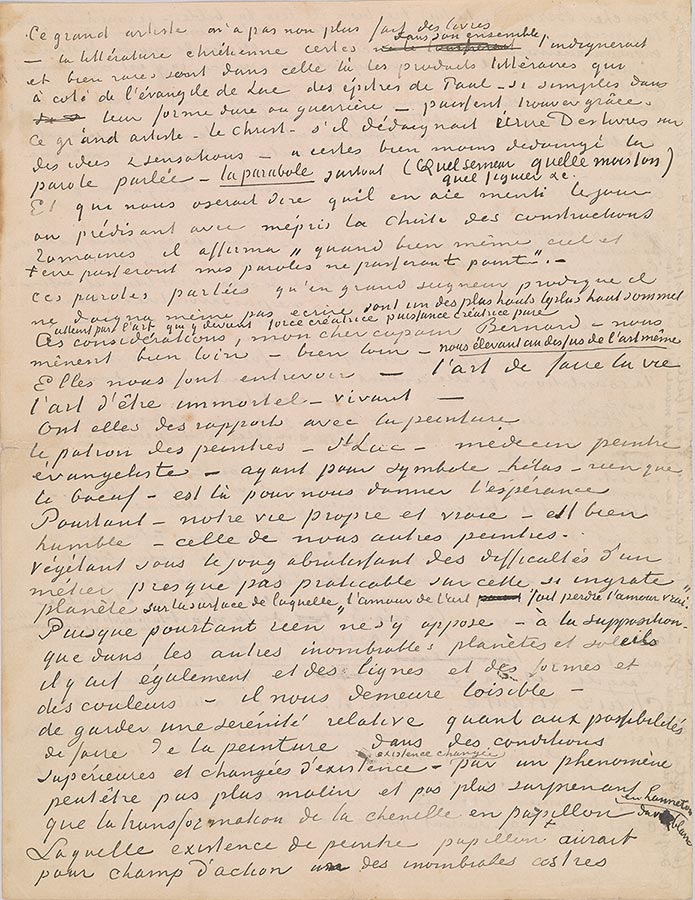
Vincent van Gogh, letter to Émile Bernard, Arles, 26 June 1888, Letter 8, page 2
Thaw Collection, given in honor of Charles E. Pierce, Jr., 2007
That great artist didn't make books, either—Christian literature as a whole would certainly
infuriate him, and its literary products that could find favor beside Luke's gospel, Paul's epistles—so
simple in their hard or warlike form—are few and far between. This great artist—Christ—although
he disdained writing books on ideas & feelings—was certainly much less disdainful of the spoken
word—THE PARABLE above all. (What a sower, what a harvest, what a fig-tree, etc.)
And who would dare tell us that he lied, the day when, scornfully predicting the fall of the buildings
of the Romans, he stated, "heaven and earth shall pass away, but my words shall not pass away?"
Those spoken words, which as a prodigal, great lord he did not even deign to write down,
are one of the highest, the highest summit attained by art, which in them becomes a creative force,
a pure creative power.
These reflections, my dear old Bernard—take us a very long way—a very long way—raising us
above art itself. They enable us to glimpse—the art of making life, the art of being immortal—alive.
Do they have connections with painting? The patron of painters—St. Luke—physician, painter,
evangelist—having for his symbol—alas—nothing but the ox—is there to give us hope.
Nevertheless—our own real life—is humble indeed—our life as painters.
Stagnating under the stupefying yoke of the difficulties of a craft almost impossible to practice
on this so hostile planet, on the surface of which "love of art makes one lose real love."
Since, however, nothing stands in the way—of the supposition that on the other innumerable
planets and suns there may also be lines and shapes and colors—we are still at liberty—to retain
a relative serenity as to the possibilities of doing painting in better and changed conditions of existence—
an existence changed by a phenomenon perhaps no cleverer and no more surprising than
the transformation of the caterpillar into a butterfly, of the white grub into a cockchafer.
That existence of painter as butterfly would have for its field of action one of the innumerable
stars,
© 2007 Van Gogh Museum, Amsterdam
Letter 8, page 3
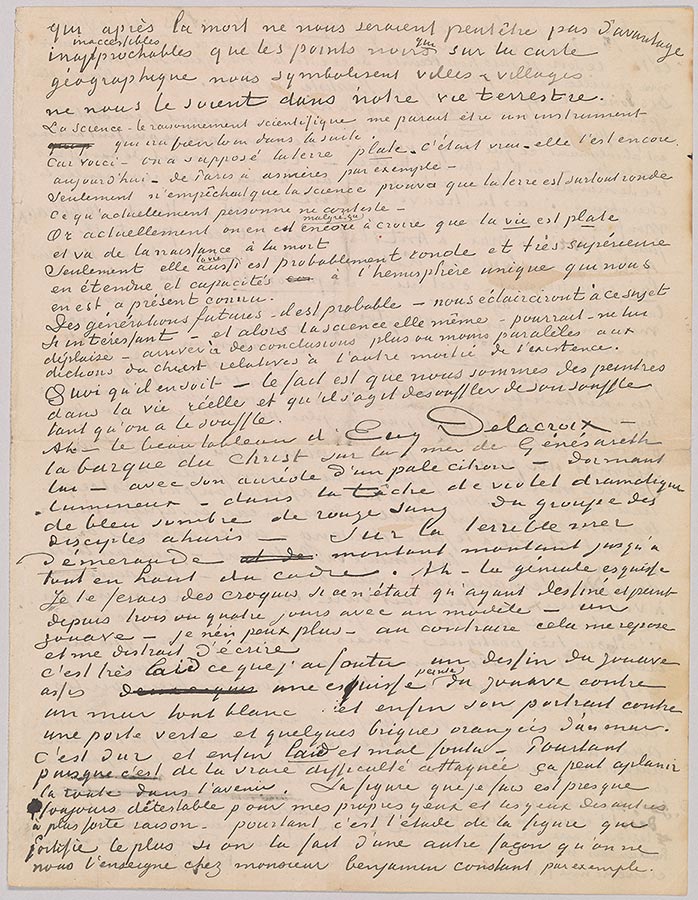
Vincent van Gogh, letter to Émile Bernard, Arles, 26 June 1888, Letter 8, page 3
Thaw Collection, given in honor of Charles E. Pierce, Jr., 2007
which, after death, would perhaps be no more unapproachable, inaccessible to us than the
black dots that symbolize towns and villages on the map in our earthly life. Science—scientific
reasoning—seems to me to be an instrument that will go a very long way in the future.
Because, look—it was thought that the earth was flat—that was true—it still is today—from
Paris to Asnières, for example.
But that didn't prevent science proving that the earth is above all round. Which nobody
disputes nowadays.
Now at present, despite that, we're still in the position of believing that life is flat and goes from
birth to death.
But life too is probably round, and far superior in extent and potentialities to the single hemisphere
that is known to us at present.
Future generations—probably—will enlighten us on this subject that is so interesting—and
then science itself—could—with all due respect—reach conclusions more or less parallel to Christ's
words concerning the other half of existence.
Whatever the case—the fact is that we are painters in real life, and it's a matter of breathing
one's breath as long as one has breath.
Ah—E. DELACROIX'S beautiful painting—Christ's boat on the sea of Gennesaret, he—with his
pale lemon halo—sleeping, luminous—within the dramatic violet, dark blue, blood-red patch of
the group of stunned disciples. On the terrifying emerald sea, rising, rising all the way up to the top
of the frame. Ah—the brilliant sketch.
I would make you some sketches were it not that having drawn and painted for three or four
days with a model—a Zouave—I'm exhausted—on the contrary, writing is restful and diverting.
What I've done is bloody ugly: a drawing of the Zouave, seated, a painted sketch of the Zouave
against an all-white wall and lastly his portrait against a green door and some orange bricks of a
wall. It's harsh and, well, ugly and badly done. However, since that's the real difficulty attacked, it
may smooth the way in the future. The figures that I do are almost always detestable in my own eyes,
and all the more so in others' eyes—nevertheless, it's the study of the figure that strengthens us the
most, if we do it in a different way than we're taught at Monsieur Benjamin Constant's, for example.
© 2007 Van Gogh Museum, Amsterdam
Letter 8, page 4
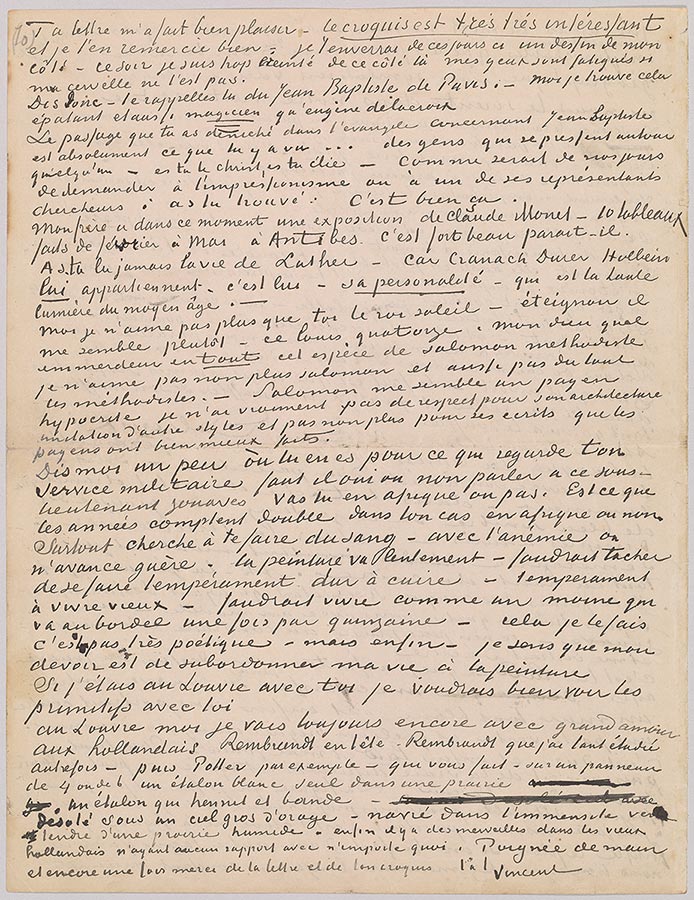
Vincent van Gogh, letter to Émile Bernard, Arles, 26 June 1888, Letter 8, page 4
Thaw Collection, given in honor of Charles E. Pierce, Jr., 2007
Your letter gave me great pleasure—the SKETCH IS VERY INTERESTING and I do
thank you for it—for my part I'll send you a drawing one of these days—this evening I'm too worn
out in that respect; my eyes are tired, not to mention my brain.
Listen—do you remember John the Baptist by Puvis? I find it marvelous and as much the
MAGICIAN as Eugène Delacroix.
The passage about John the Baptist that you dug out of the gospel is absolutely what you saw
in it . . . People pressing around somebody—art thou Christ, art thou Elias? As it would be in our
day to ask impressionism or one of its searcher-representatives, "have you found it?" That's just it.
At the moment my brother has an exhibition of Claude Monet—10 paintings done in Antibes
from February to May. It seems it's very beautiful.
Have you ever read the life of Luther? Because Cranach, Dürer, Holbein belong to him—it's
he—his personality—that's the lofty light of the Middle Ages.
I like the Sun King no more than you do—extinguisher of light it rather seems to me—that
Louis xiv—my God, what a pain, in every way, that Methodist Solomon. I don't like Solomon
either, and the Methodists not at all, as well. Solomon seems a hypocritical pagan to me; I really
have no respect for his architecture, an imitation of other styles, nor for his writings, which the
pagans have done much better.
Tell me a bit about where you stand as far as your military service is concerned; should I talk
to that second lieutenant of Zouaves or not? Are you going to Africa or not? In your case, do the
years count double in Africa or not? Most of all, see that your blood's in order—you don't get very
far with anemia—painting goes slowly—better try to make your constitution as tough as old boots,
a constitution to make old bones—better live like a monk who goes to the brothel once a fortnight—
I do that, it's not very poetical—but anyway—I feel that my duty is to subordinate my life
to painting.
If I was in the Louvre with you, I'd really like to see the primitives with you.
In the Louvre, I still return with great love to the Dutch, Rembrandt first and foremost—
Rembrandt whom I once studied so thoroughly—then Potter, for example—who makes—on a
no. 4 or no. 6 panel, a white stallion alone in a meadow, a stallion neighing, and with a hard-on
—forlorn under a sky brewing up a thunderstorm—heartbroken in the tender green immensity of
a wet meadow—ah well, there are wonderful things in the old Dutchmen having no connection
with anything at all. Handshake, and thank you again for your letter and for your sketch.
Ever yours,
Vincent
The sonnets are going well—i.e.—the color in them is good—the design isn't as strong, less
sure of itself, rather; the conception's still hesitant, I don't know how to put it—its moral
purpose isn't clear.
© 2007 Van Gogh Museum, Amsterdam
Letter 9, page 1
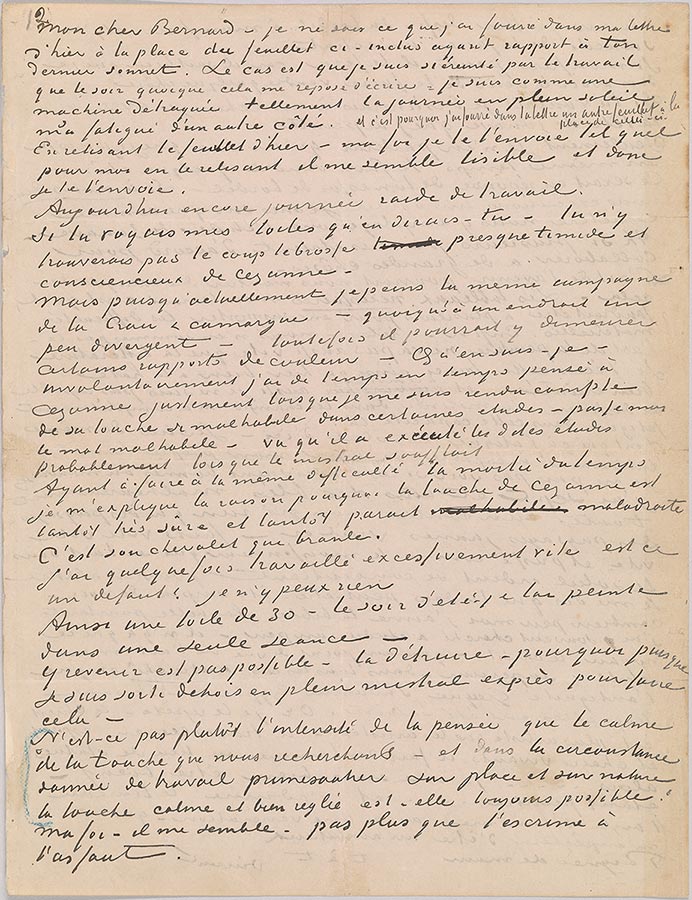
Vincent van Gogh, letter to Émile Bernard, Arles, 27 June 1888, Letter 9, page 1
Thaw Collection, given in honor of Charles E. Pierce, Jr., 2007
My dear Bernard—
I don't know what I stuck into my letter of yesterday instead of the enclosed sheet on the subject of
your last sonnet. The fact is that I am so worn out by work that in the evening—although writing
is restful for me—I'm like a broken-down machine, so much has the day in the full sun tired me
otherwise. And that's why I stuck another sheet into your letter instead of this one.
On rereading yesterday's sheet—well, I'm sending you it as it is; on rereading it, it seems legible
to me and so I'm sending you it.
Another hard day's work today.
If you saw my canvases, what would you say about them—you wouldn't find Cézanne's almost
diffident and conscientious brushstroke there.
But since at present I am painting the same countryside of La Crau and the Camargue—although in a slightly different place—nevertheless, certain color relationships could remain. What
do I know about it—from time to time I couldn't help thinking of Cézanne, particularly when I
realized that his touch is so clumsy in certain studies—disregard the word clumsy—seeing that he
probably executed those studies when the mistral was blowing.
Having to deal with the same difficulty half the time, I can explain why Cézanne's touch is
sometimes so sure and sometimes seems awkward. It's his easel that's wobbling.
I have sometimes worked excessively fast; is that a fault? I can't help it.
For example I've painted a no. 30 canvas—the summer evening—at a single sitting.
It's not possible to rework it; to destroy it—why, because I deliberately went outside to make it, out
in the mistral.
Isn't it rather intensity of thought than calmness of touch that we're looking for—and in the given
circumstances of impulsive work on the spot and from life, is a calm and controlled touch always possible?
Well—it seems to me—no more than fencing moves during an attack.
© 2007 Van Gogh Museum, Amsterdam
Letter 9, page 2
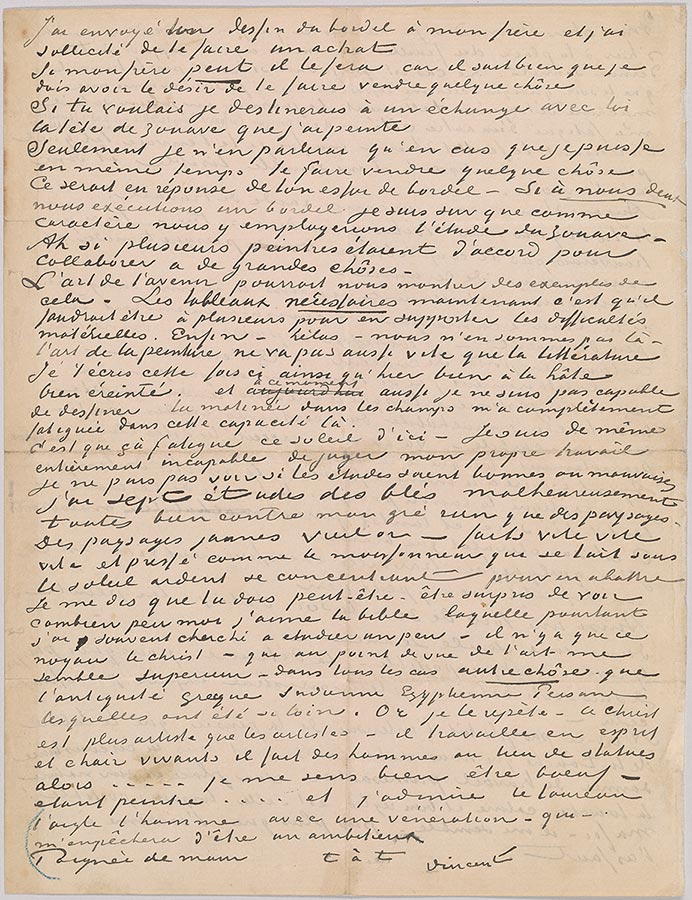
Vincent van Gogh, letter to Émile Bernard, Arles, 27 June 1888, Letter 9, page 2
Thaw Collection, given in honor of Charles E. Pierce, Jr., 2007
I have sent your drawing of the brothel to my brother, and I've asked him to buy something of yours.
If my brother can, he'll do it, because he knows very well that I must want to have you sell something.
If you wished, I would earmark for an exchange with you the head of a Zouave that I've painted.
But I won't speak about it unless I can have you sell something at the same time.
That would be in response to your attempt at a brothel. If we executed a brothel together, I'm sure
we would use the study of the Zouave as a character type in it. Ah, if several painters agreed to collaborate
on great things.
The art of the future might be able to show us examples of that. The thing is, for the paintings
that are needed now there would have to be several of us in order to cope with the material difficulties.
Well—alas—we're not at that point—the art of painting doesn't move as fast as literature.
Like yesterday, I'm writing to you this time in great haste, really worn out. And at this moment, too,
I'm not capable of drawing; the morning in the fields has tired me out completely in that capacity.
The thing is, it's tiring, the sun down here. I'm also utterly incapable of judging my own work. I can't
see whether the studies are good or bad. I have seven studies of wheat fields, unfortunately all of them
nothing but landscapes, much against my will. Old gold yellow landscapes—done quick quick quick and
in a hurry, like the reaper who is silent under the blazing sun, concentrating on getting the job done.
I tell myself that you may perhaps—be surprised to see how little I love the Bible myself, which
I have nevertheless often tried to study a little—there is only this kernel, Christ—who, from the
point of view of art, seems superior to me—at any rate something other—than Greek, Indian,
Egyptian, Persian antiquity, which went so far. Now I say it again—this Christ is more of an artist
than the artists—he works in living spirit and flesh, he makes men instead of statues, so . . . as a
painter I feel good being an ox . . . and I admire the bull, the eagle, the man, with a veneration—
which—will prevent my being a man of ambition.
Handshake.
Ever yours,
Vincent
© 2007 Van Gogh Museum, Amsterdam
Letter 9, page 3
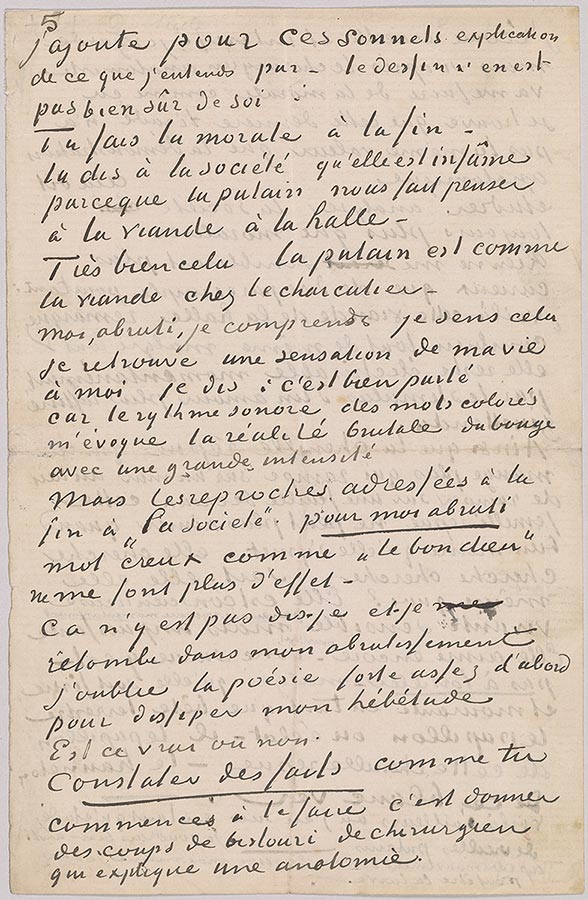
Vincent van Gogh, letter to Émile Bernard, Arles, 27 June 1888, Letter 9, page 3
Thaw Collection, given in honor of Charles E. Pierce, Jr., 2007
I add about these sonnets explanation of what I understand by—their design is not really sure
of itself:
You moralize at the end.
You tell society that it is squalid because the whore makes us think of meat, of the market.
Very good, that, the whore is like meat at the butcher's.
For myself—numbed—I understand, I feel that, I recognize a sensation from my own life, I
say: that's well said.
Because the sonorous rhythm of the colorful words suggests to me the brutal reality of the dive
with great intensity.
But the reproofs addressed at the end to "society." As for me, numbed, hollow words like "the
good Lord" no longer have any effect on me.
It isn't there, I say, and I sink into my numbness again; I forget the poem, at first strong enough to
dispel my lethargy.
Is that true or not?
To report the facts, as you do at the beginning, is to wield the lancet like a surgeon explaining anatomy.
>© 2007 Van Gogh Museum, Amsterdam
Letter 9, page 4
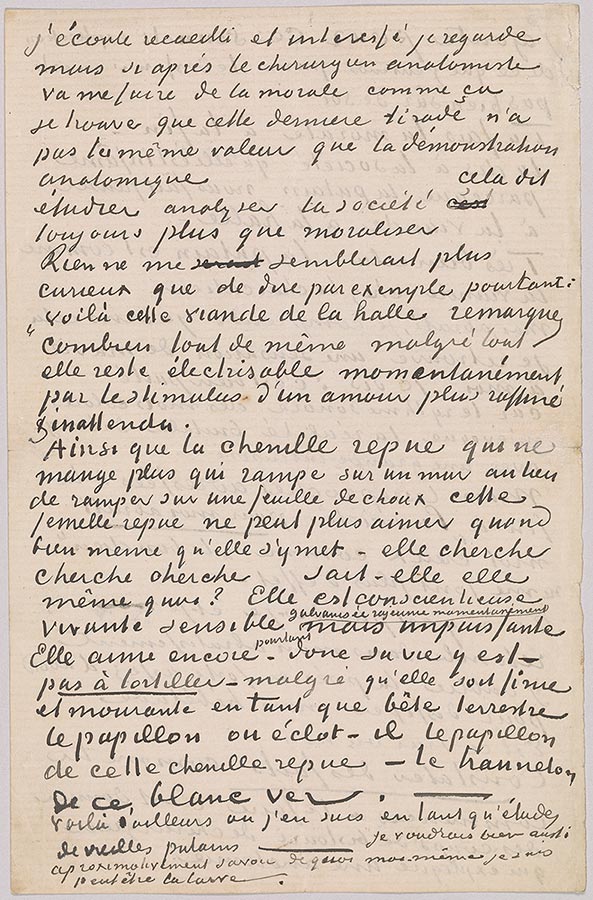
Vincent van Gogh, letter to Émile Bernard, Arles, 27 June 1888, Letter 9, page 4
Thaw Collection, given in honor of Charles E. Pierce, Jr., 2007
I listen, meditative and interested; I watch, but if, later, the surgeon-anatomist is going to moralize
at me like that, I find that that last tirade does not have the same value as the anatomy demonstration.
To study, to analyze society, that always says more than moralizing.
Nothing would seem more curious to me, however, than to say, for example: "see that meat from
the market, notice how, all the same, despite everything, it can still be electrified for a moment by the
stimulus of a love more refined and unexpected."
Like the sated caterpillar that no longer eats, that crawls on a wall instead of crawling on a cabbage
leaf, this sated female can no longer love, either, even though she goes about it—she seeks, seeks, seeks,
does she herself know what for? She's conscientious, alive, responsive, galvanized, rejuvenated for a
moment, but powerless. Yet she still loves—her life's there, then—make no bones about it—despite the
fact that she's finished and dying as an earthly creature. The butterfly, where does the butterfly emerge,
from that sated caterpillar—the cockchafer from that white grub?
Here, by the way, is where I am in terms of studies of old whores———I would also very much
like to know roughly what I am the larva of myself, perhaps.
© 2007 Van Gogh Museum, Amsterdam
Letter 10, page 1
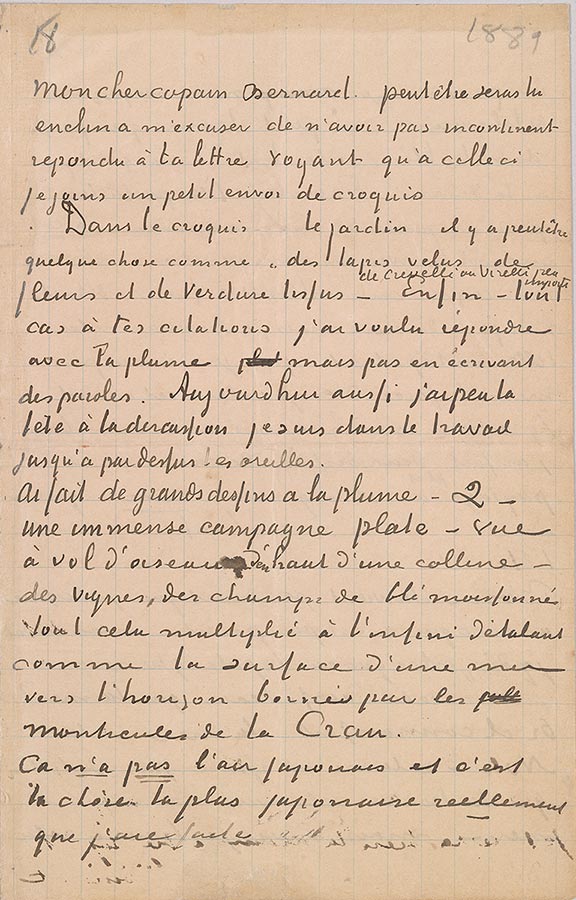
Vincent van Gogh, letter to Émile Bernard, Arles, 15 July 1888, Letter 10, page 1
Thaw Collection, given in honor of Charles E. Pierce, Jr., 2007
My dear old Bernard.
Perhaps you will be disposed to forgive me for not having replied to your letter straightaway, seeing
that I'm attaching a small batch of sketches to this one.
In the sketch The Garden, there is perhaps something like "the shaggy carpets of flowers and
woven greenery" of Crivelli or Virelli, doesn't much matter. Ah, well—in any case I wanted to reply
to your quotations with my pen, but not by writing words. Today, too, I don't have much of a head for
discussion; I'm up to my ears in work.
Have made large pen drawings—2—an immense flat expanse of country—seen in bird's-eye view
from the top of a hill—vineyards, reaped fields of wheat, all of it multiplied endlessly, streaming away
like the surface of a sea toward the horizon bounded by the hillocks of La Crau.
It does NOT look Japanese, and it's actually the most Japanese thing that I've done.
© 2007 Van Gogh Museum, Amsterdam
Letter 10, page 2
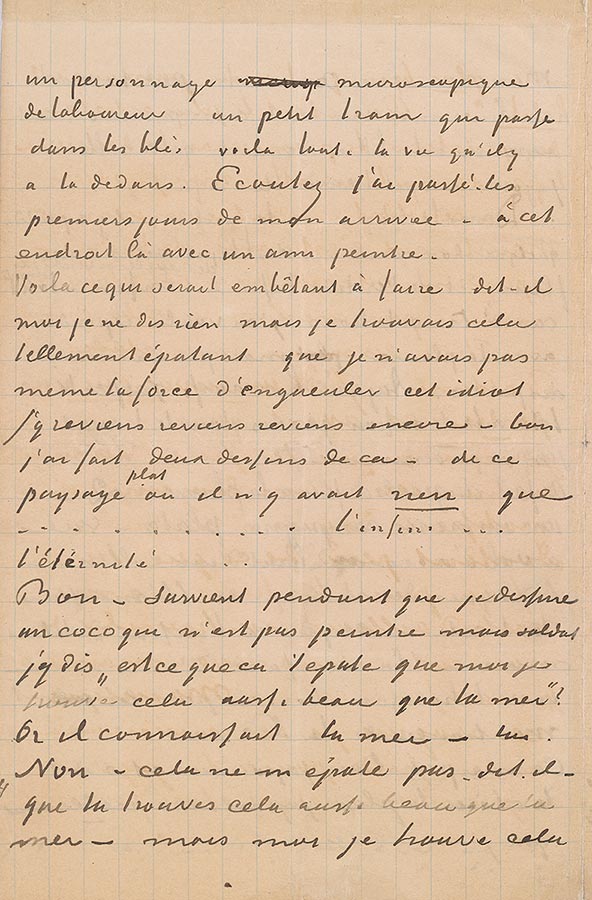
Vincent van Gogh, letter to Émile Bernard, Arles, 15 July 1888, Letter 10, page 2
Thaw Collection, given in honor of Charles E. Pierce, Jr., 2007
A microscopic figure of a plowman, a little train passing through the wheat fields; that's the only
life there is in it. Listen, I passed—a few days after my arrival—that place with a painter friend.
There's something that would be boring to do, he said. I said nothing myself, but I found that so
astonishing that I didn't even have the strength to give that idiot a piece of my mind. I go back there,
go back, go back again—well, I've done two drawings of it—of that flat landscape in which there was
nothing but . . . the infinite . . . eternity.
Well—while I'm drawing along comes a chap who isn't a painter but a soldier. I say, "Does it
astonish you that I find that as beautiful as the sea?" Now he knew the sea—that one. "No—it doesn't
astonish me"—he says—"that you find that
© 2007 Van Gogh Museum, Amsterdam
Letter 10, page 3
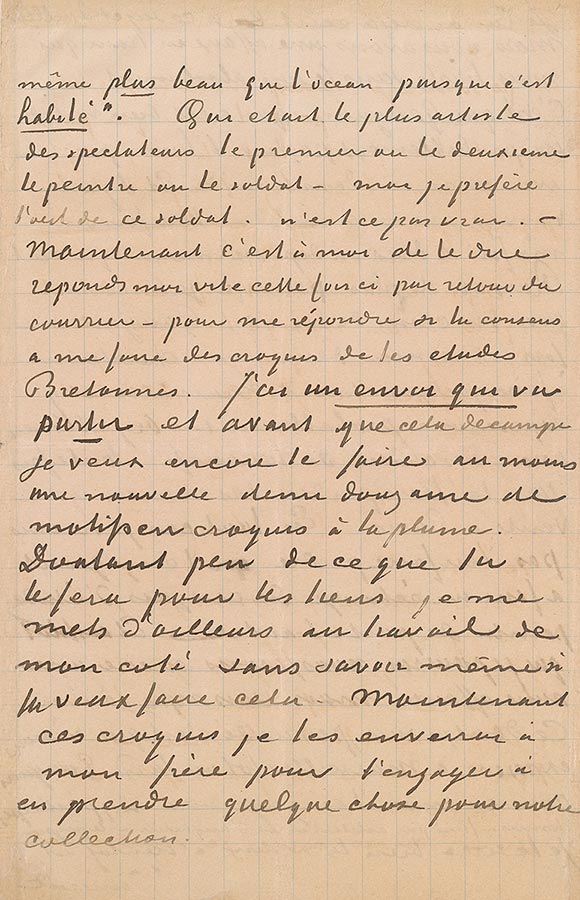
Vincent van Gogh, letter to Émile Bernard, Arles, 15 July 1888, Letter 10, page 3
Thaw Collection, given in honor of Charles E. Pierce, Jr., 2007
as beautiful as the sea—but I find it even more beautiful
than the ocean because it's inhabited." Which of the spectators was more the artist, the first or the
second, the painter or the soldier—I myself prefer that soldier's eye. Isn't that true?
Now it's my turn to say to you, reply to me quickly this time by return of post—to let me know
if you agree to make me some sketches of your Breton studies. I have a consignment that's about to
go off, and before it clears off I want to do at least another half a dozen subjects in pen sketches for
you. Having few doubts that you will do it for yours, I'm getting down to work on my side, anyway,
without even knowing if you want to do that. Now, I'll send these sketches to my brother, to urge
him to take something from them for our collection.
© 2007 Van Gogh Museum, Amsterdam
Letter 10, page 4
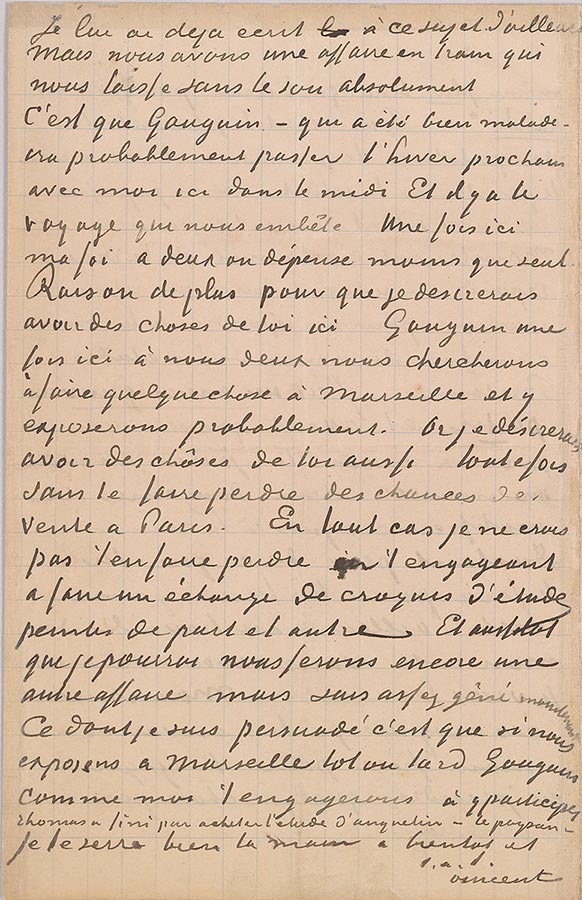
Vincent van Gogh, letter to Émile Bernard, Arles, 15 July 1888, Letter 10, page 4
Thaw Collection, given in honor of Charles E. Pierce, Jr., 2007
I've already written to him about that, anyway. But we're working on something that leaves us
absolutely without a sou.
The fact is that Gauguin—who has been very ill—is probably going to spend the coming winter
with me here in the south. And there's the fare, which is worrying us. Once here, well, two together
spend less than one alone. All the more reason why I should like to have some things by you here.
Once Gauguin's here, we'll try to do something together in Marseille, and will probably exhibit there.
Now I'd like to have some things by you, too, although without making you lose opportunities for
selling in Paris. In any case, I don't believe I'm making you lose them by encouraging you to exchange
sketches of painted studies between us. And as soon as I can, we'll do another piece of business as
well, but am quite hard up now. What I'm convinced of is that if we exhibit in Marseille, sooner or
later Gauguin and I will encourage you to join us.
Thomas bought Anquetin's study in the end—the peasant.
I shake your hand firmly, so long, and
Ever yours,
Vincent
© 2007 Van Gogh Museum, Amsterdam
Letter 12, page 1
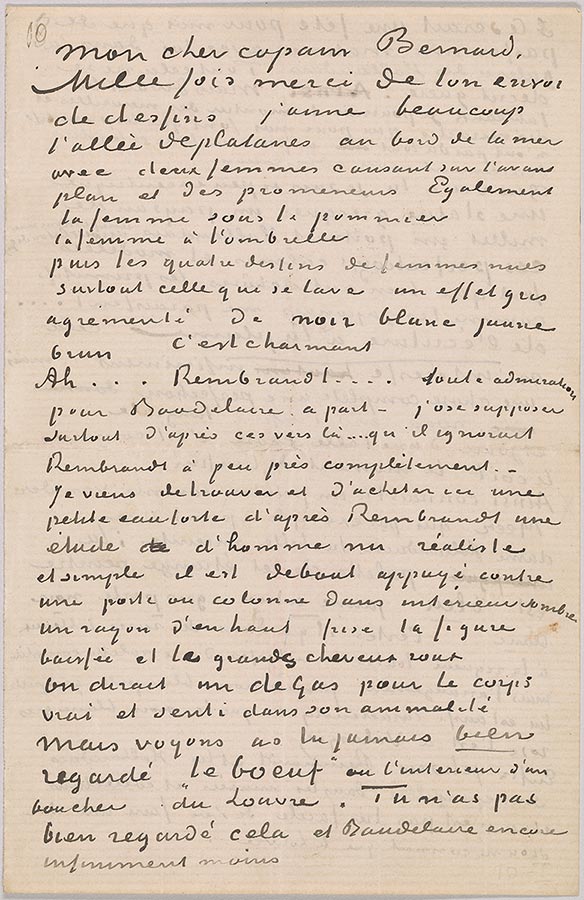
Vincent van Gogh, letter to Émile Bernard, Arles, 29 July 1888, Letter 12, page 1
Thaw Collection, given in honor of Charles E. Pierce, Jr., 2007
My dear old Bernard,
A thousand thanks for sending your drawings; I very much like the avenue of plane trees beside the
sea with two women chatting in the foreground and the promenaders. Also
the woman under the apple tree
the woman with the parasol
then the four drawings of nude women, especially the one washing herself, a gray effect embellished
with black, white, yellow, brown. It's charming.
Ah . . . Rembrandt . . . all admiration for Baudelaire aside—I venture to assume, especially on the
basis of those verses . . . that he knew more or less nothing about Rembrandt. I have just found and
bought here a little etching after Rembrandt, a study of a nude man, realistic and simple; he's standing,
leaning against a door or column in a dark interior. A ray of light from above skims his downturned
face and the bushy red hair.
You'd think it a Degas for the body, true and felt in its animality.
But see, have you ever looked closely at "The Ox" or the Interior of a Butcher's Shop in the Louvre?
You haven't looked closely at them, and Baudelaire infinitely less so.
© 2007 Van Gogh Museum, Amsterdam
Letter 12, page 2
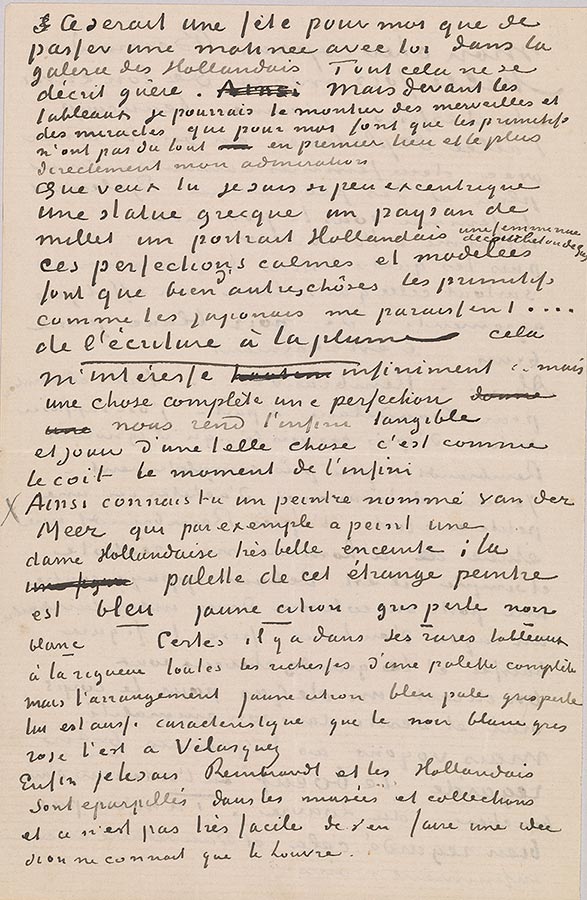
Vincent van Gogh, letter to Émile Bernard, Arles, 29 July 1888, Letter 12, page 2
Thaw Collection, given in honor of Charles E. Pierce, Jr., 2007
It would be a treat for me to spend a morning with you in the Dutch gallery. All that is barely
describable. But in front of the paintings I could show you marvels and miracles that are the reason
that, for me, the primitives really don't have my admiration first and foremost and most directly.
But there you are; I'm so far from eccentric. A Greek statue, a peasant by Millet, a Dutch portrait, a
nude woman by Courbet or Degas, these calm and modeled perfections are the reason that many other
things, the primitives as well as the Japanese, seem to me . . . like WRITING WITH A PEN; they interest me
infinitely . . . but something complete, a perfection, makes the infinite tangible to us.
And to enjoy such a thing is like coitus, the moment of the infinite.
For instance, do you know a painter called Vermeer, who, for example, painted a very beautiful
Dutch lady, pregnant? This strange painter's palette is blue, lemon yellow, pearl gray, black, white. Of
course, in his few paintings there are, if it comes to it, all the riches of a complete palette, but the
arrangement of lemon yellow, pale blue, pearl gray is as characteristic of him as the black, white, gray,
pink is of Velázquez.
Anyway, I know, Rembrandt and the Dutch are scattered around museums and collections, and
it's not very easy to form an idea of them if you only know the Louvre.
© 2007 Van Gogh Museum, Amsterdam
Letter 12, page 3
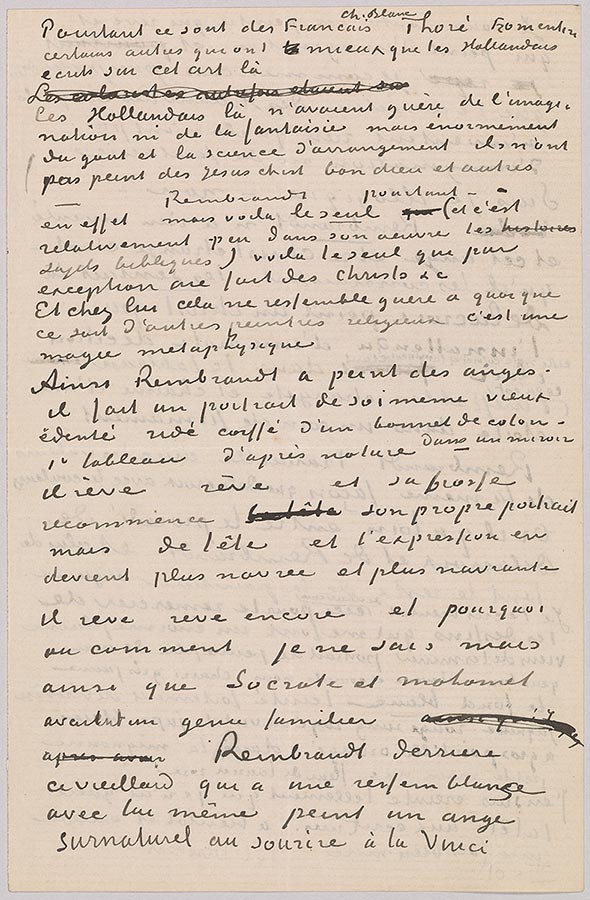
Vincent van Gogh, letter to Émile Bernard, Arles, 29 July 1888, Letter 12, page 3
Thaw Collection, given in honor of Charles E. Pierce, Jr., 2007
However, it's Frenchmen, C. Blanc, Thoré, Fromentin, certain others who have written better
than the Dutch on that art.
Those Dutchmen had scarcely any imagination or fantasy but great taste and the art of arrangement;
they did not paint Jesus Christs, the Good Lord and others. Rembrandt though—indeed, but
he's the only one (and there are relatively few biblical subjects in his oeuvre), he's the only one who,
as an exception, did Christs, etc.
And in his case, they hardly resemble anything by other religious painters; it's a metaphysical magic.
So, Rembrandt painted angels—he makes a portrait of himself as an old man, toothless, wrinkled,
wearing a cotton cap—first, painting from life in a mirror—he dreams, dreams, and his brush
begins his own portrait again, but from memory, and its expression becomes sadder and more
saddening; he dreams, dreams on, and why or how I do not know, but just as Socrates and Mohammed
had a familiar genie, Rembrandt, behind this old man who bears a resemblance to himself, paints a
supernatural angel with a da Vinci smile.
© 2007 Van Gogh Museum, Amsterdam
Letter 12, page 4
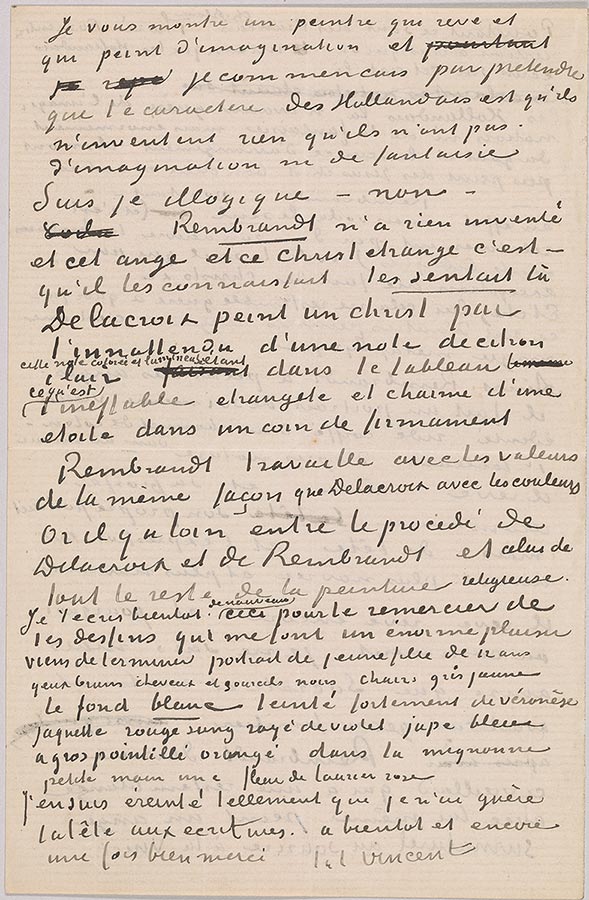
Vincent van Gogh, letter to Émile Bernard, Arles, 29 July 1888, Letter 12, page 4
Thaw Collection, given in honor of Charles E. Pierce, Jr., 2007
I'm showing you a painter who dreams and who paints from the imagination, and I started off by
claiming that the character of the Dutch is that they invent nothing, that they have neither imagination
nor fantasy.
Am I illogical? No. Rembrandt invented nothing, and that angel and that strange Christ; it's—
that he knew them, felt them there.
Delacroix paints a Christ using an unexpected light lemon note, this colorful and luminous note
in the painting being what the ineffable strangeness and charm of a star is in a corner of the firmament.
Rembrandt works with values in the same way as Delacroix with colors.
Now, there's a gulf between the method of Delacroix and Rembrandt and that of all the rest of
religious painting.
I 'll write to you again soon. This to thank you for your drawings, which give me enormous pleasure.
Have just finished portrait of young girl of twelve, brown eyes, black hair and eyebrows, flesh yellow
gray, the background white, strongly tinged with veronese, jacket blood-red with violet stripes, skirt
blue with large orange spots, an oleander flower in her sweet little hand.
I'm so worn out from it that I hardly have a head for writing. So long, and again, many thanks.
Ever yours,
Vincent
© 2007 Van Gogh Museum, Amsterdam
Letter 13, page 1
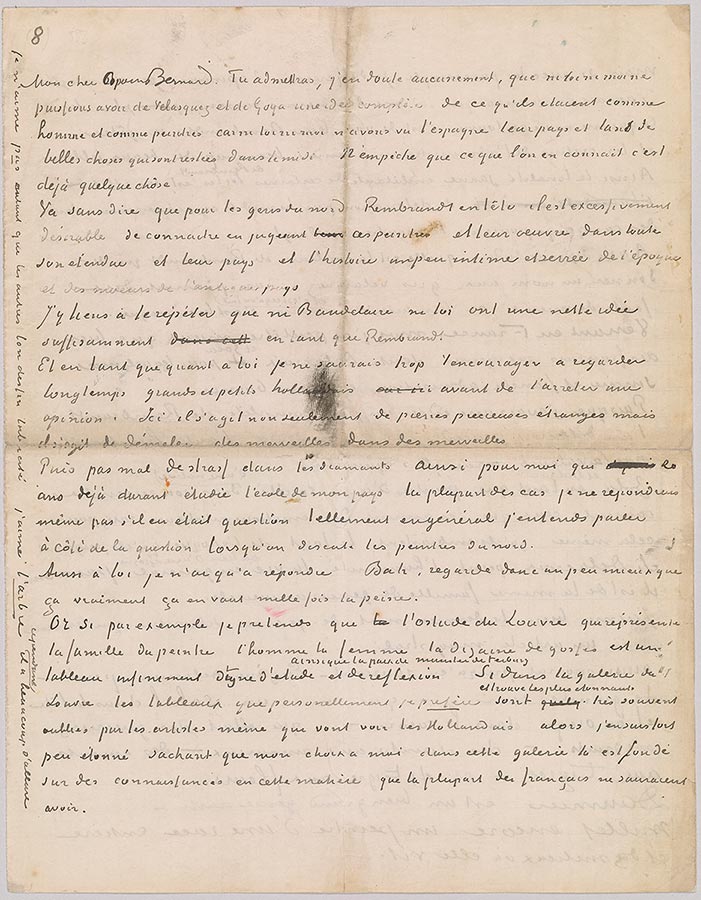
Vincent van Gogh, letter to Émile Bernard, Arles, 30 July 1888, Letter 13, page 1
Thaw Collection, given in honor of Charles E. Pierce, Jr., 2007
My dear old Bernard.
You'll agree, I've no doubt at all, that neither you nor I can have a full idea of what Velázquez and
Goya were like as men and as painters, because neither you nor I have seen Spain, their country,
and so many fine things that have remained in the south. Even so, what we know of them does
count for something in itself.
It goes without saying that for the northerners, Rembrandt first and foremost, it is extremely
desirable, when judging these painters, to know both their work in its full extent and their country,
and the rather intimate and hidden history of those days, and of the customs of the ancient country.
I want to repeat to you that neither Baudelaire nor you has a sufficiently clear idea when it
comes to Rembrandt.
And when it comes to you, I could not encourage you enough to take a long look at major
and minor Dutchmen before arriving at an opinion. Here it's not just a matter of strange precious
stones, but it's a matter of sorting out marvels from among marvels.
And a fair amount of paste from among the diamonds. Thus for myself, having been studying
my country's school for twenty years now, in most cases I wouldn't even reply if the subject came
up, so much do I generally hear people talk beside the point when the painters of the north are
being discussed.
So to you I can only reply, come on, just look a little more closely than that; really, it's worth
the effort a thousand times over.
Now if, for example, I claim that the van Ostade in the Louvre, which shows the painter's family,
the man, the wife, the ten or so kids, is a painting infinitely deserving of study and thought,
just like ter Borch's Peace of Münster. If the paintings in the gallery in the Louvre that I personally
prefer and find the most astonishing are very often forgotten by the very artists who go to see the
Dutchmen, then I'm not in the least surprised, knowing that my own choice in that gallery is based
on a knowledge of this subject that most of the French could not have.
© 2007 Van Gogh Museum, Amsterdam
Letter 13, page 2
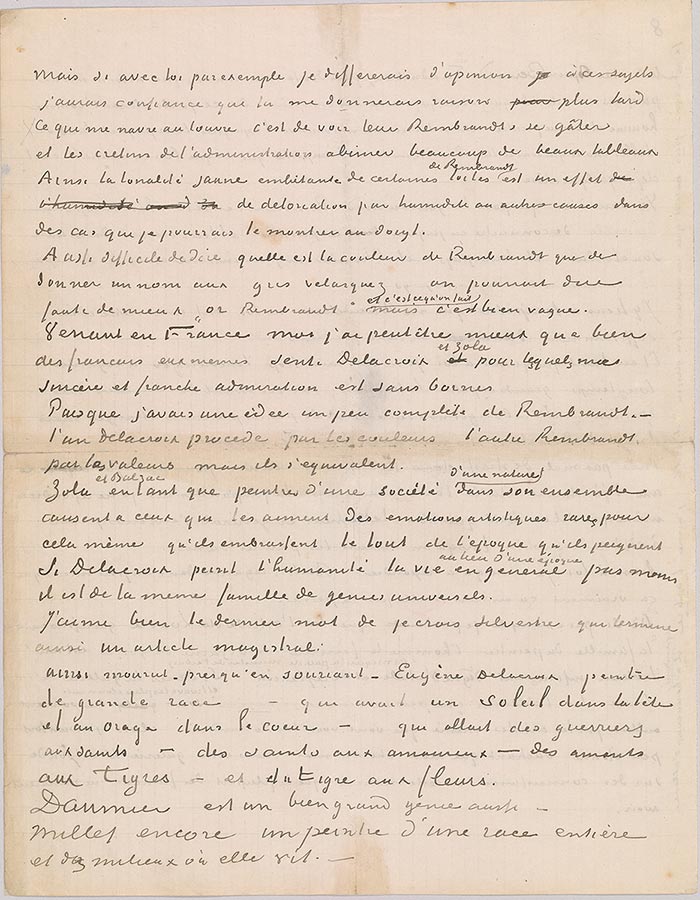
Vincent van Gogh, letter to Émile Bernard, Arles, 30 July 1888, Letter 13, page 2
Thaw Collection, given in honor of Charles E. Pierce, Jr., 2007
But if, for example, my opinion differed from yours on those subjects, I'm confident that you
would agree with me later. What grieves me at the Louvre is to see their Rembrandts getting spoiled
and the cretins in the administration damaging many beautiful paintings. Thus the annoying yellow
tonality of certain canvases by Rembrandt is an effect of deterioration through humidity or
other causes, instances of which I could point out to you.
As difficult to say what Rembrandt's color is as to give a name to the Velázquez grays; we could
say, for want of something better, "Rembrandt gold," and that's what we do, but that's quite vague.
Having come to France I have, perhaps better than many Frenchmen themselves, felt Delacroix
and Zola, for whom my sincere and frank admiration is boundless.
Since I had a fairly complete idea of Rembrandt. One, Delacroix, proceeds by way of colors,
the other, Rembrandt, by values, but they are on a par.
Zola and Balzac, as painters of a society, of reality as a whole, arouse rare artistic emotions in
those who love them, for the very reason that they embrace the whole epoch that they paint. When
Delacroix paints humanity, life in general instead of an epoch, he belongs to the same family of
universal geniuses all the same.
I love the closing words of Silvestre, I think it was, who ends a masterly article like this:
Thus died—almost smiling—Eugène Delacroix, a painter of high breeding—who had a sun
in his head and a thunderstorm in his heart—who went from warriors to saints—from saints to
lovers—from lovers to tigers—and from the tiger to flowers.
Daumier is also a really great genius.
Millet, another painter of an entire race and the settings in which it lives.
© 2007 Van Gogh Museum, Amsterdam
Letter 13, page 3
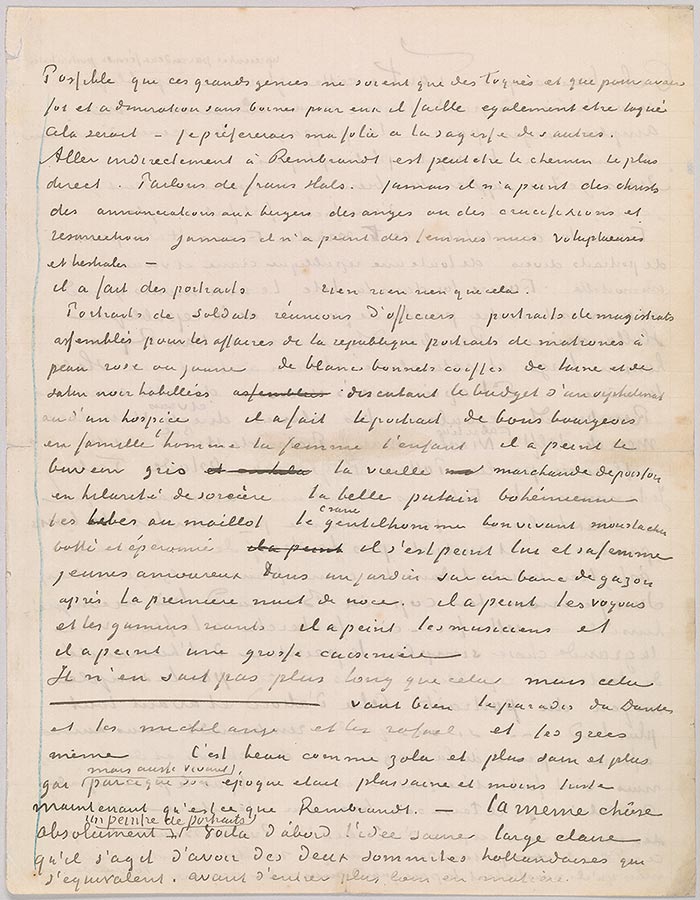
Vincent van Gogh, letter to Émile Bernard, Arles, 30 July 1888, Letter 13, page 3
Thaw Collection, given in honor of Charles E. Pierce, Jr., 2007
Possible that these great geniuses are no more than loonies, and that to have faith and boundless
admiration for them you'd have to be a loony too. That may well be—I would prefer my madness
to other people's wisdom.
To go to Rembrandt indirectly is perhaps the most direct route. Let's talk about Frans Hals.
Never did he paint Christs, annunciations to shepherds, angels or crucifixions and resurrections;
never did he paint voluptuous and bestial naked women.
He painted portraits; nothing nothing nothing but that.
Portraits of soldiers, gatherings of officers, portraits of magistrates assembled for the business
of the republic, portraits of matrons with pink or yellow skin, wearing white bonnets, dressed in
wool and black satin, discussing the budget of an orphanage or an almshouse; he did portraits of
good citizens with their families, the man, his wife, his child; he painted the sozzled drinker,
the old fishwife full of a witch's mirth, the beautiful gypsy whore, babies in swaddling clothes,
the gallant, bon vivant gentleman, mustachioed, booted and spurred; he painted himself and
his wife as young lovers on a turf bench in a garden, after their first wedding night. He painted
guttersnipes and laughing urchins, he painted musicians and he painted a fat cook.
He doesn't know much more than that, but it's———————well worth Dante's Paradise
and the Michelangelos and Raphaels and even the Greeks. It's beautiful like Zola, and healthier
and more cheerful, but just as alive, because his epoch was healthier and less sad. Now what is
Rembrandt? The same thing entirely—a painter of portraits. That's the healthy, broad, clear idea
that one must have first of all of the two eminent Dutchmen, who are on a par, before going into
the subject more deeply.
© 2007 Van Gogh Museum, Amsterdam
Letter 13, page 4
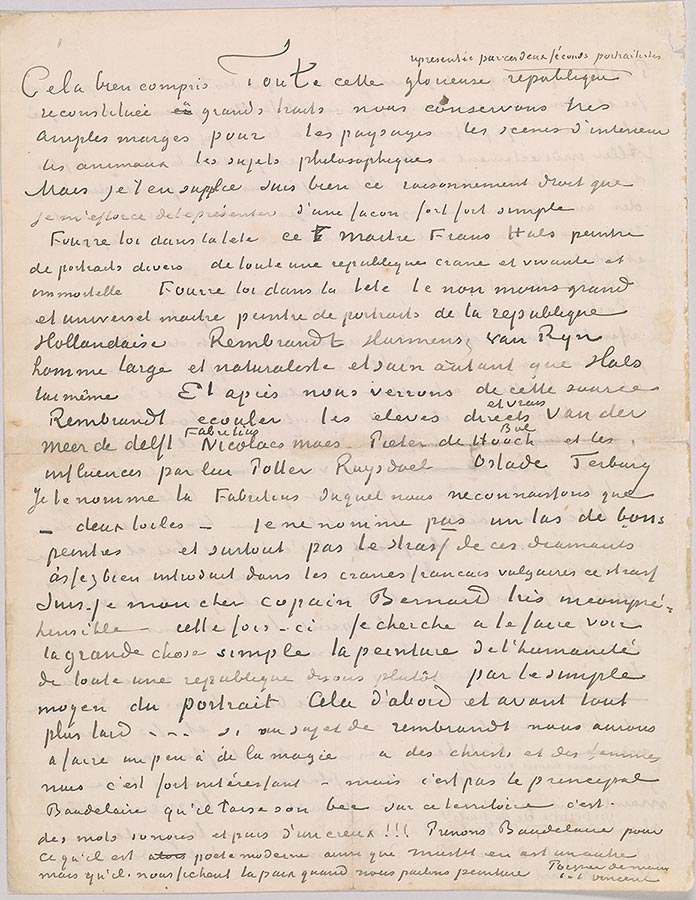
Vincent van Gogh, letter to Émile Bernard, Arles, 30 July 1888, Letter 13, page 4
Thaw Collection, given in honor of Charles E. Pierce, Jr., 2007
This fully understood, ALL this glorious republic, represented by these two prolific portraitists,
re-created in broad strokes, we retain very wide margins for landscapes, interior scenes, animals,
philosophical subjects.
But I beg you, carefully follow this straightforward argument, which I am doing my utmost to
present to you in a very very simple way.
Get him into your head, this Master Frans Hals, painter of various portraits of a whole selfassured
and lively and immortal republic. Get into your head the no less great and universal master
portrait painter of the Dutch republic, Rembrandt Harmensz. van Rijn, a broad and naturalistic
and healthy man, as much as Hals himself. And after that we'll see flowing from that source, Rembrandt,
the direct and true pupils, Vermeer of Delft, Fabritius, Nicolaas Maes, Pieter de Hooch, Bol;
and those influenced by him, Potter, Ruisdael, Ostade, ter Borch. I mention Fabritius to you there,
by whom we know only—two canvases—I don't mention a heap of good painters, and especially
not the paste of these diamonds, paste firmly embedded in ordinary French skulls.
Am I, my dear old Bernard, terribly incomprehensible this time? I'm trying to make you see
the great simple thing, the painting of humanity, let us rather say of a whole republic, through the
simple medium of the portrait. This first and foremost; later———if, on the subject of Rembrandt,
we're dealing to some extent with magic, with Christs and nude women, it's very interesting—but
it's not the main thing. Let Baudelaire hold his tongue in this department, they're resounding
words, and how hollow!!! Let's take Baudelaire for what he is, a modern poet just as Musset is
another, but let them leave us alone when we're talking painting.
Handshake.
Ever yours,
Vincent
I don't like your drawing Lubricity as much as the others; I like the tree, however, it has a great look.
© 2007 Van Gogh Museum, Amsterdam
Letter 14, page 1
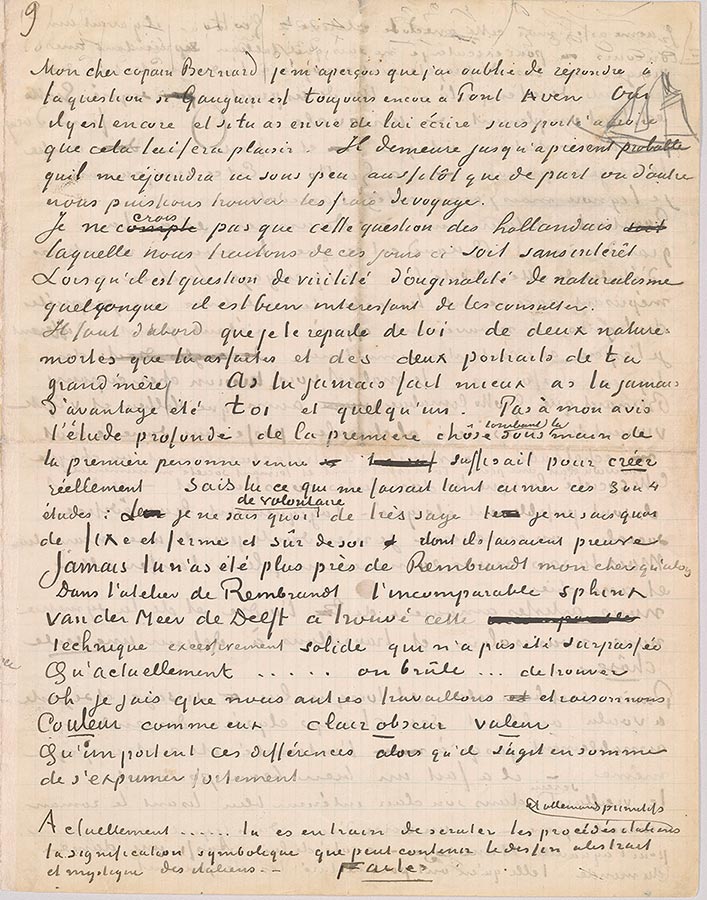
Vincent van Gogh, letter to Émile Bernard, Arles, 5 August 1888, Letter 14, page 1
Thaw Collection, given in honor of Charles E. Pierce, Jr., 2007
My dear old Bernard,
I realize that I've forgotten to answer your question as to whether Gauguin is still in Pont-Aven.
Yes, he's still there, and if you feel like writing to him am inclined to believe that it will please him.
It is still likely that he will join me here shortly, as soon as either one of us is able to find the travel
expenses.
I do not believe that this question of the Dutchmen, which we're discussing these days, is without
interest. It is quite interesting to consult them when it's a matter of any kind of virility, originality,
naturalism.
In the first place, I must speak to you again about yourself, about two still lifes that you have
done, and about the two portraits of your grandmother. Have you ever done better, have you ever
been more yourself, and somebody? Not in my opinion. Profound study of the first thing to come
to hand, of the first person to come along, was enough to really create something. Do you know
what made me like these three or four studies so much? That je ne sais quoi of something deliberate,
very wise, that je ne sais quoi of something steady and firm and sure of oneself, which they
show. You have never been closer to Rembrandt, my dear chap, than then. In Rembrandt's studio,
the incomparable sphinx, Vermeer of Delft, found this extremely sound technique that has not
been surpassed. Which today . . . we're burning . . . to find. Oh, I know that we are working and
arguing COLOR as they did chiaroscuro, value.
What do these differences matter when in the end it's a question of expressing oneself powerfully?
At present . . . you're examining primitive Italian and German techniques, the symbolic meaning
that the Italians' abstract and mystical drawing may contain. Do so.
© 2007 Van Gogh Museum, Amsterdam
Letter 14, page 2
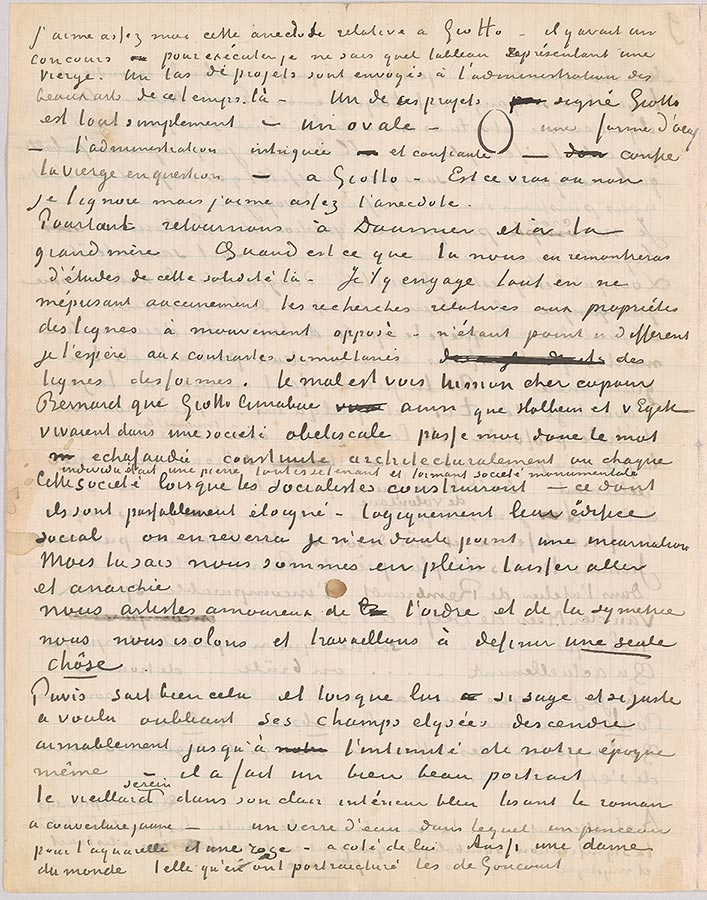
Vincent van Gogh, letter to Émile Bernard, Arles, 5 August 1888, Letter 14, page 2
Thaw Collection, given in honor of Charles E. Pierce, Jr., 2007
I myself rather like this anecdote about Giotto—there was a competition for the execution of
some painting or other of a Virgin. Lots of proposals were sent to the fine arts authorities of those
days. One of these proposals, signed Giotto, was simply—an oval—[sketch] an egg shape—the
authorities, intrigued and trusting—entrust the Virgin in question—to Giotto. Whether it's true
or not, I don't know, but I rather like the anecdote.
However, let's return to Daumier and to your grandmother. When are you going to show us
more of them, studies of that soundness? I urge you to do so, while at the same time in no way
belittling your investigations concerning the properties of lines in contrary motion—being not at
all indifferent, I hope, to the simultaneous contrasts of lines, of forms. The trouble is, do you see,
my dear old Bernard, that Giotto, Cimabue, as well as Holbein and van Eyck, lived in an obeliscal—
if you'll pardon the expression—society, layered, architecturally constructed, in which each
individual was a stone, all of them holding together and forming a monumental society. I have
no doubt that we'll again see an incarnation of this society when the socialists logically build their
social edifice—from which they're a fair distance away yet. But you know we're in a state of total
laxity and anarchy.
We, artists in love with order and symmetry, isolate ourselves and work to define one single
thing.
Puvis knows that very well, and when he, so wise and so just, decided to descend goodnaturedly
into the intimacy of our very own epoch, forgetting his Elysian Fields, he made a
very fine portrait, the serene old man in his bright, blue interior, reading the novel with a yellow
cover—a glass of water beside him, in which a watercolor brush and a rose. And also a society lady,
like those the de Goncourts portrayed.
© 2007 Van Gogh Museum, Amsterdam
Letter 14, page 3
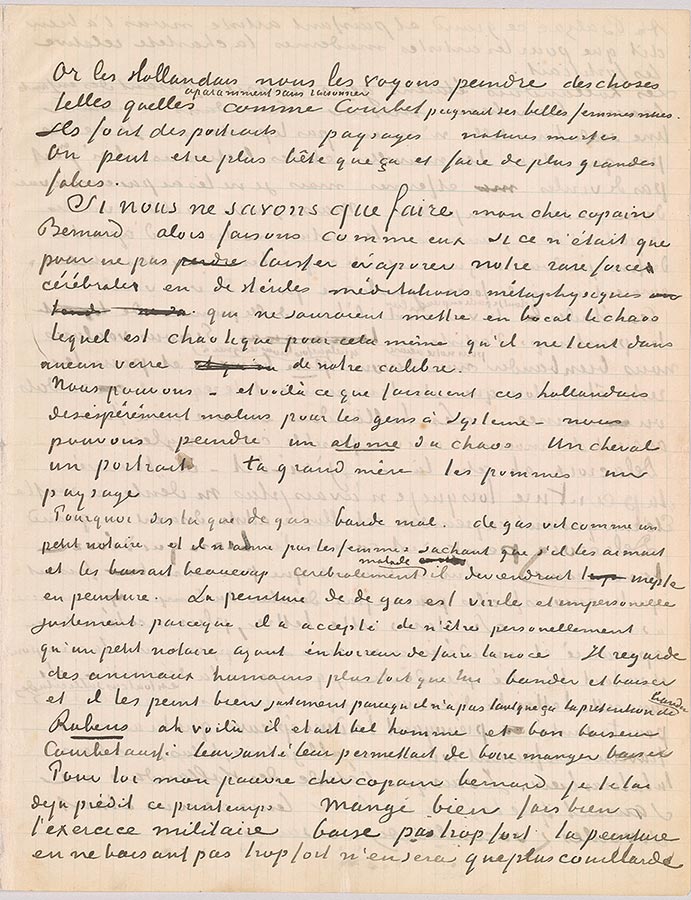
Vincent van Gogh, letter to Émile Bernard, Arles, 5 August 1888, Letter 14, page 3
Thaw Collection, given in honor of Charles E. Pierce, Jr., 2007
The Dutchmen, now, we see them painting things just as they are, apparently without thought,
the way Courbet painted his beautiful naked women.
They make portraits, landscapes, still lifes. One could be stupider than that and commit greater
follies.
If we do not know what to do, my dear old Bernard, then let's do the same as they, if only so as
not to allow our scarce mental powers to evaporate in sterile metaphysical meditations that aren't
up to bottling chaos, which is chaotic for the very reason that it won't fit into any glass of our caliber.
We can—and that's what those Dutchmen did, desperately clever in the eyes of people wedded
to system—we can paint an atom of chaos. A horse, a portrait, your grandmother, apples, a landscape.
Why do you say that Degas has trouble getting a hard-on? Degas lives like a little lawyer, and he
doesn't like women, knowing that if he liked them and fucked them a lot he would become cerebrally
ill and hopeless at painting. Degas's painting is virile and impersonal precisely because he has
resigned himself to being personally no more than a little lawyer, with a horror of riotous living. He
watches human animals stronger than himself getting a hard-on and fucking, and he paints them
well, precisely because he doesn't make such great claims about getting a hard-on.
Rubens, ah, there you have it, he was a handsome man and a good fucker, Courbet too;
their health allowed them to drink, eat, fuck.
In your case, my poor dear old Bernard, I already told you last spring. Eat well, do your military
drill well, don't fuck too hard; if you don't fuck too hard, your painting will be all the spunkier
for it.
© 2007 Van Gogh Museum, Amsterdam
Letter 14, page 4
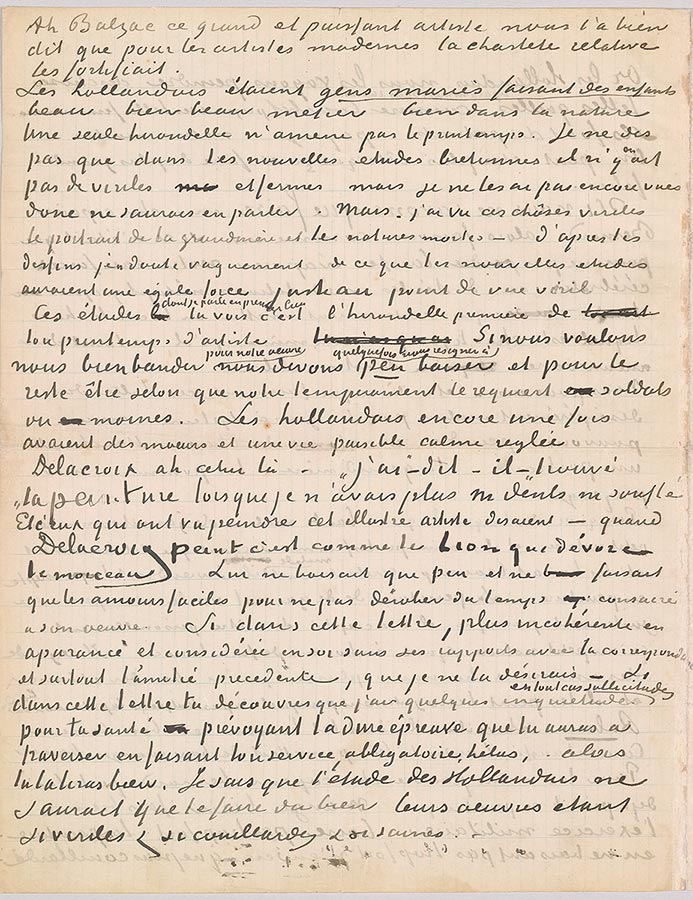
Vincent van Gogh, letter to Émile Bernard, Arles, 5 August 1888, Letter 14, page 4
Thaw Collection, given in honor of Charles E. Pierce, Jr., 2007
Ah, Balzac, that great and powerful artist, already told us very well that for modern artists a
certain chastity made them stronger.
The Dutchmen were married people making children, a beautiful, very beautiful occupation,
very natural.
One swallow doesn't make a summer. I'm not saying that among your new Breton studies there
aren't some virile and strong ones, but I haven't seen them yet and so wouldn't be able to talk about
them. But—I have seen those virile things, the portrait of your grandmother and the still lifes—
judging from your drawings I have vague doubts whether these new studies would have the same
vigor, just from the virile point of view.
These studies that I'm talking about first, you see it's the first swallow of your summertime as
an artist. If we want, ourselves, to get a hard-on for our work, we must sometimes resign ourselves
to fucking only a little, and for the rest to be, according as our temperament demands, soldiers or
monks. The Dutchmen, once again, had morals, and a quiet, calm, well-ordered life.
Delacroix, ah, him—"I," he said, "found painting when I had no teeth nor breath left." And
those who saw this famous artist paint said: when Delacroix paints it's like the lion devouring his
piece of flesh. He fucked only a little, and had only casual love affairs so as not to filch from the
time devoted to his work. If in this letter, on the face of it more incoherent, and taken on its own
without its connections to the previous correspondence and above all, friendship, than I should
wish—If in this letter you find that I have some anxieties—concerns in any case—for your health,
foreseeing the hard ordeal that you'll have to go through in doing your service, obligatory, alas,—
then you will read it correctly. I know that the study of the Dutchmen could only do you good,
their works being so virile and so spunky and so healthy.
© 2007 Van Gogh Museum, Amsterdam
Letter 14, page 5
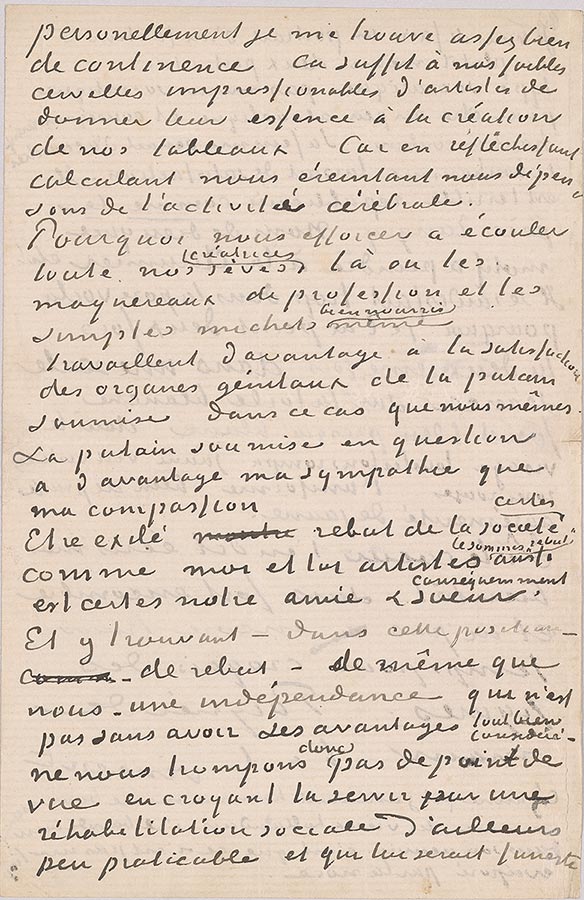
Vincent van Gogh, letter to Émile Bernard, Arles,5 August 1888, Letter 14, page 5
Thaw Collection, given in honor of Charles E. Pierce, Jr., 2007
Personally, I find continence is quite good for me. It's enough for our weak, impressionable
artists' brains to give their essence to the creation of our paintings. Because in thinking, calculating,
wearing ourselves out, we expend cerebral activity.
Why exert ourselves in spending all our creative juices when those who pimp for a living
and even their simple, well-fed clients work more to the satisfaction of the genital organs of the
registered whore in this case than we do? The whore in question has my sympathy more than my
compassion.
Being exiled, a social outcast, as artists like you and I surely are, also "outcasts," she is surely
therefore our friend and sister. And finding—in this position—of outcast—the same as us—an
independence that is not without its advantages—all things considered—let's not adopt a false
position by believing we're serving her through social rehabilitation, which is in any case impractical
and would be fatal for her.
© 2007 Van Gogh Museum, Amsterdam
Letter 14, page 6
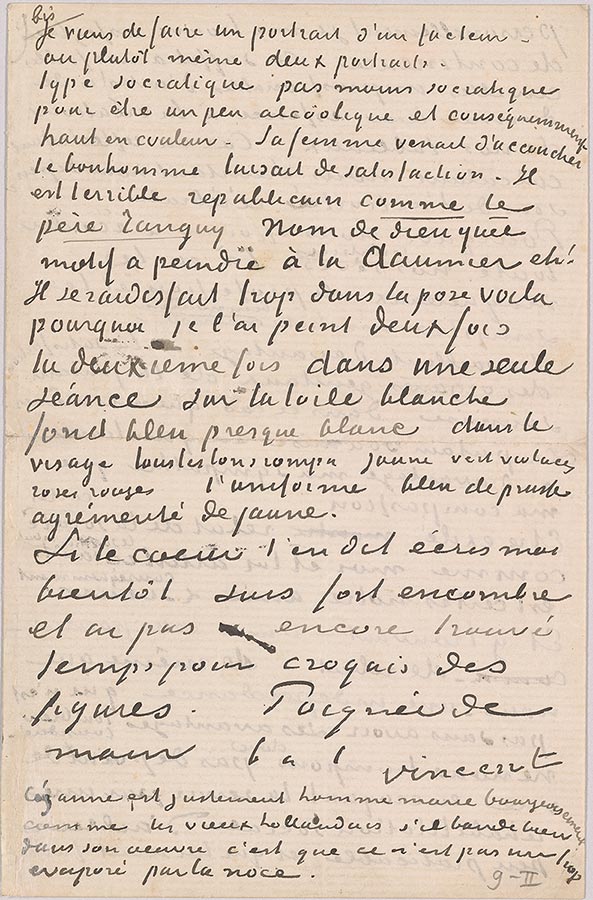
Vincent van Gogh, letter to Émile Bernard, Arles, 5 August 1888, Letter 14, page 6
Thaw Collection, given in honor of Charles E. Pierce, Jr., 2007
I have just made a portrait of a postman—or rather, two portraits even—Socratic type, no
less Socratic for being something of an alcoholic, and with a high color as a result. His wife had
just given birth, the good fellow was glowing with satisfaction. He's a fierce republican, like père
Tanguy. Goddamn, what a subject to paint à la Daumier, eh? He was getting too stiff while posing,
and that's why I painted him twice, the second time at a single sitting, on white canvas, background
blue, almost white, in the face all the broken tones: yellow, green, purples, pinks, reds, the uniform
Prussian blue trimmed with yellow.
Write to me soon if you feel like it; am very encumbered and have not yet found time for figure
sketches. Handshake
Yours,
Vincent
Cézanne is as much a respectably married man as the old Dutchmen were. If he has a good hard-on
in his work it's because he's not overly dissipated through riotous living.
© 2007 Van Gogh Museum, Amsterdam
Letter 16, page 1
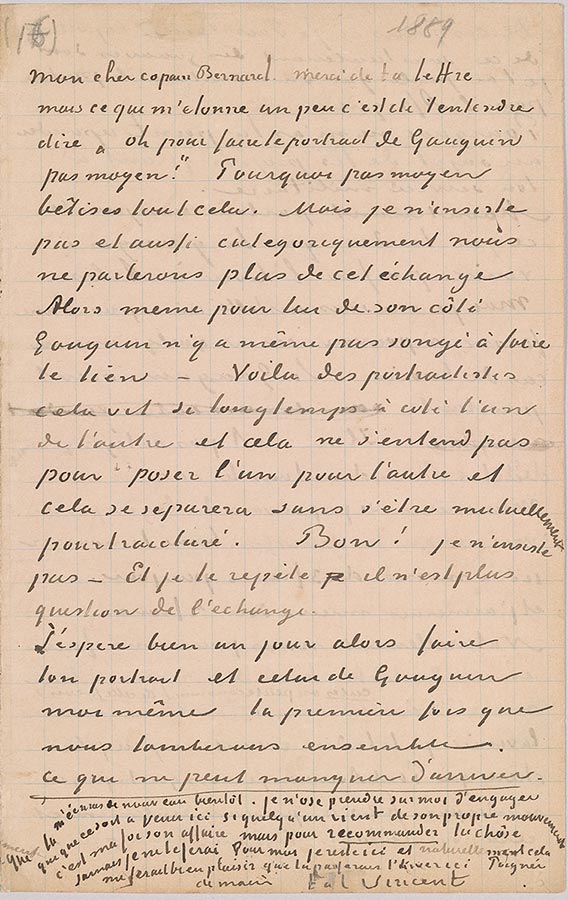
Vincent van Gogh, letter to Émile Bernard, Arles, 25 September 1888, Letter 16, page 1
Thaw Collection, given in honor of Charles E. Pierce, Jr., 2007
My dear old Bernard.
Thanks for your letter, but what surprises me a little is to hear you say, "Oh, no way of doing
Gauguin's portrait!" Why no way? That's all rubbish. But I'm not pressing the point, and so we categorically
won't mention that exchange any more. So even Gauguin, for his own part, hasn't even
thought of doing yours. Here you have portraitists, living for so long side by side and they don't
agree on posing for each other and they'll separate without having portrayed each other. Well! I'm
not pressing the point. And I repeat, there's no longer a question of an exchange.
So I really hope to do your portrait and Gauguin's myself one day, the first time we get together.
Which is bound to happen.
© 2007 Van Gogh Museum, Amsterdam
Letter 16, page 2
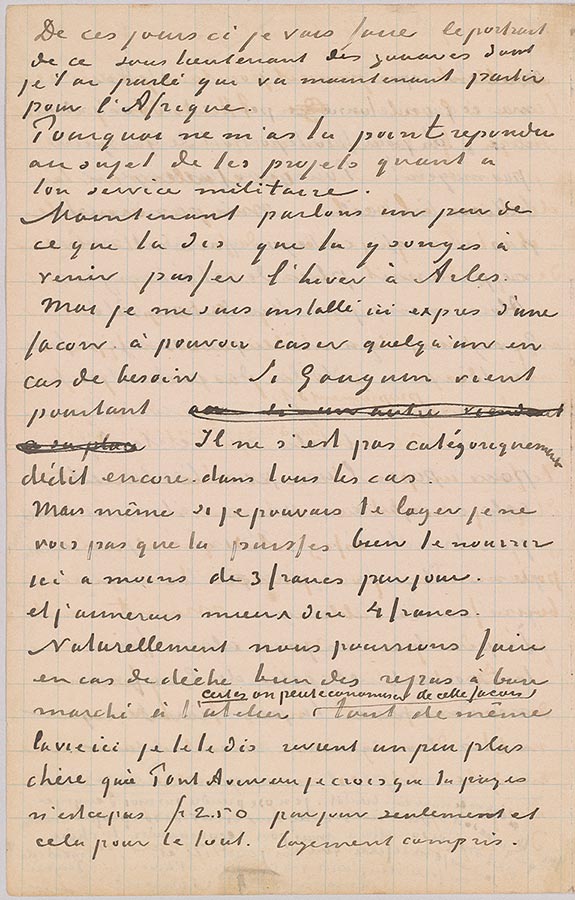
Vincent van Gogh, letter to Émile Bernard, Arles, 25 September 1888, Letter 16, page 2
Thaw Collection, given in honor of Charles E. Pierce, Jr., 2007
One of these days I'm going to do the portrait of that second lieutenant of Zouaves whom I've
spoken to you about, who's now on the point of leaving for Africa.
Why have you not replied to me about your plans regarding your military service?
Now let's talk a little about what you say, that you're thinking of coming to spend the winter in
Arles. I have deliberately set myself up here in such a way as to be able to fit someone in if necessary.
If Gauguin comes, however. He still hasn't categorically said no, in any case.
But even if I could put you up, I don't see that you could feed yourself well here for less than
3 francs a day. And I'd prefer to say 4 francs. Naturally, in the case of being broke, we could make
many meals cheaply at the studio, certainly we could save that way; all the same, living here, I tell
you, comes a bit dearer than in Pont-Aven, where I believe you're paying, aren't you, only 2.50
francs a day, and that's for everything. Lodging included.
© 2007 Van Gogh Museum, Amsterdam
Letter 16, page 3
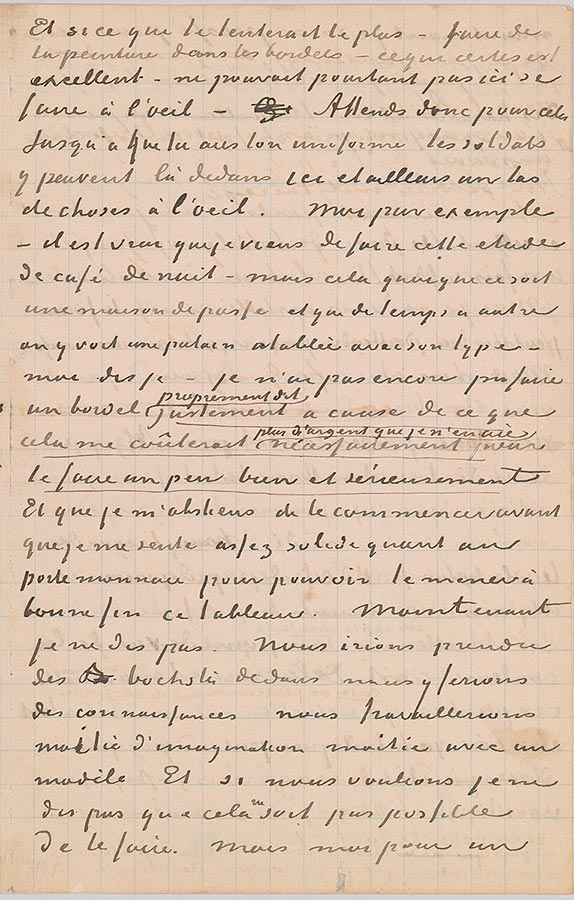
Vincent van Gogh, letter to Émile Bernard, Arles, 25 September 1888, Letter 16, page 3
Thaw Collection, given in honor of Charles E. Pierce, Jr., 2007
And what if the thing that would tempt you the most—painting in the brothels—which is
certainly excellent—could not after all be done here for free? Wait for that until you have your uniform,
then; here and elsewhere, soldiers can do a whole lot of things in it for free. I, for example—
it's true that I've just done that study of a night café—but that, although it's a house of assignation,
and from time to time you see a whore sitting there at a table with her fellow—I myself, I say,
I haven't yet been able to do a brothel as such, precisely because it would cost me more money than
I'm forced to have, to do it reasonably well and seriously. And that I refrain from beginning it before I
feel sufficiently sure, as far as the wallet goes, of being able to complete that painting properly. Now,
all right. We'd drink some glasses of beer in there, we'd meet people there; we'd work half from the
imagination, half with a model. And if we wanted to, I'm not saying that it might not be possible
to do it. But I for one,
© 2007 Van Gogh Museum, Amsterdam
Letter 16, page 4
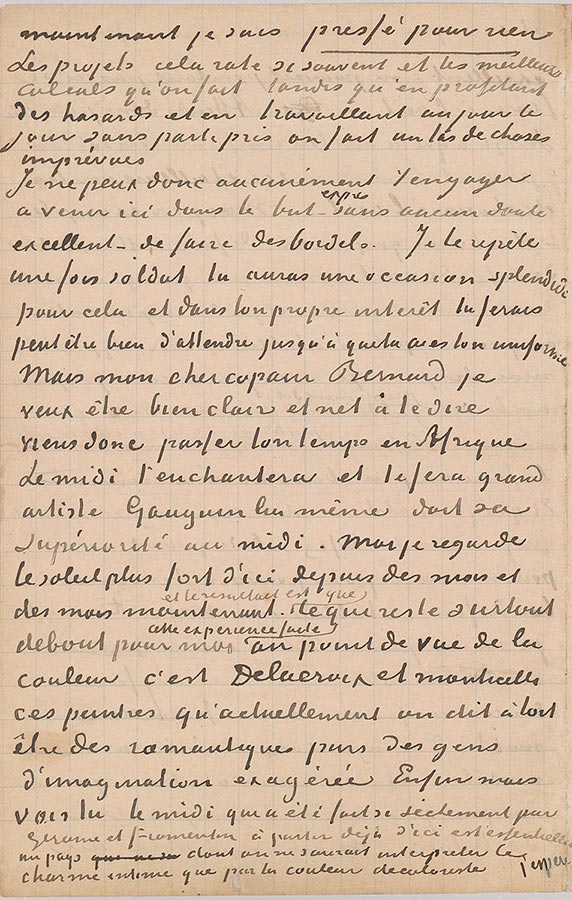
Vincent van Gogh, letter to Émile Bernard, Arles, 25 September 1888, Letter 16, page 4
Thaw Collection, given in honor of Charles E. Pierce, Jr., 2007
I'm not in any hurry for anything, now. Projects so often fall through, and
the best calculations you make; while by taking advantage of chance, and working from day to day
without bias, you do a whole lot of unforeseen things.
So in no way can I encourage you to come here with the express purpose—excellent, without
any doubt—of doing brothels. I repeat, once you're a soldier, you'll have a splendid opportunity for
that, and in your own interest you would perhaps do well to wait until you have your uniform.
But, my dear old Bernard, I want to be very clear and plain in saying to you, do come and
spend your time in Africa. The south will delight you and make you a great artist; Gauguin himself
owes his superiority to the south. I've been looking at the stronger sun down here for months
and months now. And the result is that, from the point of view of color, what remains more than
anything for me, having gained the experience, is Delacroix and Monticelli, those painters who
nowadays are wrongly said to be pure romantics, people of exaggerated imagination. But anyway,
do you see, the south, that was done so drily by Gérôme and Fromentin, is from this place on
essentially a region whose intimate charm could only be interpreted by a colorist's color. I hope
that you'll write to me again soon. I daren't take it upon myself to encourage just anyone to come
here; if somebody comes of his own accord, well, that's his business, but as far as advising the
thing, I'll never do it. For myself, I'm staying here, and naturally it would please me greatly if you
were to spend the winter here. Handshake.
Ever yours,
Vincent
© 2007 Van Gogh Museum, Amsterdam
Letter 17, page 1
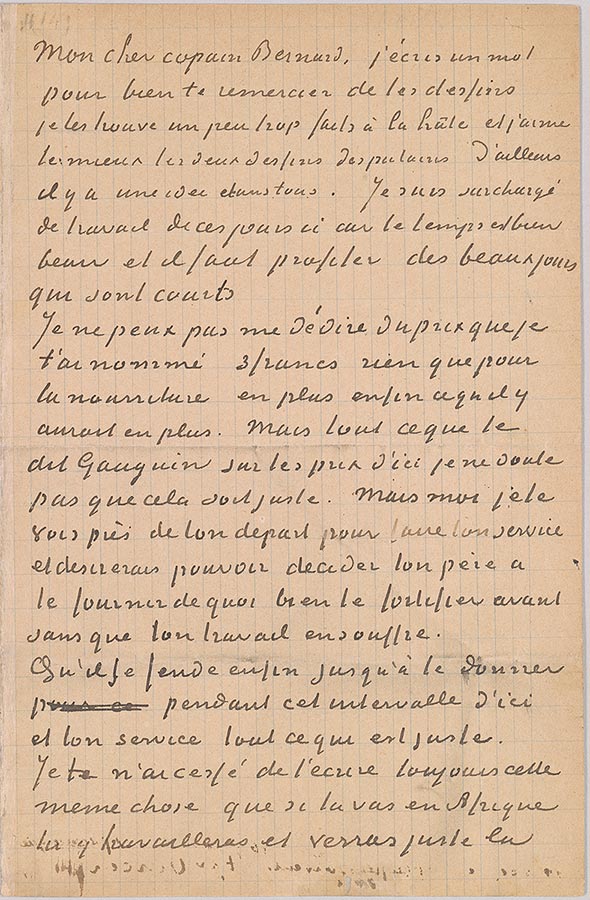
Vincent van Gogh, letter to Émile Bernard, Arles, 1 October 1888, Letter 17, page 1
Thaw Collection, given in honor of Charles E. Pierce, Jr., 2007
My dear old Bernard,
I'm writing a line to thank you kindly for your drawings; I find them done in a bit too much of a
rush, and I like the two drawings of whores the most; but there's an idea in all of them. I've been
overloaded with work these past few days, because the weather's really beautiful and you have to
make the most of the fine days, which are short.
I can't alter the price that I quoted to you, 3 francs for food alone, and in addition, well, whatever
there would be on top of that. But I have no doubt that everything Gauguin tells you about
the prices down here is correct. But I see you near your departure to do your service, and would
like to be able to persuade your father to supply you with enough to strengthen you thoroughly
first, without your work suffering as a result.
Let him stump up at last, to the point of giving you whatever's fair during the interval between
now and your service.
I have not ceased writing this same thing to you all the time, that if you go to Africa you'll
work there and you'll see just the kind of
© 2007 Van Gogh Museum, Amsterdam
Letter 17, page 2
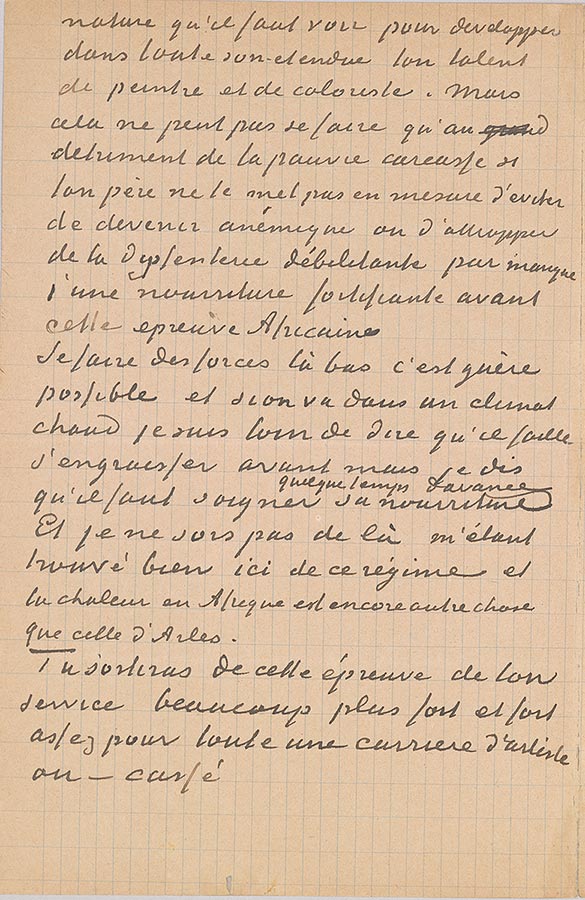
Vincent van Gogh, letter to Émile Bernard, Arles, 1 October 1888, Letter 17, page 2
Thaw Collection, given in honor of Charles E. Pierce, Jr., 2007
nature you have to see in order to develop your talent as
a painter and colorist to its full extent. But that can be done only to the detriment of your poor
carcass, if your father does not make it possible for you to avoid becoming anemic or to catch
debilitating dysentery through lack of strengthening food before this African ordeal.
It's scarcely possible to make yourself strong over there, and if you go to a hot climate, I'm far
from saying you have to fatten yourself up beforehand, but I do say you have to pay attention to
your food for some time in advance. And I'm sticking to that, having found myself doing well here
on that regime, and the heat of Africa is something different again from that of Arles.
You'll emerge from this ordeal of your service much stronger, and strong enough for a whole
career as an artist or—broken.
© 2007 Van Gogh Museum, Amsterdam
Letter 17, page 3
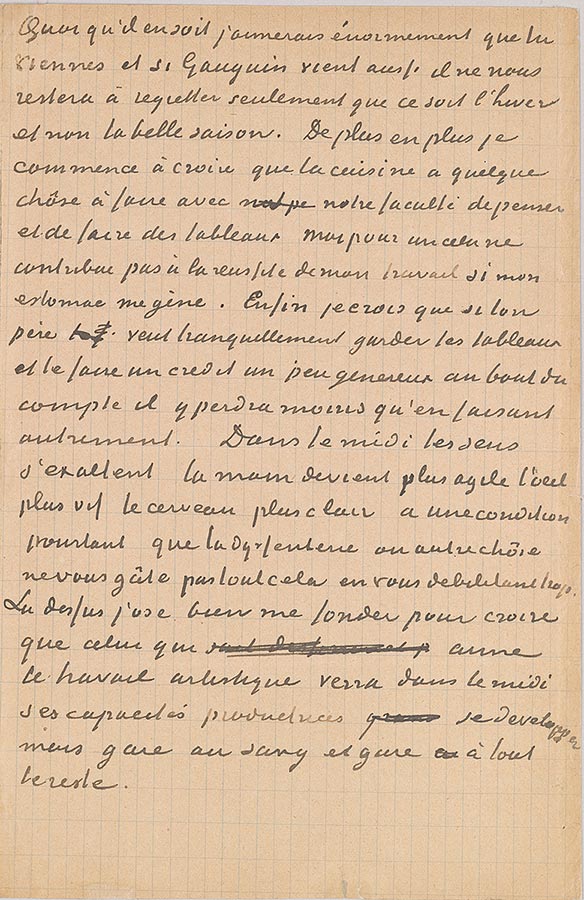
Vincent van Gogh, letter to Émile Bernard, Arles, 1 October 1888, Letter 17, page 3
Thaw Collection, given in honor of Charles E. Pierce, Jr., 2007
(Continued from page 2)
In any event, I would like you to come enormously, and if Gauguin comes too, all that will be
left for us to regret will be that it's winter and not the warm season. I'm beginning to believe more
and more that food has something to do with our power to think and to make paintings; as for me,
it doesn't contribute to the success of my work if my stomach's bothering me. Anyway, I believe
that if your father wanted quietly to keep your paintings and to fund you fairly generously, on balance
he'll lose less than by doing otherwise. In the south, the senses are elated, the hand becomes
nimbler, the eye livelier, the brain clearer, on one condition, though: that dysentery or something
else does not spoil all that by debilitating you too much. On that point, I really dare to take my
stand in believing that he who loves artistic work will see his productive capacities develop in the
south, but watch your blood, and watch everything else.
© 2007 Van Gogh Museum, Amsterdam
Letter 17, page 4
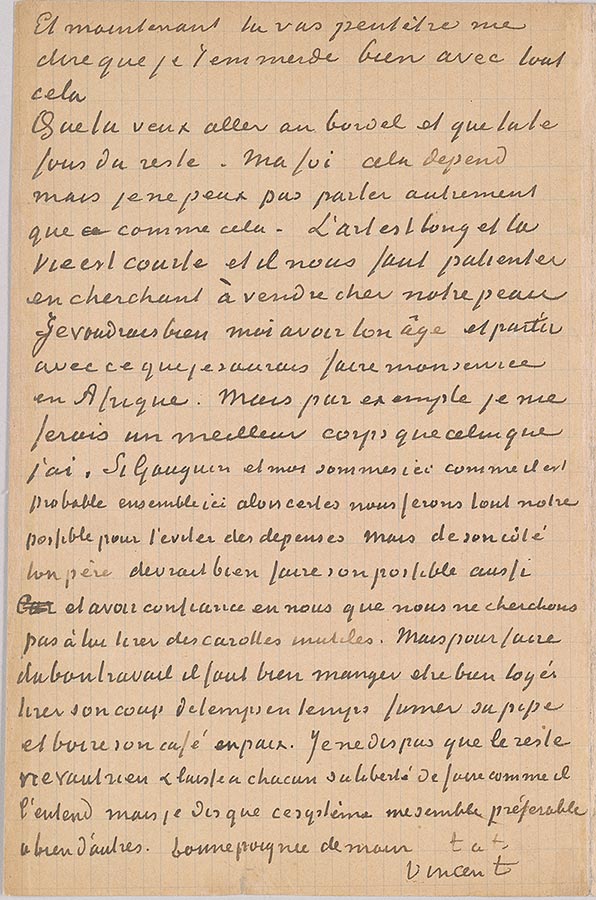
Vincent van Gogh, letter to Émile Bernard, Arles, 1 October 1888, Letter 17, page 4
Thaw Collection, given in honor of Charles E. Pierce, Jr., 2007
And now you'll perhaps tell me that I'm bloody well getting on your nerves with all that.
That you want to go to the brothel, and that you don't give a damn about all the rest. My word,
that depends, but I can't say other than that. Art is long and life is short, and we must wait patiently
while trying to sell our skin dearly. Me, I'd really like to be your age and go off with whatever
knowledge I had to do my service in Africa. But, for example, I'd surely get myself a better body
than the one I have. If Gauguin and I are here, as is probable, together—then here for certain we'll
do our level best to spare you expenses. But on his side, your father should certainly do his best
too, and have confidence in us that we're not trying to extract money from him pointlessly. But in
order to do good work you have to eat well, be well housed, have a screw from time to time, smoke
your pipe and drink your coffee in peace. I'm not saying that the rest counts for nothing, and leave
everyone free to do as he sees fit, but I do say that this system seems preferable to many others to
me. Good handshake.
Ever yours,
Vincent
© 2007 Van Gogh Museum, Amsterdam
Letter 18, page 1
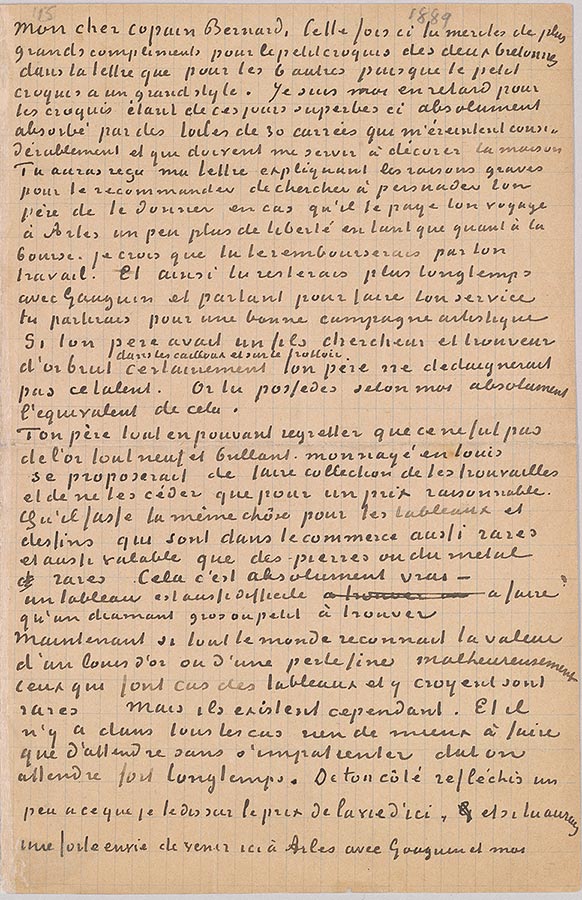
Vincent van Gogh, letter to Émile Bernard, Arles, 3 October 1888, Letter 18, page 1
Thaw Collection, given in honor of Charles E. Pierce, Jr., 2007
My dear old Bernard,
This time you deserve bigger compliments for the little sketch of the two Breton women in your
letter than for the other six, since the little sketch has a great style. I'm behind myself as far as
sketches go, being so totally absorbed these recent superb days with square no. 30 canvases, which
wear me out considerably and I intend to use to decorate the house.
You will have received my letter explaining the serious reasons for advising you to try to
persuade your father to give you a little more freedom as far as your purse is concerned, should
he pay your fare to Arles. I believe that you would repay him through your work. And that way you
would stay longer with Gauguin, and leaving to do your service, you would leave for a good artistic
campaign. If your father had a son who was a prospector and discoverer of raw gold among the
pebbles and on the pavement, your father would certainly not look down on that talent. Now in
my opinion, you have absolutely the equivalent of that.
Your father, while he might regret that it wasn't shiny new gold, minted in louis, would set
out to make a collection of your finds, and to sell them only for a reasonable price. Let him do the
same thing for your paintings and drawings, which are as rare and as valuable on the market as rare
stones or rare metal. That's absolutely true—a painting is as difficult to make as a large or small
diamond is to find.
Now while everyone acknowledges the value of a gold louis or a real pearl, unfortunately those
who set store by paintings and believe in them are few and far between. But they do exist. And in
any case, there's nothing better to do than to wait without getting impatient, even if one has to wait
for a long time. On your side, think a little about what I'm telling you about the cost of living here,
and should you have a strong wish to come to Arles with Gauguin and me,
© 2007 Van Gogh Museum, Amsterdam
Letter 18, page 2
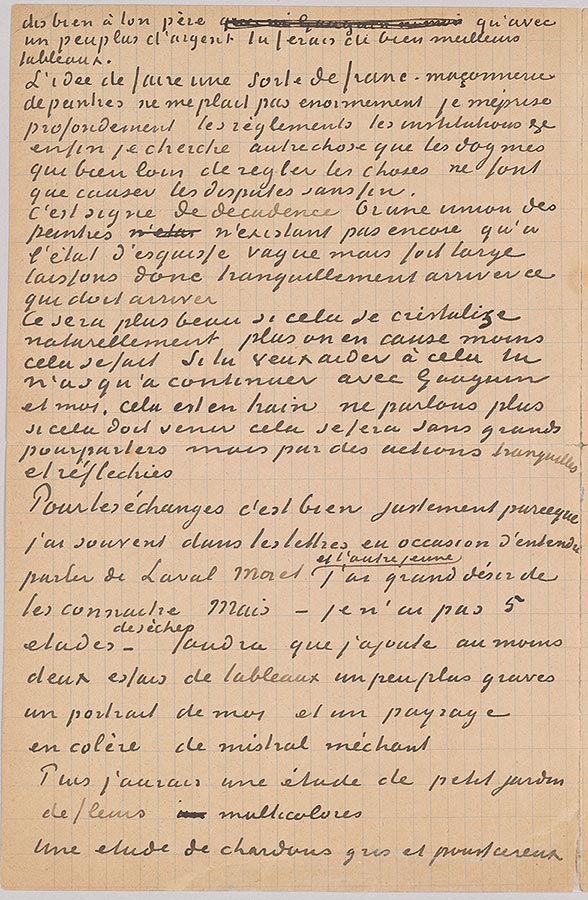
Vincent van Gogh, letter to Émile Bernard, Arles, 3 October 1888, Letter 18, page 2
Thaw Collection, given in honor of Charles E. Pierce, Jr., 2007
(Continued from page 1)
be sure to tell your
father that with a little more money you would make much better paintings.
The idea of making a kind of freemasonry of painters does not please me hugely; I deeply
despise rules, institutions, etc. In short, I'm looking for something other than dogmas, which, very
far from settling things, only cause endless disputes.
It's a sign of decadence. Now, as a union of painters exists so far only in the form of a vague
but very broad sketch, then let's calmly allow what must happen to happen.
It will be better if it crystallizes naturally; the more one talks about it, the less it comes about.
If you wish to support it, you have only to continue with Gauguin and me. It's in progress, let's not
talk any more; if it must come it will come about without big negotiations but through calm and
well-thought-out actions.
As regards the exchanges, it's precisely because I have often had occasion to hear mention in
your letters of Laval, Moret and the other young man, that I have a great desire to get to know
them. But—I don't have five dry studies—will have to add at least two slightly more serious
attempts at paintings, a portrait of myself and a landscape angry with a nasty mistral.
Then I would have a study of a little garden of multicolored flowers.
A study of gray and dusty thistles,
© 2007 Van Gogh Museum, Amsterdam
Letter 18, page 3
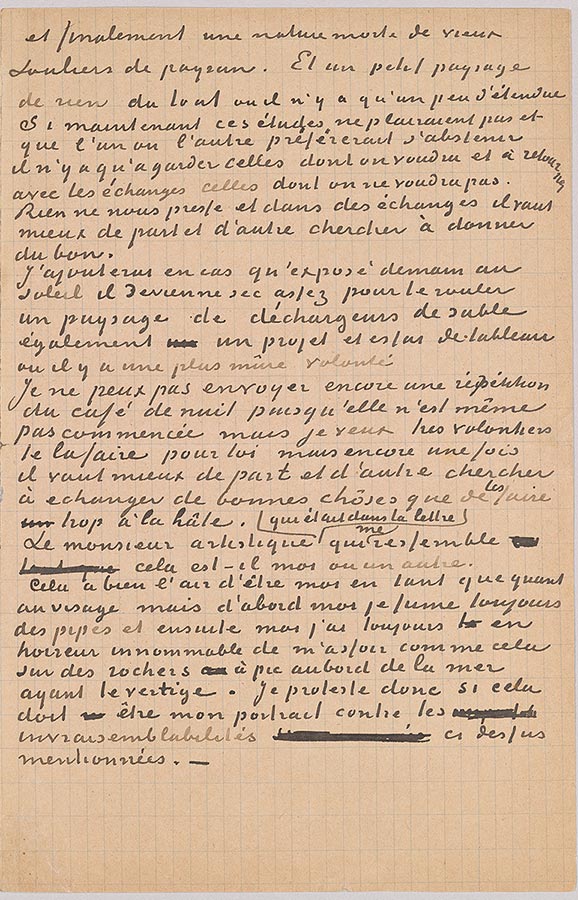
Vincent van Gogh, letter to Émile Bernard, Arles, 3 October 1888, Letter 18, page 3
Thaw Collection, given in honor of Charles E. Pierce, Jr., 2007
and lastly a still life of old peasants' shoes. And a small
landscape of nothing at all, in which there's nothing but a bit of an expanse. Now, if these studies
aren't found pleasing, and if one or other preferred not to take part, all you have to do is keep those
that are wanted and return with the exchanges those that aren't wanted. We're in no hurry, and in
exchanges it's better on both sides to try to give something good.
If it's dry enough to be rolled up after being exposed to the sun tomorrow, I'll add a landscape
of men unloading sand, another project and attempt at a painting, in which there is a more fully
developed sense of purpose.
I cannot send a repetition of the night café yet because it hasn't even been started, but I'm very
willing to do it for you, but once again, it's better on both sides to try to exchange good things
than to do them too hastily.
The artistic gentleman who was in your letter, who resembles me—is that me or somebody else?
He certainly looks like me as far as the face is concerned, but in the first place I'm always smoking
a pipe, and then, having vertigo, I have an unspeakable horror of sitting like that on sheer crags
beside the sea. So if that's meant to be my portrait, I protest against the above-mentioned improbabilities.
© 2007 Van Gogh Museum, Amsterdam
Letter 18, page 4
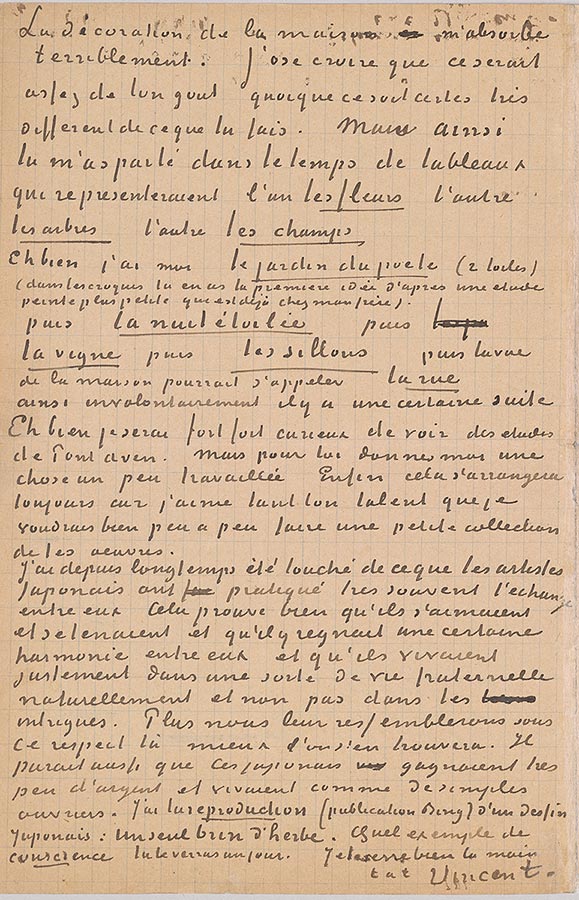
Vincent van Gogh, letter to Émile Bernard, Arles, 3 October 1888, Letter 18, page 4
Thaw Collection, given in honor of Charles E. Pierce, Jr., 2007
The decoration of the house absorbs me terribly. I dare to believe that it would be quite
to your liking, although it's very different from what you do, of course. But just as you spoke to me
in the past about paintings that would depict, one flowers, the other trees, the other fields.
Well, I have the Poet's Garden (2 canvases); (among the sketches you have the first idea for it,
after a smaller painted study that's already at my brother's).
Then The Starry Night, then The Vineyard, then The Furrows, then the view of the house
could be called The Street, so unintentionally there's a certain sequence.
Well, I'll be very very curious to see studies of Pont-Aven. But for yourself, give me something
fairly worked up. It will work out, anyway, because I like your talent so much that I'd be very
pleased to make a small collection of your works, bit by bit.
For a long time I have been touched by the fact that Japanese artists very often made exchanges
among themselves. It clearly proves that they liked one another and stuck together, and that there
was a certain harmony among them and that they did indeed live in a kind of brotherly life, in a
natural way and not in the midst of intrigues. The more we resemble them in that respect, the better
it will be for us. It seems also that those Japanese earned very little money and lived like simple
laborers. I have the reproduction (Bing publication) of a Japanese drawing: a single blade of
grass. What an example of awareness—you'll see it one day. I shake your hand firmly.
Ever yours,
Vincent
© 2007 Van Gogh Museum, Amsterdam
Letter 19, page 1
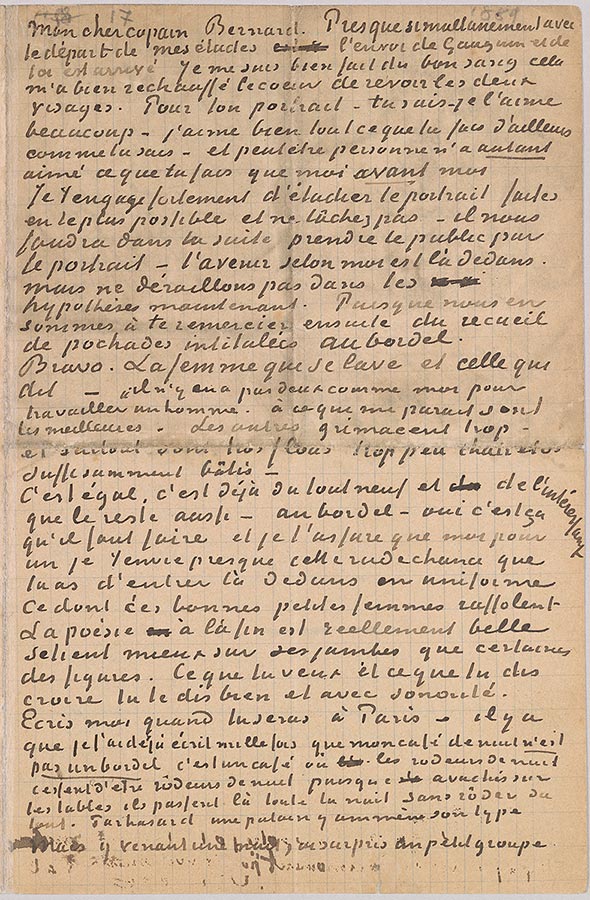
Vincent van Gogh, letter to Émile Bernard, Arles, 5 October 1888, Letter 19, page 1
Thaw Collection, given in honor of Charles E. Pierce, Jr., 2007
My dear old Bernard.
The consignment Gauguin and you sent arrived at almost the same time as my studies went off.
I was delighted, it really warmed my heart to see the two faces again. As for your portrait—you
know—I like it very much—I actually like everything that you do, as you know—and perhaps
nobody before me has liked what you do as much as I do.
I really urge you to study the portrait; make as many as possible and don't give up—later we'll
have to attract the public through portraits—in my view that's where the future lies. But let's not
get sidetracked into hypotheses now. Because it's up to us next to thank you for the collection of
rough sketches entitled At the brothel.
Bravo! The woman washing herself and the one who says "I'm second to none when it comes
to taking it out of a man" are the best, it seems to me. The others are grimacing too much—and
most of all, are too vague, too little flesh and bone properly built up.
It doesn't matter; it's already something altogether new and interesting, and the rest, too—at
the brothel—yes, that's what needs to be done, and I assure you that I for one almost envy you
this bloody good opportunity you have to go in there in uniform. Which those good little women
adore. The poem at the end is really beautiful; stands up better than some of the figures. What you
want, and what you say you believe, you say well and resonantly.
Write to me when you're going to be in Paris—the thing is that I've already written you a
thousand times that my night café is not a brothel, it's a café where night prowlers cease to be night prowlers,
since, slumped over tables, they spend the whole night there without prowling at all.
Occasionally a whore brings her fellow there. But arriving there one night I came across a little
group
© 2007 Van Gogh Museum, Amsterdam
Letter 19, page 2
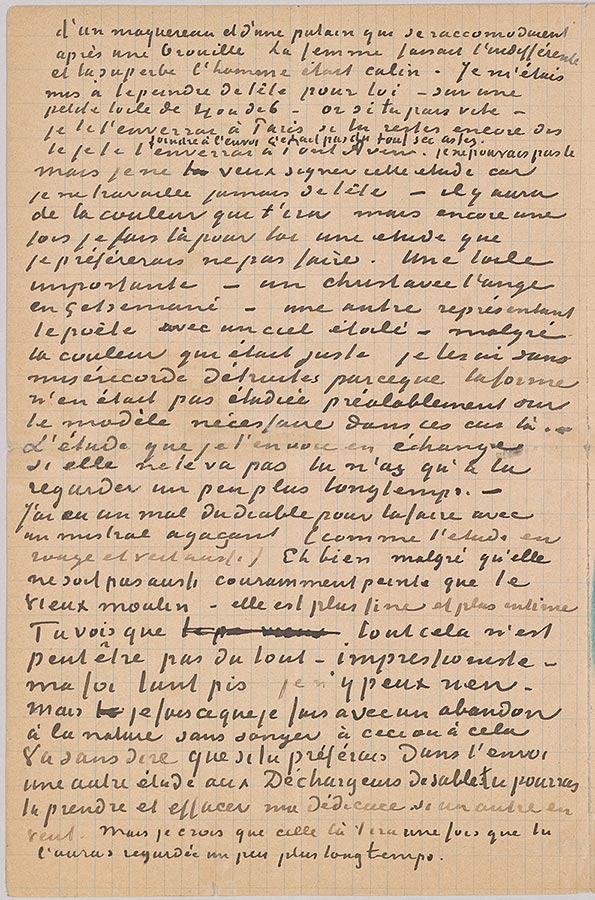
Vincent van Gogh, letter to Émile Bernard, Arles, 5 October 1888, Letter 19, page 2
Thaw Collection, given in honor of Charles E. Pierce, Jr., 2007
of a pimp and a whore who were making up after a quarrel. The woman was pretending to
be indifferent and haughty, the man was tender. I started to paint it for you from memory—on a
little no. 4 or no. 6 canvas—now if you're leaving soon—I'll send it to you in Paris; if you're staying
longer, say so, I'll send it to you in Pont-Aven. I couldn't add it to the consignment, it was nowhere
near dry enough.
But I don't want to sign this study, because I never work from memory—there will be color in
it, which will suit you, but to repeat, here I'm doing a study for you that I would prefer not to do.
I mercilessly destroyed an important canvas—a Christ with the angel in Gethsemane—as well as
another one depicting the poet with a starry sky—because the form hadn't been studied from the
model beforehand, necessary in such cases—despite the fact that the color was right.
If the study I'm sending you in exchange doesn't suit you, just look at it a little longer.
I had the devil's own job to do it with an irritating mistral (like the study in red and green, as
well). Well, despite the fact that it wasn't painted as fluently as the old mill—it's more delicate
and more intimate. You see that all of this is perhaps not at all—impressionist—well, too bad, I
can't do anything about it—but I do what I do with an abandonment to reality, without thinking
about this or that. Goes without saying that if you preferred another study from the batch to the
men unloading sand, you could take it and remove my dedication if someone else wants it. But I
believe that that one will suit you once you've looked at it a little longer.
© 2007 Van Gogh Museum, Amsterdam
Letter 19, page 3
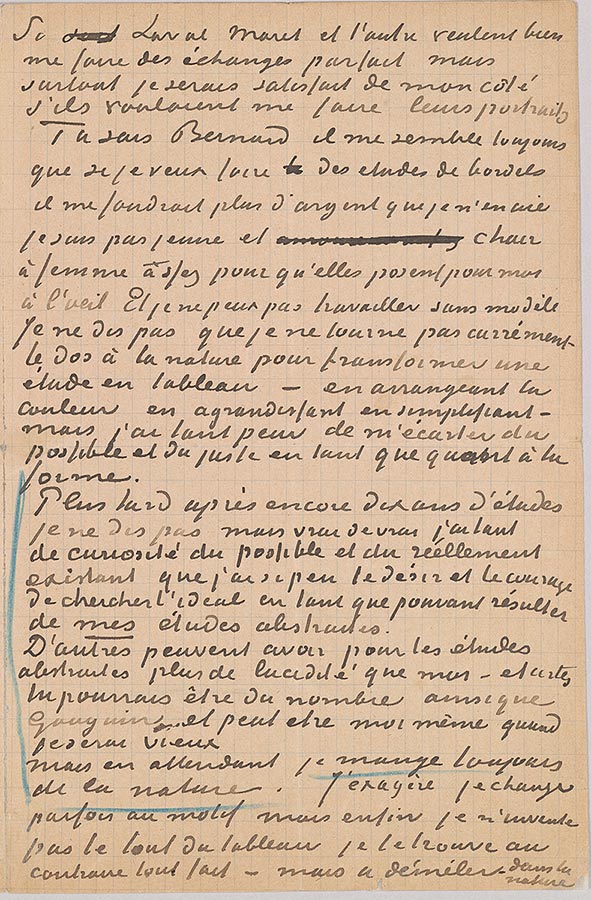
Vincent van Gogh, letter to Émile Bernard, Arles, 5 October 1888, Letter 19, page 3
Thaw Collection, given in honor of Charles E. Pierce, Jr., 2007
If Laval, Moret and the other one agree to make exchanges with me, perfect, but on my side I
would be especially satisfied if they wanted to do their portraits for me.
You know, Bernard, it always seems to me that if I want to do studies of brothels, I'd need more
money than I have; I'm not young or womanizer enough for them to pose for me for free. And
I can't work without a model. I'm not saying that I don't flatly turn my back on reality to turn a
study into a painting—by arranging the color, by enlarging, by simplifying—but I have such a fear
of separating myself from what's possible and what's right as far as form is concerned.
Later, after another ten years of studies, I'm not saying so, but in very truth I have so much
curiosity for what's possible and what really exists that I have so little desire or courage to search
for the ideal, in so far as it could result from my abstract studies.
Others may have more clarity of mind than I for abstract studies—and you might certainly be
among them, as well as Gauguin and perhaps myself when I'm old.
But in the meantime I'm still living off the real world. I exaggerate, I sometimes make changes
to the subject, but still I don't invent the whole of the painting; on the contrary, I find it readymade—
but to be untangled—in the real world.
© 2007 Van Gogh Museum, Amsterdam
Letter 19, page 4
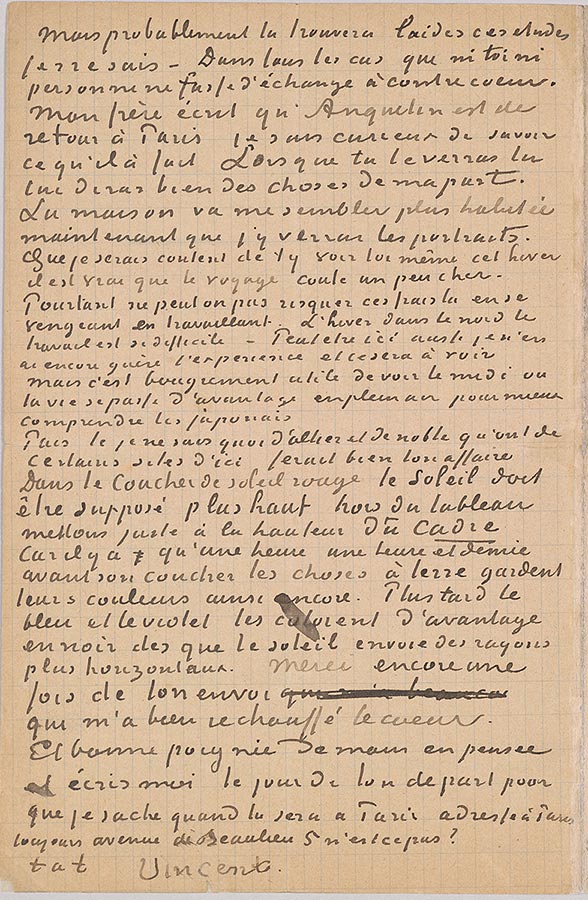
Vincent van Gogh, letter to Émile Bernard, Arles, 5 October 1888, Letter 19, page 4
Thaw Collection, given in honor of Charles E. Pierce, Jr., 2007
But you'll probably find these studies ugly, I don't know. In any case, neither you nor anyone
else should do an exchange grudgingly.
My brother writes that Anquetin's back in Paris; I'm curious to know what he's made. When
you see him you'll give him my kind regards.
The house will seem more lived in now that I'll see the portraits in it.
How happy I would be to see you there yourself this winter; it's true that the trip costs rather
a lot. Nevertheless, may one not risk those expenses by taking one's revenge by working? Work's so
difficult in the north in winter. Here too, perhaps; I've hardly had the experience yet and it remains
to be seen.
But it's damned useful to see the south, where life is lived more in the open air, in order to
understand the Japanese better.
And that touch of the haughty and the noble that certain places have down here will suit your
book very well. In The Red Sunset, the sun should be imagined higher, outside the painting, let's
say just at the level of the FRAME. Because it so happens that an hour, an hour and a half before it
sets, the things on the earth still keep their colors like that. Later the blue and the violet color them
darker, as soon as the sun sends out rays that are more horizontal. Thanks once again for what you
sent me, it really warmed my heart.
And a good handshake in thought, and write to me the day of your departure so that I know
when you'll be in Paris; address in Paris still avenue de Beaulieu 5, isn't it?
Ever yours,
Vincent
© 2007 Van Gogh Museum, Amsterdam
Letter 21, page 1
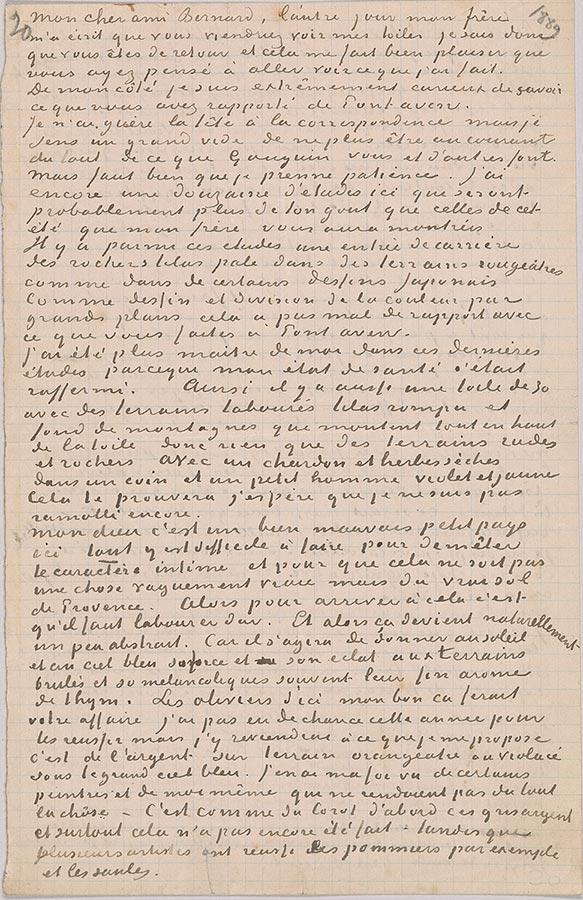
Vincent van Gogh, letter to Émile Bernard, Arles, 8 October 1888, Letter 21, page 1
Thaw Collection, given in honor of Charles E. Pierce, Jr., 2007
My dear friend Bernard,
The other day my brother wrote to me that you were going to come to see my canvases; so I know
that you're back, and I'm very pleased that you thought of going to see what I've done.
For my part, I'm extremely curious to know what you have brought back from Pont-Aven.
I hardly have a head for writing, but I feel a great emptiness in no longer being at all up to date
with what Gauguin, you and others are doing. But I really must have patience. I have another dozen
studies here, which will probably be more to your taste than the ones from this summer that my
brother will have shown you.
Among these studies there is an entrance to a quarry, pale lilac rocks in reddish earth, as in
certain Japanese drawings. In terms of design and the division of color into large planes, it's quite
closely related to what you're doing in Pont-Aven.
I had more control over myself in these latest studies, because my state of health had firmed
up. So there's also a no. 30 canvas with broken lilac plowed fields and a background of mountains
that go all the way up the canvas; so nothing but rough ground and rocks, with a thistle and dry
grass in a corner, and a little violet and yellow man. That will prove, I hope, that I haven't yet
gone soft.
Dear God, this is a pretty awful little part of the world, everything's hard to do here, to disentangle
its intimate character, and so that it's not something vaguely true, but the true soil of
Provence. So to achieve that, you have to toil hard. And so it naturally becomes a little abstract.
Because it will be a question of giving strength and brilliance to the sun and the blue sky, and to the
scorched and often so melancholy fields their delicate scent of thyme. The olive trees down here,
my good fellow, they'd suit your book; I haven't been fortunate this year in making a success of
them, but I'll go back to it, that's my intention. It's silver against orangish or purplish earth, under
the great blue sky. Well now, I've seen some by certain painters, and by myself, which didn't render
the thing at all. Those silver grays are like Corot first of all, and that, above all, hasn't been done
yet—while several artists have been successful with apple-trees, for example, and willows.
© 2007 Van Gogh Museum, Amsterdam
Letter 21, page 2
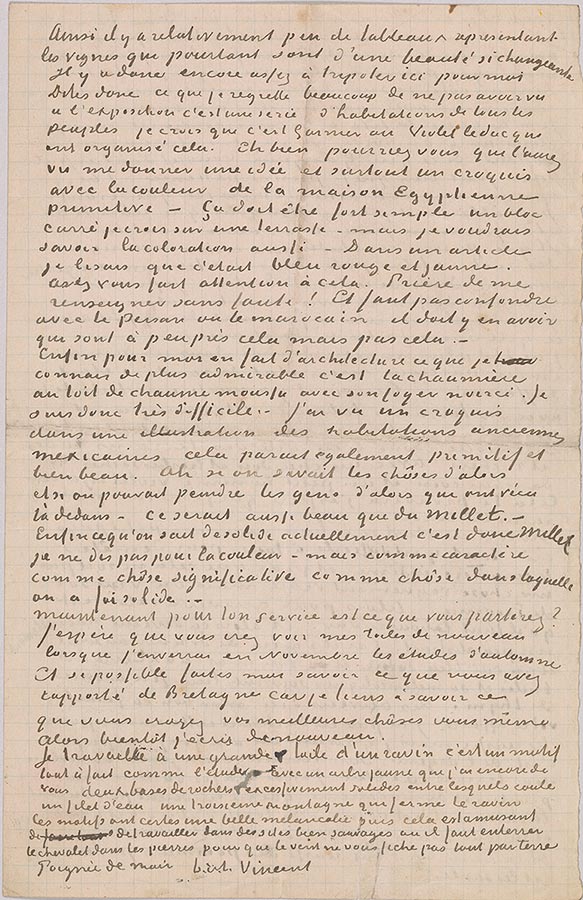
Vincent van Gogh, letter to Émile Bernard, Arles, 8 October 1888, Letter 21, page 2
Thaw Collection, given in honor of Charles E. Pierce, Jr., 2007
So there are relatively few paintings of vineyards, which are nevertheless of such changing
beauty. So there's still plenty for me to fiddle around with here.
Look here, what I very much regret not having seen at the Exhibition is a series of houses of all
the nations; I think it was Garnier or Viollet-le-Duc who organized it. Well, could you, who will
have seen it, give me an idea, and especially a sketch with the color of the primitive Egyptian house?
It must be very simple, a square block, I believe, on a terrace—but I should like to know the coloring
too. I was reading in an article that it was blue, red and yellow.
Did you pay attention to it? Please inform me without fail! And it must not be confused with
the Persian or the Moroccan; there must be some that are more or less it, but not it.
Anyway, for me the most wonderful thing that I know in terms of architecture is the cottage
with a mossy thatched roof, with its blackened hearth. So I'm very fussy. I saw a sketch of ancient
Mexican houses in an illustrated magazine; that, too, seemed primitive and really beautiful. Ah, if
only one knew the things of those days, and if one could paint the people of those days who lived
in them—it would be as beautiful as Millet. Anyway, what we do know that's solid these days, then,
is Millet; I'm not talking about color—but as character, as something significant, as something in
which one has solid faith.
Now, about your service; will you go? I hope you'll go to see my canvases again when I send the
studies of autumn, in November. And if possible let me know what you've brought back from Brittany,
because I'd really like to know what you yourself believe to be your best things. So I'll write
again soon.
I'm working on a large canvas of a ravine; it's a subject just like the study with a yellow tree
that I still have from you, two bases of extremely solid rocks, between which a trickle of water
flows, a third mountain that closes off the ravine. These motifs certainly have a beautiful melancholy,
and it's enjoyable to work in really wild sites where you have to bury your easel in the stones
so that the wind doesn't send everything flying to the ground.
Handshake.
Yours,
Vincent
© 2007 Van Gogh Museum, Amsterdam
Letter 22, page 1
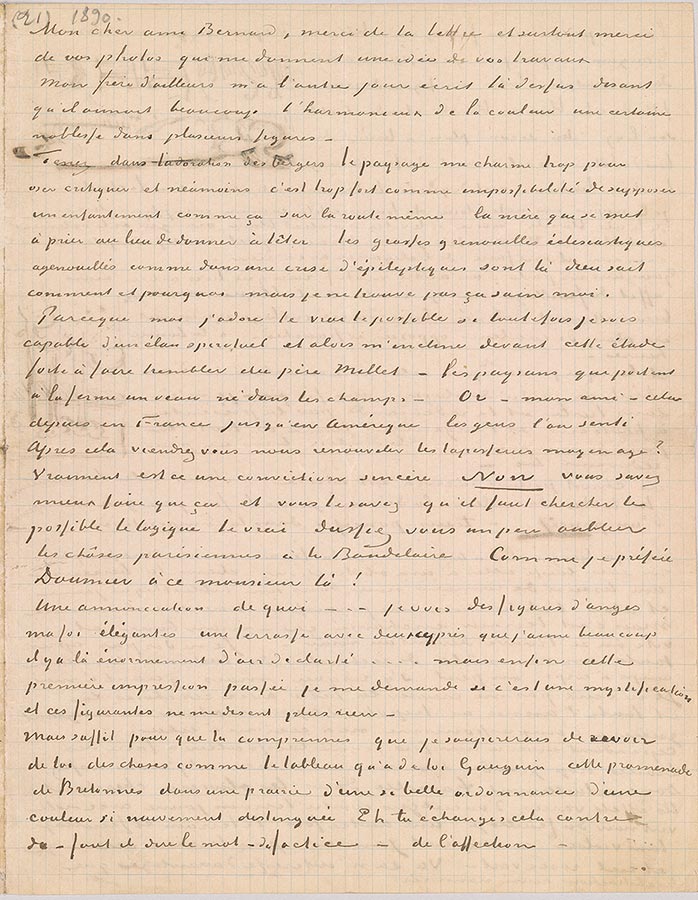
Vincent van Gogh, letter to Émile Bernard, Saint-Rémy, 20 November 1889, Letter 22, page 1
Thaw Collection, given in honor of Charles E. Pierce, Jr., 2007
My dear friend Bernard,
Thank you for your letter, and thank you especially for your photos, which give me an idea of your
work.
Incidentally, my brother wrote to me about it the other day, saying that he very much liked the
harmoniousness of the color, a certain nobility in several figures.
Look, in the adoration of the shepherds, the landscape charms me too much for me to dare to
criticize, and nevertheless, it's too great an impossibility to imagine a birth like that, on the very
road, the mother who starts praying instead of giving suck, the fat ecclesiastical bigwigs, kneeling as
if in an epileptic fit, God knows how or why they're there, but I myself don't find it healthy.
Because I adore the true, the possible, were I ever capable of spiritual fervor; so I bow before
that study, so powerful that it makes you tremble, by père Millet—peasants carrying to the farmhouse
a calf born in the fields. Now, my friend—people have felt that from France to America. After
that, would you go back to renewing medieval tapestries for us? Truly, is this a sincere conviction?
No, you can do better than that, and you know that one has to look for the possible, the logical, the
true, even if to some extent you had to forget Parisian things à la Baudelaire. How I prefer Daumier
to that gentleman!
An annunciation of what—I see figures of angels, elegant, my word, a terrace with two
cypresses, which I like very much; there's an enormous amount of air, of clarity in it. . . . but in the
end, once this first impression is past, I wonder if it's a mystification, and these secondary characters no longer tell me anything.
But this is enough for you to understand that I was longing to get to know things from you like
the painting of yours that Gauguin has, those Breton women walking in a meadow, the arrangement
of which is so beautiful, the color so naively distinguished. Ah, you're exchanging that for
something—must one say the word—something artificial—something affected.
© 2007 Van Gogh Museum, Amsterdam
Letter 22, page 2
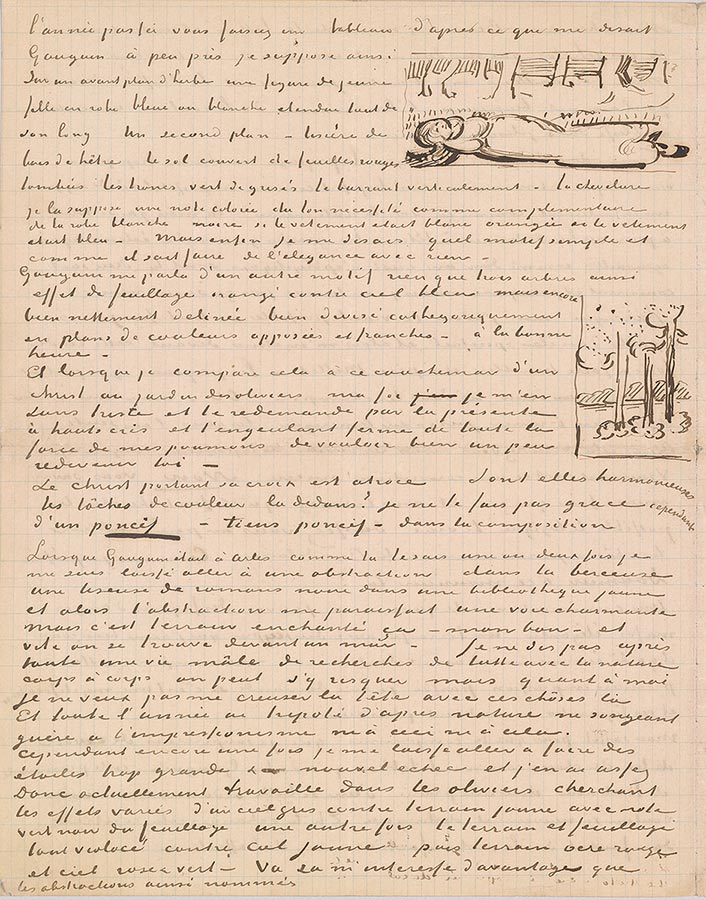
Vincent van Gogh, letter to Émile Bernard, Saint-Rémy, 20 November 1889, Letter 22, page 2
Reclining girl; Three trees
Thaw Collection, given in honor of Charles E. Pierce, Jr., 2007
Last year, from what Gauguin was telling me, you were doing a painting more or less like this,
I imagine. Against a foreground of grass, a figure of a young girl in a blue or white dress,
lying full length. Behind that: edge of a beech wood, the ground covered in fallen red leaves, the
verdigrised trunks crossing it vertically—I imagine the hair a colorful note in the tone required as
complementary to the white dress: black if the clothing was white, orange if the clothing was blue.
But anyway, I said to myself, what a simple subject, and how he knows how to create elegance with
nothing.
Gauguin spoke to me of another subject, nothing but three trees, thus the effect of orange
foliage against blue sky, but still really clearly delineated, well divided, categorically, into planes of
contrasting and pure colors—that's the spirit! And when I compare that with that nightmare
of a Christ in the Garden of Olives, well, it makes me feel sad, and I herewith ask you again,
crying out loud and giving you a good rocket with all the power of my lungs, to please become a
little more yourself again.
The Christ Carrying His Cross is atrocious. Are the splashes of color in it harmonious? But I
will not let you off the hook for a COMMONPLACE—commonplace, you hear—in the composition.
When Gauguin was in Arles, I once or twice allowed myself to be led into abstraction, as you know, in a woman rocking a cradle, a dark woman reading novels in a yellow library, and at
that time abstraction seemed an attractive route to me. But that's enchanted ground,—my good
fellow—and one soon finds oneself up against a wall. I'm not saying that one may not take the
risk after a whole manly life of searching, of fighting hand-to-hand with reality, but as far as I'm
concerned I do not want to rack my brains over that sort of thing. And the whole year, have fiddled
around from life, hardly thinking of impressionism or of this or that.
However, once again I'm allowing myself to do stars too big, etc., new setback, and I've enough
of that.
So at present am working in the olive trees, seeking the different effects of a gray sky against
yellow earth, with dark green note of the foliage; another time the earth and foliage all purplish
against yellow sky, then red ocher earth and pink and green sky. See, that interests me more than
the so-called abstractions.
© 2007 Van Gogh Museum, Amsterdam
Letter 22, page 3
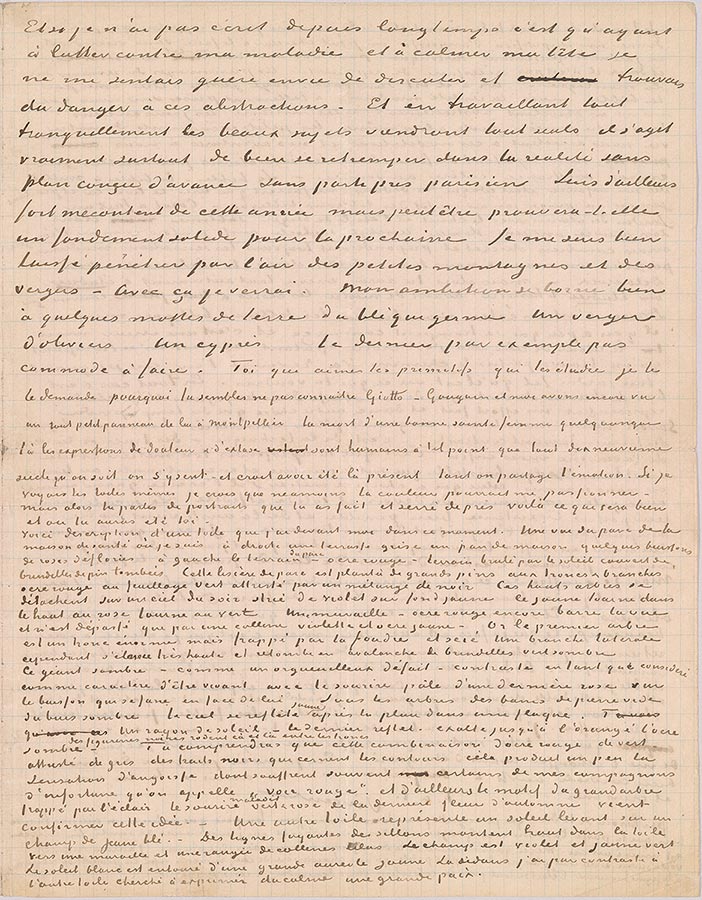
Vincent van Gogh, letter to Émile Bernard, Saint-Rémy, 20 November 1889, Letter 22, page 3
Thaw Collection, given in honor of Charles E. Pierce, Jr., 2007
And if I haven't written for a long time, it's because, having to struggle against my illness and
to calm my head, I hardly felt like having discussions, and found danger in these abstractions.
And by working very calmly, beautiful subjects will come of their own accord; it's truly first and
foremost a question of immersing oneself in reality again, with no plan made in advance, with no
Parisian bias. Besides, am very dissatisfied with this year, but perhaps it will prove a solid foundation
for the coming one. I have let myself become thoroughly imbued with the air of the small
mountains and the orchards. With that, I'll see. My ambition is truly limited to a few clods of earth,
some sprouting wheat. An olive grove. A cypress; the latter not easy to do, for example. You who
love the primitives, who study them, I ask you why you appear not to know Giotto. Gauguin and I
saw a tiny panel of his in Montpellier, the death of some sainted woman or other. The expressions
in it of pain and ecstasy are human to the point that, nineteenth century though it may be, you feel
you're in it—and believe you were there, present, so much do you share the emotion. If I saw your
actual canvases, I believe the color could nevertheless excite me. But then you speak of portraits
that you have done, and have captured precisely; that's something that will be good, and where you
will have been yourself.
Here's a description of a canvas that I have in front of me at the moment. A view of the garden
of the asylum where I am, on the right a gray terrace, a section of house, some rosebushes that have
lost their flowers; on the left, the earth of the garden—red ocher—earth burnt by the sun, covered
in fallen pine twigs. This edge of the garden is planted with large pines with red ocher trunks and
branches, with green foliage saddened by a mixture of black. These tall trees stand out against an
evening sky streaked with violet against a yellow background. High up, the yellow turns to pink,
turns to green. A wall—red ocher again—blocks the view, and there is nothing above it but a violet
and yellow ocher hill. Now, the first tree is an enormous trunk, but struck by lightning and sawn
off. A side branch thrusts up very high, however, and falls down again in an avalanche of dark
green twigs.
This dark giant—like a proud man brought low—contrasts, when seen as the character of a
living being, with the pale smile of the last rose on the bush, which is fading in front of him. Under
the trees, empty stone benches, dark box. The sky is reflected yellow in a puddle after the rain. A
ray of sun—the last glimmer—exalts the dark ocher to orange—small dark figures prowl here and
there between the trunks. You'll understand that this combination of red ocher, of green saddened
with gray, of black lines that define the outlines, this gives rise a little to the feeling of anxiety from
which some of my companions in misfortune often suffer, and which is called "seeing red." And
what's more, the motif of the great tree struck by lightning, the sickly green and pink smile of the
last flower of autumn, confirms this idea. Another canvas depicts a sun rising over a field of new
wheat. Receding lines of the furrows run high up on the canvas, toward a wall and a range of lilac
hills. The field is violet and green yellow. The white sun is surrounded by a large yellow aureole.
In it, in contrast to the other canvas, I have tried to express calm, a great peace.
© 2007 Van Gogh Museum, Amsterdam
Letter 22, page 4
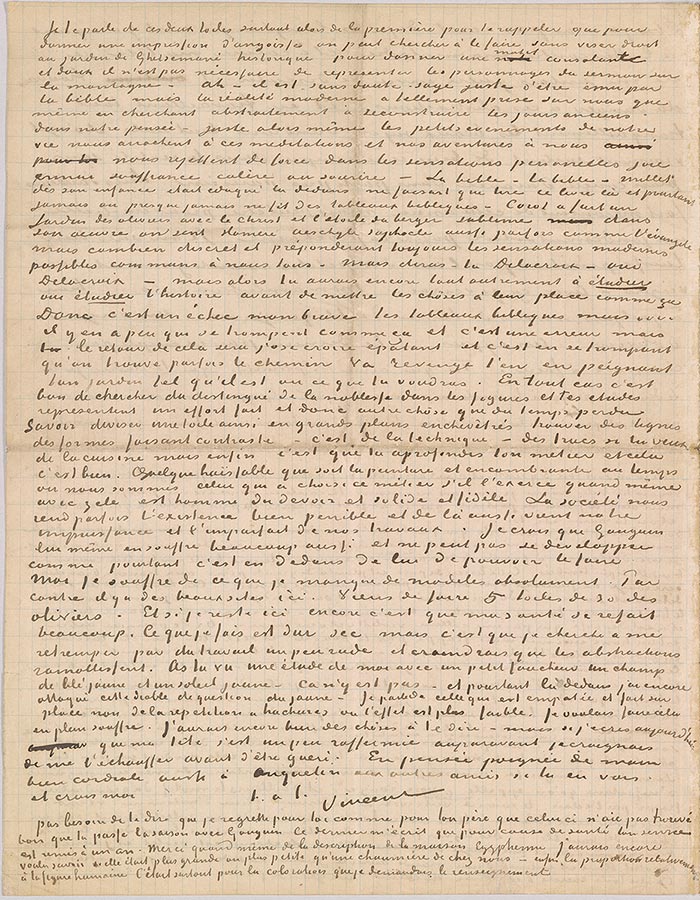
Vincent van Gogh, letter to Émile Bernard, Saint-Rémy, 20 November 1889, Letter 22, page 4
Thaw Collection, given in honor of Charles E. Pierce, Jr., 2007
I am speaking to you of these two canvases, and especially the first, to remind you that in order
to give an impression of anxiety, you can try to do it without heading straight for the historical
garden of Gethsemane; in order to offer a consoling and gentle subject it is not necessary to depict
the figures from the Sermon on the Mount—ah—it is—no doubt—wise, right, to be moved by
the Bible, but modern reality has such a hold over us that even when trying abstractly to reconstruct
ancient times in our thoughts—just at that very moment the petty events of our lives tear us
away from these meditations and our own adventures throw us forcibly into personal sensations:
joy, boredom, suffering, anger or smiling. The Bible—the Bible—Millet was brought up on it from
his childhood, used to read only that book and yet never, or almost never, did biblical paintings.
Corot did a Garden of Olives with Christ and the star of Bethlehem: sublime. In his work you
feel Homer, Aeschylus, Sophocles too, sometimes, as well as the gospels, but how sober and always
giving due weight to modern, possible sensations common to us all. But, you'll say, Delacroix—yes,
Delacroix—but then you'd have to study in a very different way, yes, study history before putting
things in their place like that.
So, they're a setback, my dear fellow, your biblical paintings, but. . . . there are few who make
mistakes like that, and it's an error, but your return from it will be, I dare to say, astonishing, and
it's by making mistakes that one sometimes finds the way. Look, avenge yourself by painting your
garden as it is, or anything you like. In any case, it's good to look for what's distinguished, what's
noble in figures, and your studies represent an effort that's been made, and so something other
than wasted time.
To know how to divide a canvas into large, tangled planes like that, to find contrasting lines
and forms—that's technique—trickery, if you like, but anyway, it means you're learning your craft
more thoroughly, and that's good. No matter how hateful and cumbersome painting may be in the
times in which we live, the person who has chosen this craft, if he nevertheless practices it with
zeal, is a man of duty, both sound and loyal. Society sometimes makes existence very hard for us,
and from that too comes our impotence and the imperfection of our works. I believe that Gauguin
himself suffers greatly from it, too, and cannot develop as he yet has it in him to do.
I myself suffer in that I'm utterly without models. On the other hand, there are beautiful sites
here. Have just done five no. 30 canvases of the olive trees. And if I still stay here it's because my
health is recovering greatly. What I'm making is harsh, dry, but it's because I'm trying to reinvigorate
myself by means of rather arduous work, and would fear that abstractions would make me
soft. Have you seen a study of mine with a little reaper? A field of yellow wheat and a yellow sun.
It isn't there yet—but in it I have again attacked this devil of a question of yellow. I'm talking about
the one that's impastoed and done on the spot, not about the repetition with hatching, in which
the effect is weaker. I wanted to do it in pure sulphur. I'd have plenty more things to tell you—but although I write today that my mind is somewhat stronger, previously I was afraid of overheating it
before I was cured. In thought a very warm handshake, to Anquetin too, to other friends if you see
them, and believe me,
Ever yours,
Vincent
No need to tell you that I regret, for you as well as for your father, that he did not approve of your
spending the season with Gauguin. The latter wrote to me that for reasons of health your service
has been postponed for a year. Thank you anyway for the description of the Egyptian house. I
would still have liked to know if it was larger or smaller than a cottage back home—the size relative
to the human figure, in short. I was looking for information about the coloring in particular.
© 2007 Van Gogh Museum, Amsterdam
Gauguin, page 1
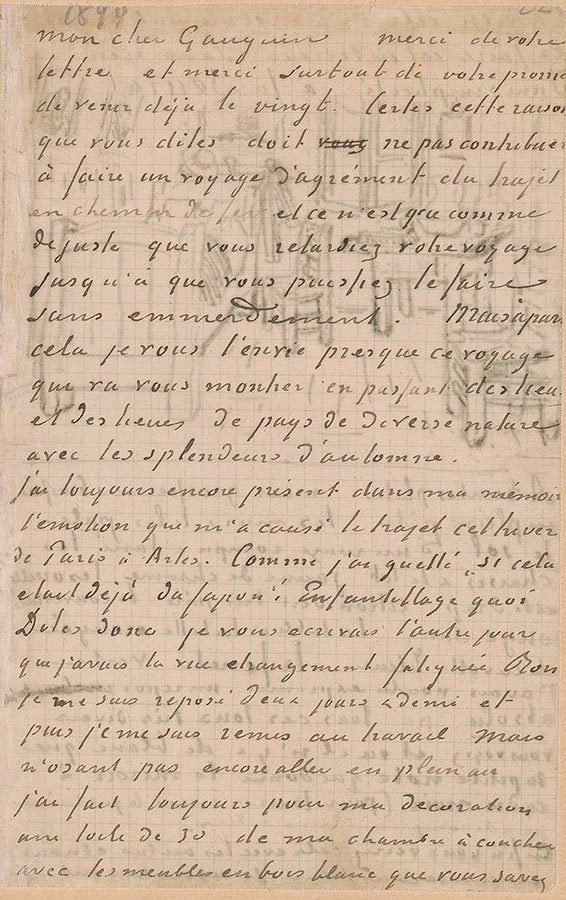
Vincent van Gogh, letter to Paul Gauguin, Arles, 17 October 1888, page 1
Thaw Collection, given in honor of Charles E. Pierce, Jr., 2007
My dear Gauguin,
Thanks for your letter, and thanks most of all for your promise to come as early as the twentieth. Agreed, this reason that you give won't help to make a pleasure trip of the train journey, and it's only right that you should put off your journey until you can do it without it being a bloody nuisance. But that apart, I almost envy you this trip, which will show you, in passing, miles and miles of countryside of different kinds with autumn splendors.
I still have in my memory the feelings that the journey from Paris to Arles gave me this past winter. How I watched out to see "if it was like Japan yet"! Childish, isn't it?
Look here, I wrote to you the other day that my vision was strangely tired. Well, I rested for two and a half days, and then I got back to work. But not yet daring to go outside, I did, for my decoration once again, a no. 30 canvas of my bedroom with the whitewood furniture that you know.
© 2007 Van Gogh Museum, Amsterdam
Gauguin, page 2
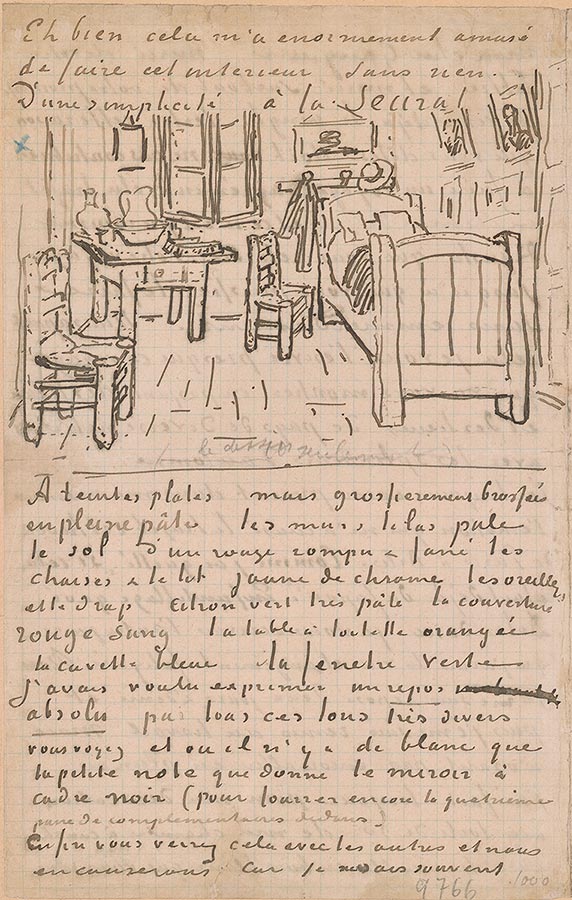
Vincent van Gogh, letter to Paul Gauguin, Arles, 17 October 1888, page 2
Thaw Collection, given in honor of Charles E. Pierce, Jr., 2007
Ah, well, it amused me enormously doing this bare interior.
With a simplicity à la Seurat. In flat tints, but coarsely brushed in full impasto, the
walls pale lilac, the floor in a broken and faded red, the chairs and the bed chrome yellow, the pillows
and the sheet very pale lemon green, the bedspread blood red, the dressing table orange, the
washbasin blue, the window green. I had wished to express utter repose with all these very different
tones, you see, among which the only white is the little note given by the mirror with a black frame
(to cram in the fourth pair of complementaries as well).
Anyway, you'll see it with the others, and we'll talk about it. Because I often don't know
© 2007 Van Gogh Museum, Amsterdam
Gauguin, page 3
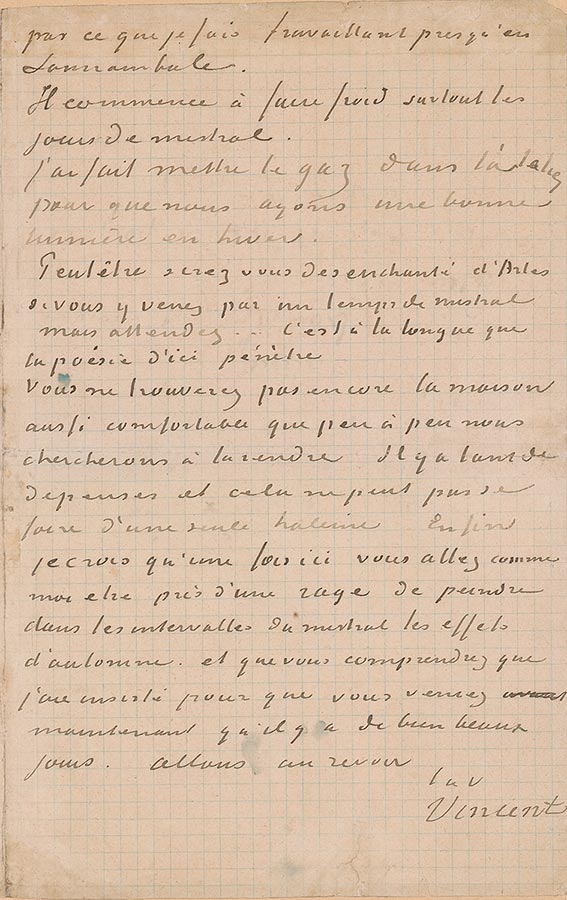
Vincent van Gogh, letter to Paul Gauguin, Arles, 17 October 1888, page 3
Thaw Collection, given in honor of Charles E. Pierce, Jr., 2007
what I'm doing, working almost like a sleepwalker.
It's beginning to get cold, especially on the days when the mistral blows.
I've had gas put in the studio, so that we'll have good light in winter.
Perhaps you'll be disillusioned with Arles if you come at a time when the mistral's blowing, but
wait. . . . It's in the long term that the poetry down here soaks in.
You won't find the house as comfortable yet as we'll gradually try to make it. There are so many
expenses, and it can't be done in one go. Anyway, I believe that once here, like me, you'll be seized
with a fury to paint the autumn effects, in between spells of the mistral. And that you will understand
that I've insisted that you come now that there are some very beautiful days. Au revoir, then.
Ever yours,
Vincent
© 2007 Van Gogh Museum, Amsterdam